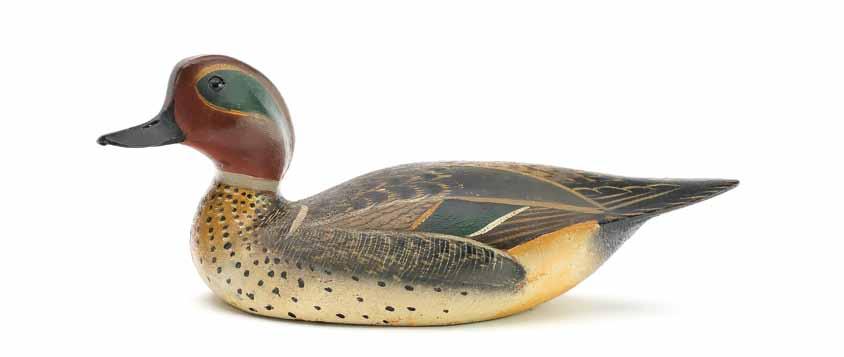Decoys and Sporting Art at Auction
July 25 & 26, 2025
Featuring Session II of the Ted and Judy Harmon Collection
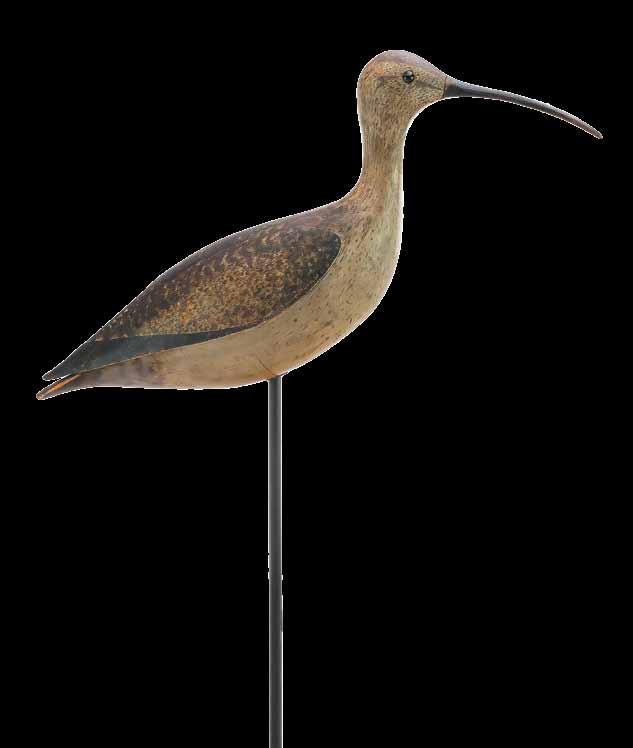

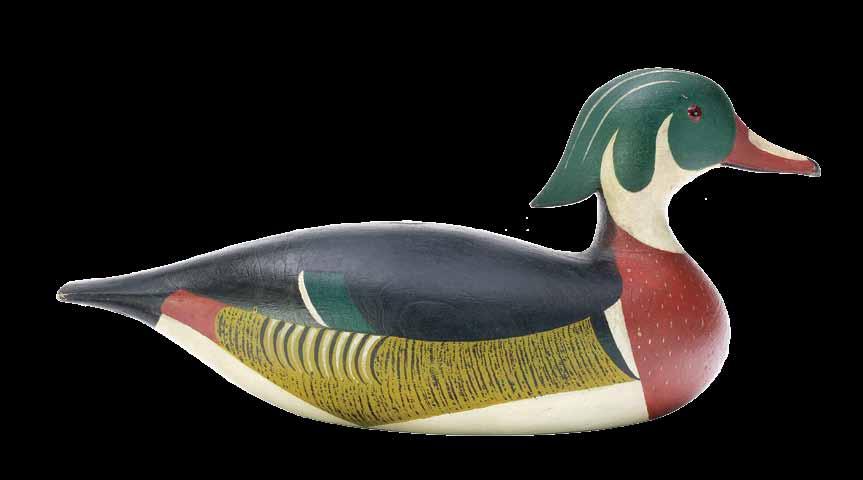
Early Challenge Grade Mason Factory Decoys from the Peter and Diana Bennett Collection
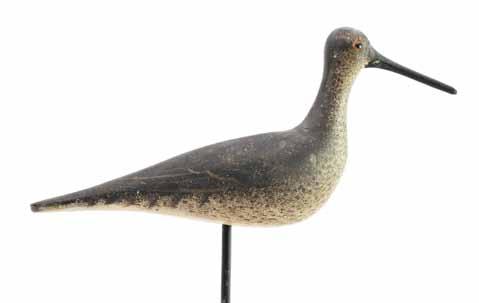
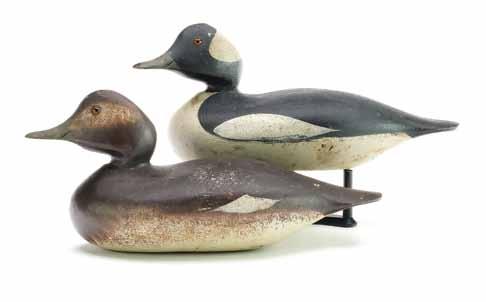
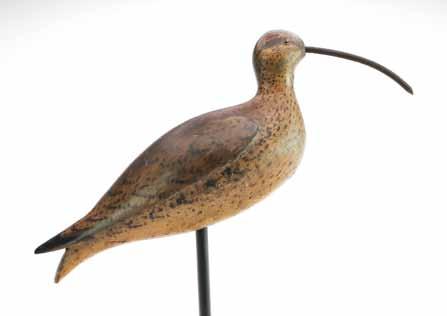
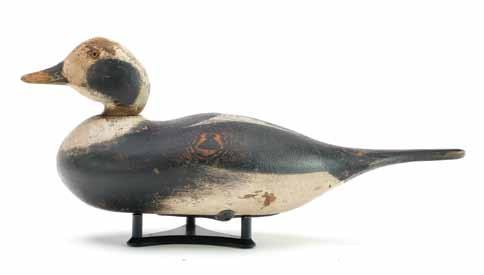
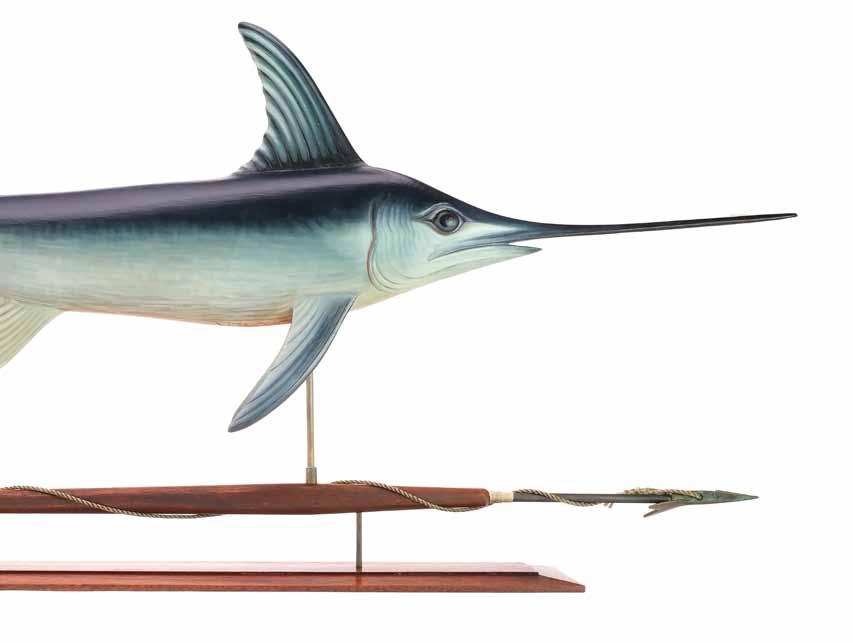
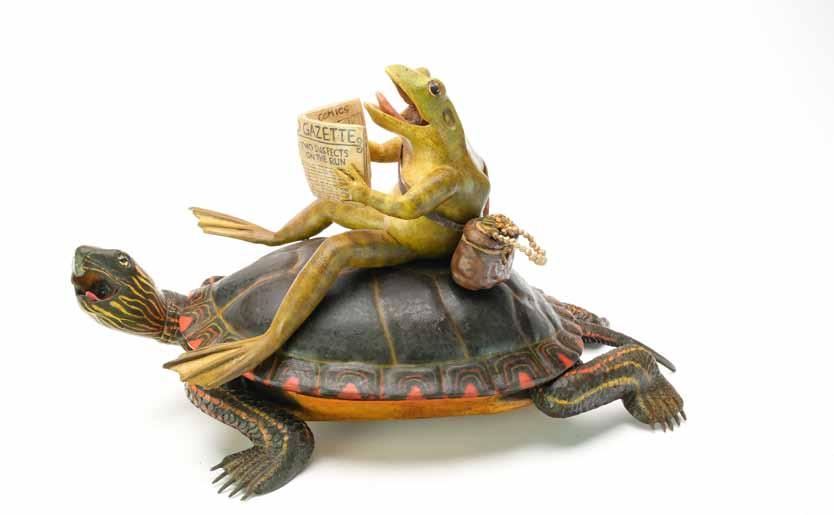
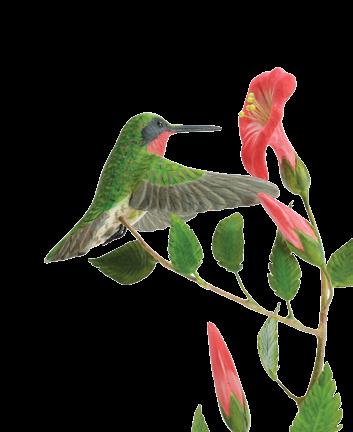
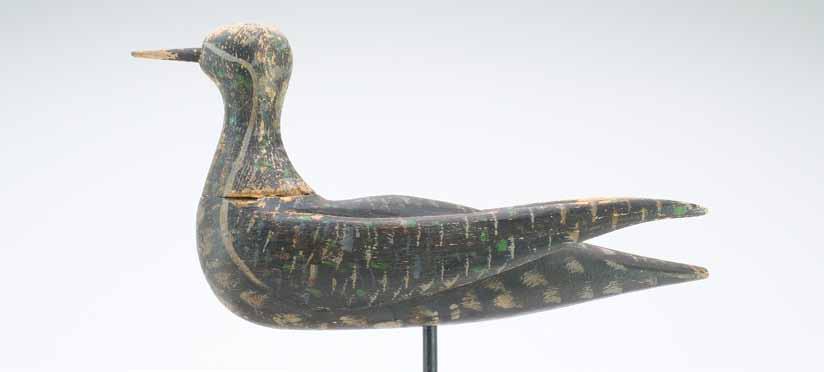


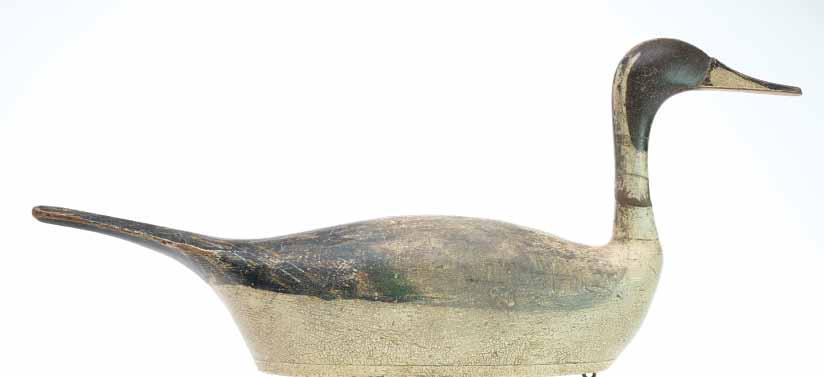

July 25 & 26, 2025
Featuring Session II of the Ted and Judy Harmon Collection



Early Challenge Grade Mason Factory Decoys from the Peter and Diana Bennett Collection











The live auction will be held at the The Country School 716 Goldsborough St Easton, Maryland 21601
Thursday, July 24, 2025
Cocktail Reception and Preview 5:00 PM - 7:00 PM EST
Friday, July 25, 2025
Preview 8:00 AM - 9:30AM EST
Auction 10:00 AM EST
Saturday, July 26 2025
Preview 8:00 AM - 9:30AM EST
Auction 10:00 AM EST
For questions during the auction call 410-745-0485
If you are interested in viewing a particular piece at the office, please call to be sure it will be available there at the time you plan to visit. We may also be in your area, and so a private viewing may be available. Please contact us for our schedule.
Catalog $45. Out of Country $70 Absentee, Phone & Online Bidding accepted call 410-745-0485 for arrangements
For free decoy appraisal contact: Jon Deeter | jdeeter@guyetteanddeeter.com | 440-610-1768
Zac Cote | zcote@guyetteanddeeter.com | 207-321-8091
Cooper Rossner | cooper@guyetteanddeeter.com | 609-560-8028

■ GUARANTEE - We have made a concerted effort to accurately catalog and describe the property to be sold. The decoys and paintings have guaranteed condition reports. Should the need arise, the auctioneer reserves the right to make verbal corrections and provide additional information from the block at the time of the sale. Absentee bids will not be executed on items that are found to be other than described in the catalog. Since opinions can differ, particularly in the matter of condition, the auctioneer will be sole judge in the matter of refunds. If we fail to identify a flaw that has an impact on the value, you can return the decoy.
■ DURATION OF GUARANTEE - Requests for a refund on an item purchased through a Guyette and Deeter, Inc. auction must be made within 3 days of the time you take physical possession of your purchases. Whether your items are shipped, delivered, or picked up at the auction site, it is still 3 days from date of possession. This guarantee is null and void if payment is received or mail is postmarked more than 30 days from the sale end date. The guarantee is also null and void if you choose to not take possession of your purchases within the 30 days. If you have paid for your purchases within the 30 days but Guyette and Deeter, Inc is unable to ship your item within the guarantee period, the guarantee will be extended until 3 days from the shipping delivery date. This policy protects our consignors by enabling us to make consignor payments in a timely manner.
■ Under no circumstances will we be responsible for damage to frames or glass, or damage caused by them. Paintings determined to be of high value or large size may be subject to special packaging at the buyers expense. Under no circumstances will we be responsible for damage to fragile decoratives. These items are marked in the catalog with an *.
■ Stands are not included with the decoys or weathervanes unless specified in catalog.
■ All duck calls have condition reports, but are sold “As Is”.
■ Trade Up Program - A limited number of decoys purchased may be paid for by consigning decoys. To participate, please contact our office ahead of time to discuss details.
■ Free appraisals are available with no obligation to consign and any correspondence is strictly confidential.
■ Pick up hours are 1pm – 5pm beginning July 30, or by appointment. Please call ahead so we can have your items ready.
September 12 & 13, 2025
Fine Sporting Arms
Chesapeake Bay Maritime Museum
St. Michaels, Maryland
November 15 & 16, 2025
Decoys, Sporting Art & Americana
The Country School Easton, Maryland
In conjunction with the Easton Waterfowl Festival
February 26, 2026
Fine Sporting Arms
Chesapeake Bay Maritime Museum
St. Michaels, Maryland


Josh Loewenstein er
F ine Sporting Arms Division Head
J. Wesley Dillon
Fir earms consultant


Jon & Leigh Ann Deeter
1210 S Talbot St, Unit A
St. Michaels, Md 21663
Tel: 440-610-1768
jdeeter@guyetteanddeeter.com

Lacey & Zac Cote PO Box 347
Freeport, ME 04032
Tel: 207-321-8091
zcote@guyetteanddeeter.com




Mike Stevenson
Graphic Designer
St. Michaels, Maryland
Tel: 410-745-0485
michael@guyetteanddeeter.com
Stormi Lind
Auction Manager
St. Michaels, Maryland Tel: 410-745-0485
auction@guyetteanddeeter.com


Ed Kenney
Merchandise Manager & Shipping
St. Michaels, Maryland
Tel: 410-745-0485
shipping@guyetteanddeeter.com
Cooper Rossner
Weekly Auction Manager
St. Michaels, Maryland Tel: 609-560-8028
cooper@guyetteanddeeter.com
Mike Roberts
Shipping
St. Michaels, Maryland
Tel: 410-745-0485
Noah Christopher Photography
St. Michaels, Maryland
Tel: 410-745-0485
photography@guyetteanddeeter.com


Michael Geleta
Finance Manager
St. Michaels, Maryland
Tel: 410-745-0485
billing@guyetteanddeeter.com
Bill Lapointe
Decoy Consultant and Essayist
Swansea, Massachusetts
Tel: 774-644-9426
Weekly Online Auctions Ending Every Thursday Night at 7pm est
Guaranteed condition reports, multiple photos, quick shipping and quality items. Bid with confidence.




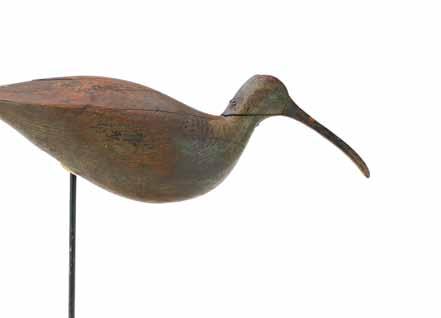




The best way to bid online at Guyette & Deeter auctions with the lowest platform fee availa ble : Sa ve up to 4% using our app!
Simply go to bid.guyetteanddeeter.com or use the QR code
Download the official Guyette & Deeter app:
• Bid on all of our live and online weekly sales.
• Search past sales in a large, ever growing prices realized database.
• Watch live streaming video from all of our live sales.

Bid in our live and online weekly auctions.
Search a huge, ever growing database of prices realized.




Scan QR code to download the Guyette & Deeter official App.

Jon Deeter • 440-610-1768
jdeeter@guyetteanddeeter.com
Zac Cote • 207-321-8091
zcote@guyetteanddeeter.com Cooper Rossner • 609-560-8028 cooper@guyetteanddeeter.com


With another Guyette & Deeter summer auction quickly approaching, we’d like to invite and encourage you to visit the eastern shore of Maryland and attend the only major live decoy auction of the summer. The opportunity to acquire rare and important works by major decoy artists, visit museums and historical places of decoy interest, and visit or support the many contemporary artists in the area, should be reasons enough to make the journey. Add in a complimentary harbor cocktail cruise aboard the Patriot, world class birding at Blackwater National Wildlife Refuge, and the many world-class fine and casual dining options of Bluepoint Hospitality in Easton, and that summer pilgrimage to the land of Michener is looking pretty appealing. So, if you have attended Guyette and Deeter auctions for years, we look forward to seeing you again, and if you have been participating via phone or the Guyette and Deeter app, consider attending this exciting live event in person, we’d love to meet you.
Within this catalog you will find an exciting mix of rare and important decoys and miniatures in many price points and from many different regions. Selections from the lifetime collections of Ted and Judy Harmon, Peter and Diana Bennett, Gene and Linda Kangas, Dan Graf, Chris Pitman, Len Carnaghi, and Dick Brust, provide opportunities for collectors of varying interests. So, spend time with and enjoy this catalog and if you have any questions or comments, please don’t hesitate to contact us.
We look forward to seeing you in Easton.
Friday, Jul 25, 2025
10:00


Saturday, July 26, 2025
10:00

Massachusetts native and lifelong resident Ted Harmon began collecting old waterfowl decoys after finding a derelict old Mason Factory decoy on a hunting trip to the Great Marshes of Barnstable as a young man. That chance discovery sparked a passion for carved wooden decoys that Ted and his wife Judy would build a life around.
By 1970 Ted had already begun traversing his native Bay State, buying, selling, and trading decoys. His collecting bug would take him to decoy shows and auctions around the country where he got to know and deal with collectors from other states. Judy Harmon recounts that she knew Ted had the bug when, with
two babies in diapers, she asked Ted to go to Sears and buy a clothes dryer with a new credit card they had received. When Ted returned home, he did not have a dryer but instead had bought two large boxes of decoys for resale at the local Richard Bourne auction. He did eventually sell those decoys for profit and bought Judy the clothes dryer.
In 1986 Ted and Judy, along with auctioneer Donald Moore of Delaware, held their first decoy auction leading up to the Easton Waterfowl Festival in Easton, Maryland. The partnership of Harmon and Moore did not last but Ted and Judy would go on to found and operate Decoys Unlimited, their own auction firm, for over 30 years. The auction company’s summer sales on Cape Cod were attended by collectors from around the country who would be treated to an annual lobster bake and an excellent offering of collectible decoys.

Over the years, the Harmon’s personal collection steadily grew into the most comprehensive grouping of decoys from Massachusetts that has ever been assembled. From Newburyport and the North Shore, through Cape Cod and the Islands, down to Westport and the South Coast, examples by many of the most sought-after carvers are represented in the Harmon collection. The histories of the decoys and the men who carved them, the rigs they were made for, or hunting stands they were used at, was always as important to Ted as the condition.
Though some decoys and shorebirds from the Harmon’s collection were periodically included in museum exhibits, various collector club displays, and decoy reference books over the years, the collection as a whole was never displayed together. The Harmon’s lived in the same Cape style home for 52 years and
never had adequate space to display such a large collection. Many stories abound about Ted’s safe deposit boxes and bank vaults that housed many of the Harmon’s best birds. Those stories are true.
When Judy and family began talks with Guyette and Deeter about offering the Harmon collection at auction, a public exhibition of the collection along with a printed exhibition catalog was a must. Rather than offering the collection in different auctions and only seeing a bit of the collection at a time, it was imperative to display the whole collection at once to really appreciate the scope of Ted’s life work. After many phone calls and emails to the different museums, starting in Massachusetts and working out from there, and faced with equal amounts of responses in the negative, Mike Tarquini, president of the Havre de Grace Decoy Museum in Havre de Grace, Maryland, said “absolutely we can dedicate that amount of space in that timeframe.” “The museum has been outstanding to work with and with such great leadership, we know there are many wonderful things to come for that institution,” says Jon Deeter.
The Ted and Judy Harmon collection was displayed together for the first time anywhere, at the Havre de Grace Decoy Museum from September of 2024 until May of 2025. The corresponding exhibition book, produced by Bill Lapointe and Mike Stevenson of Guyette and Deeter, is one of the most comprehensive histories of water fowling in Massachusetts and the carvers and decoys from that state ever published.
Guyette and Deeter is honored to have been chosen to offer the lifetime collection of Ted and Judy Harmon. Session II of the Harmon collection will be offered at Guyette and Deeter’s July 25th and 26th auction, held at The Country School in Easton, Maryland.









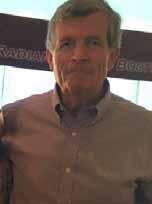
For Chris Pitman, decoy collecting was never just a hobby – it was a way of life, a window into the past, and a reflection of artistry, history, and heart. Each decoy in his care was more than an object – it was a story waiting to be told. Whether it was a Chauncey Wheeler Black duck, or a humble working decoy rescued from a barn sale, Chris treated each with reverence and joy. He saw beauty where others saw dust, history where others saw utility. Chris amassed a collection of more than a thousand decoys, and he could tell you when, where, and how he acquired each bird. Stories behind each acquisition.
Chris’s collection focused on upstate NY and Ontario decoys. Most prolific in his collection are Ken Harris birds. Harris’s carving began in the 1920’s and was driven by the desire to disprove the belief that Black ducks wouldn’t respond to decoys. His meticulously made decoys, particularly his non-decorative early birds, proved not only effective in the field but also showed his attention to detail. Chris bought his first Ken Harris decoy in 1952 at the age of 10 with the encouragement of his father. His lifelong admiration and study of Harris’s decoys was unparalleled. Ken Harris was an unimposing man who once told Chris he made decoys for 50 years and truly enjoyed being in his shop making decoys every single day. Toiling away at his bench, doing what he liked to do.
Chris was the go-to for anyone who wanted to learn about Ken Harris. He was quiet, unassuming, and a thoughtful student of all things Harris. He was often asked by people in the decoy community for his opinion on NY/Ontario birds, and most definitively, Harris birds.
Chris was an avid duck hunter, wetlands preservationist, and conservationist. Chris began volunteering with the DEC in the 1960’s and banded over 10,000 ducks in his lifetime, more than any other civilian in New York State. He was a proud member of TIDCA and sponsor of Havre de Grace Museum and Decoys Unlimited.


Dan was one of the more imposing and likable figures on the New England decoy scene for many decades. He was born in Newburyport, attended Valley Forge Military Academy and played football at Wake Forest University. What some erroneously perceived as his sometimes gruff exterior can, perhaps, be traced to his lifelong association with the hard working, 85 year old, family trucking business, Graf Brothers Trucking. In reality, Dan was a kind, friendly, gentleman who greatly enjoyed his time with family and a close circle of friends. His family, both on his, as well as his wife’s side, have historic roots in the waterfowling, fishing and shellfishing history of the Newbury and Plum Island marshes. His family hunted over a rig of Safford and Baumgartner decoys and his beloved wife, Janet, was born into the Rodigrass family who maintained a large and important hunting camp on the local marshes.
Dan enjoyed all aspects of his work and his hobbies and showcased momentos of each in his private “museum” which he called the “Joppa Senate”. This large building adjacent to his home, within a stones throw from Plum Island, housed a large and varied assortment of decoys, fishing and clamming memorabilia, racing outboard motors and their tiny toy counterparts, vintage model trucks, local indian artifacts, and the list goes on and on. All were welcome to visit the “Senate” and Dan was quick to make all feel at ease while enjoying his lifelong collection.
Perhaps his favorite collectible was his extensive grouping of decoys and miniatures by George Boyd (1873 – 1941) of Seabrook, NH. He was introduced to the carver by his close friend, “Greeny” Noyes, and went on to put together what was, undoubtedly, the most complete, and very finest known, collection of the carver’s work. Many of his decoys formed the nucleus of Jim Cullen’s “Finely Carved and Nicely Painted”, the definative reference on Boyd’s life for which Dan wrote the forward.
In addition to his love of collecting, Dan enjoyed carving and became quite accomplished at the craft, creating a wide range of very attractive ducks and shorebirds. In addition, his love of the Joppa section of Newburyport inspired him to play an active role in the 1988 – 1990 Joppa Arts Festival and, in 1999, he helped to organize a six month exhibition entitled “Decoys of the Newburys” which resulted in a booklet by the same name. He and Graf Bros Trucking donated a large storage unit to house the dismantled Crowell Barn on Cape Cod until it could be reassembled. He enjoyed his time with like minded collectors and, in 2010, when Cap Vinal was unable to host his well known annual summer after auction party, Dan and Janet stepped up to organize and hold the event at their home. The gathering was considered one of the highlights of the summer for the decoy community.
Dan’s greatest joy was his close family and the times spent with them at his lovely family compound in Newbury and at their waterfront home on Lake Sebago in Maine.
Guyette and Deeter is honored to have been chosen to assist in the dispersal of Dan’s beloved collection and the family hopes that the lucky future owners will cherish the pieces as much as Dan certainly did.
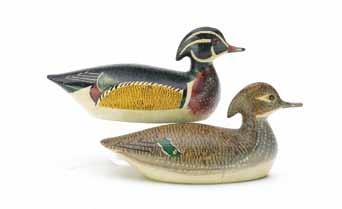


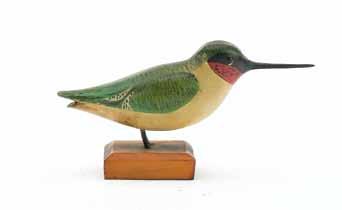

Session One • Friday, July 25, 2025 • 10:00am

By the early 1970’s, Ted had been actively seeking out decoys for quite some time. Initially, his search was somewhat confined to the nu merous sources that were available near his home on the Cape. Soon, however, his quest expanded in wider and wider circles to include the Islands and the South Shore. He eventually made the acquaintance of a dealer/picker in Hanover, a town just south of Boston and only about two miles from Lincoln’s home on Accord Pond (Hingham). This gentleman had a particular fondness for Lincoln decoys and had assembled quite the collection. He did not display the decoys but would occasionally show the birds to a few close associates. Among the group was a wood duck. For years, despite Ted’s badgering, he was adamant that he would not sell any of the Lincolns. Unfortunately, a bout of severe ill health resulted in his having to part with the decoys, and the majority of the Lincolns were purchased as a lot by an affluent surgeon from Brockton who also had a summer/retireme nt home in West Falmouth on the Cape. The wood duck was not included in the sale and its location was unknown. After the death of the collection’s original owner, his home was sold to another local antique dealer, Donald W Broman, Jr (1943 – 1993). Ted also knew this gentleman from his travels in the area. One day, he received a phone call from Broman informing him that he had found the wood duck tucked away somewhere on the property. A deal was struck, and the exceedingly rare woody has been a treasured focal point of the Harmon collection until today.


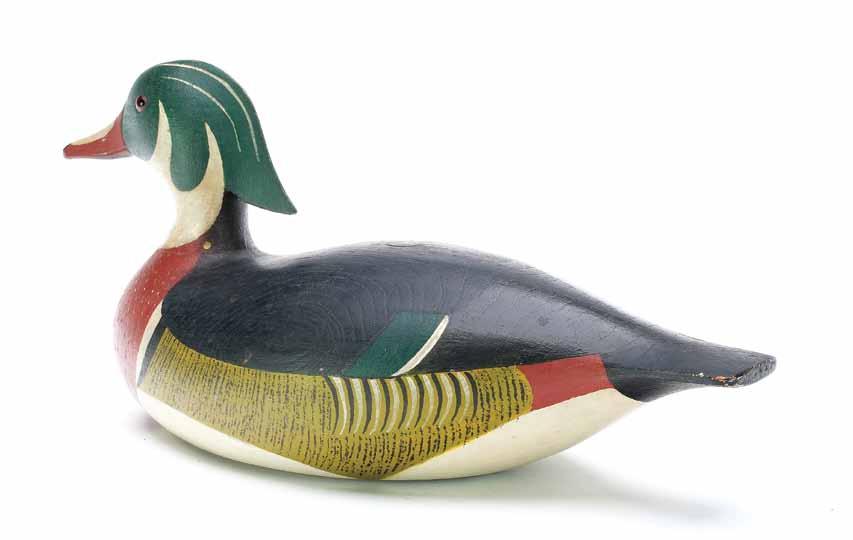


1 Joseph Lincoln (1859-1938), Accord, Massachusetts. Exceedingly rare wood duck drake with extended crest. Decoy was never rigged or weighted, and is painted identical to the maker’s miniature wood ducks. One of three full-size wood ducks by Lincoln in original paint. Measures 15.5” long. Near mint original paint with a few tiny rubs on bill tip and edge of tail; tight drying crack along the underside; small knot in back has risen very slightly.
Provenance: Ted and Judy Harmon collection.
Literature: “Josph W. Lincoln” by Cap Vinal, page 56, exact decoy pictured. (175,000 - 225,000)

Until the mid-1800’s, many residents of Massachusetts, as with others nationwide, viewed the natural resources that surrounded them as a bounty that was limitless, meant for their taking. Eventually, the folly of this perception became increasingly apparent, and groups of men and women began to join together to study their native flora and fauna to prevent its total destruction.
Boston and the towns immediately surrounding it were at the forefront of this early conservation movement and many of the most important and influential individuals and groups associated with it can be traced to that hub. Thoreau penned his now famous “Walden” in 1854, and this was one of the catalysts that led to the formation of organizations such as the Massachusetts Fish and Game Association and the Nutall Ornithological Club in 1873. In 1877, the Massachusetts Fish and Game Protective Association was established, followed by the Massachusetts Audubon Society in 1896. Many of these groups were closely aligned with the academic institutions in Boston, such as Harvard, but regional organizations also emerged. One of these was the Essex County Ornithological Club which was founded in 1916. These groups included some of the most wealthy and influential businessmen and outdoorsmen of the day, but membership was not limited to that social class. Numerous individuals from all walks of life began to take a serious interest in nature beyond its role as merely food or sport. One of these men was Fred Nichols.
Fred was a native of Lynn, a town immediately north of Boston. His was a hard working, blue collar family with a background in blacksmithing and horseshoeing. Fred followed in that trade until the late 1890’s when he switched to become a clerk, then salesman, at the Emerson Shoe Co. in downtown Lynn. He dabbled in real estate later in life and was listed as retired in the 1920 census.



Nichols joined the Essex County Ornithological Club probably at, or soon after, its formation. The group met at the Peabody Essex Museum in Salem and included well-known local sportsmen and artists such as Dr. John C. Phillips, Frank Benson and others. His membership allowed him access to the extensive collections at the Museum and, presumably, invitations to view various well curated, private collections of bird mounts and study skins. This, coupled with his deep interest in field ornithology, enabled him to create life like decoys that went far beyond what would have been merely necessary to lure passing birds into gun range. Today, his work, with its outstanding animated carving detail, and exquisitely painted plumage, ranks him as one of the very premier carvers of shorebirds in Massachusetts.
His decision to carve a long-billed curlew is another indicator of his wide-ranging interest in birds. During his lifetime, the specie’s population had been in a steady decline, and, by 1901, Howe and Allen reported them as being “a now rare or even accidental migrant (in



1A Fredrick Melville Nichols (1854-1924), Lynn, Massachusetts.
Outstanding and exceedingly rare curlew with deep relief wing carving and raised wing tips. Inserted metal sleeve in stick hole typical of the maker. Glass bead eyes and excellent paint detail. One of only two known. Measures 16” long. Excellent original paint with very minor wear; professional neck crack repair; front half of bill was professionally restored by Russ Allen; roughness on edge of tail with an old chip reset; a piece of wood was added between wing tips at some point to prevent damage.
Provenance: Ted and Judy Harmon collection.
Literature: “Massachusetts Masters” John Clayton, curator, Ward Museum of Wildfowl Art, page 21, exact decoy pictured. (80,000 - 120,000)

Elmer Crowell’s “Chip Carved Black Ducks”
Elmer Crowell (1862 – 1952) began carving about 1876 when, at age 14, he made nine decoys for use on his father’s property on Pleasant Lake. Soon his work became more widely recognized and he began to carve a few rigs for others. With time and effort, the quality of the carving improved immensely, and, by the turn of the century, he was approaching the peak of his creative greatness. Although a cranberry grower by trade, he had been selling decoys for some time but, by 1905, he mused “Why not make some good ones and charge accordingly” . What resulted were some of the very finest black ducks he ever created and, arguably, some of the most extraordinary working decoys ever carved anywhere in North America. Only an extremely limited number of these exceptional (so-called) “chip carved” rigs ever left his shop. The term “chip carved” has been used by collectors when referencing a series of design traits on the birds, in particular, the plumage texture beneath the tails, which Crowell highlighted by purposely leaving visible, numerous, small, knife marks in that area. In addition, each decoy featured what would become Elmer’s trademark crossed wing tips, a design feature which would remain for a period even after the chip carving was abandoned. Examples of this style from at least three different rigs are known (one of which was in very ill repair), and some students of Crowell have estimated that no more than five or six groups in this style, possibly even fewer, were ever made. These rigs were comprised of only a small number of birds, perhaps less than six, and each member of the group was designed to be in a different life like pose from its mates, with a few of the more elaborate examples boasting elevated wings. All sported better quality glass eyes than what
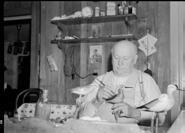

Crowell had been using and, finally, each received his finest wet on wet blended paint. The labor involved in these exquisite decoys proved to be quite time consuming and, within a short period, increasing orders, and other demands on his time, necessitated that the design be simplified. Various authors have dated their production period to between 1905 and 1910, with most dating them to 1905–1908. These decoys should be considered as “special orders” and, as such, were destined for only a few of his best customers, those individuals with the means to afford the very finest decoys. Today, Elmer’s “chip carved” decoys are considered to be some of his most coveted creations.

2 A. Elmer Crowell (1862-1951), East Harwich, Massachusetts. Early sleeping black duck with head turned as if bill is buried in back feathers. Deep relief carved, crossed wingtips and relief tail feather carving. Slightly oversized with chip carving under tail like others from the Mayo rig. Measures 16” long. Original paint with minor to moderate wear; roughness on edge of tail; area of touchup to flaking at center of one side; filler and touchup where head meets body.
Provenance: Hunting rig of Walter Howard Mayo. Ted and Judy Harmon collection.
Literature: “The Songless Aviary” Brian Cullity, curator, Heritage Plantation Museum, page 62, exact decoy pictured. “Decoys – A North American Survey” by Gene and Linda Kangas, page 90, exact decoy pictured. (50,000 - 80,000)





3 A. Elmer Crowell (1862-1951), East Harwich, Massachusetts. Early swimming black duck with deep relief carved, crossed wingtips and relief tail feather carving. Slightly oversized with chip carving on breast and under tail area like others from the Mayo rig. Measures 20” long. Original paint with minor to moderate wear; minor roughness on edge of tail and one raised wing; a few small dents in body; 1/3 of the bill is a professional replacement, with a crack repair slightly higher up on the bill; hairline crack on lower neck; some filler and touchup around neck seat.
Provenance: Hunting rig of Walter Howard Mayo. Ted and Judy Harmon collection.
Literature: “American Decoy: The Invention”, Peoria Riverfront Museum Exhibition book, page 42, exact decoy pictured. “Massachusetts Masters” John Clayton, curator, Ward Museum of Wildfowl Art, page 73, exact decoy pictured. “The Songless Aviary” Brian Cullity, curator, Heritage Plantation Museum, page 63, exact decoy pictured pictured. (40,000 - 60,000)

4

A. Elmer Crowell (1862-1951), East Harwich, Massachusetts. Rare surf scoter with slightly turned head. Maker’s oval brand on the underside, also branded “CM” for Clem Mayo of Orleans, Massachusetts. Measures 17” long. Original paint with minor to moderate wear; minor roughness on edge of tail; small dents and roughness on one side; head is slightly loose with separation at one side of neck seat.
Provenance: Ted and Judy Harmon collection. (15,000 - 25,000)



5 A. Elmer Crowell (1862-1951), East Harwich, Massachusetts. Early yellowlegs with relief wing and tail feather carving. Measures 11.5” long. Original paint with minor to moderate flaking on body and around eyes; hairline crack in top of bill; much of the paint has flaked off of the original hardwood bill.
Provenance: Ted and Judy Harmon collection.
Literature: “The Songless Aviary” Brian Cullity, curator, Heritage Plantation Museum, page 60, one of a pair pictured. (15,000 - 25,000)

6 A. Elmer Crowell (1862-1951), East Harwich, Massachusetts. Rare golden plover in running pose with relief wing feather carving. Two stick holes drilled in underside. Measures 12” long. Original paint with moderate gunning wear; hit by shot in one side; small wooden patch in one side near tail with an old nail to secure.
Provenance: Ted and Judy Harmon collection.
Literature: “The Songless Aviary” Brian Cullity, curator, Heritage Plantation Museum, page 61, exact decoy pictured. “American Vernacular: New Discoveries in Folk, Self-Taught, and Outsider Sculptures” by Frank Maresca and Roger Ricco, page 33, exact decoy pictured. (30,000 - 50,000)




In 1876, Elmer Crowell carved his first duck decoys for his own use on Pleasant Lake on Cape Cod. He occasionally also shot shorebirds at that location as well as on nearby Pleasant Bay. By 1884 he was gunning for the Boston market and “ - - - shorebirds, primarily yellowlegs, were the game at that time” . If he used shorebird decoys at that early date, it is unknown if they were by his own hand.
Eventually, he began to carve a few decoys for friends and associates. His earliest documented working shorebird is assigned a date of 1895. That bird, although beautifully executed, does not feature the pronounced split tail design seen on most later examples, nor does it carry the incised wing carving that would follow. By the early 1900’s his shorebirds had matured to the point where he was creating his finest examples as represented by his well-known “dust jacket” designs with their distinctive wing and tail detail. By the time of the “dust jackets”, it is important to note that Crowell was also placing greater emphasis on the bill carving to more accurately depict the actual birds. In “The Songless Aviary”, Cullity dates these exquisite sculptures to simply, “before 1918”. More recent authors have dated them more accurately to “c1910” with one dated “c1900”.
What shorebird design was Crowell employing between the dates of 1895 and 1900? Perhaps his miniatures provide a valuable clue. It is widely understood that his earliest minis were fashioned after his working decoys of the time. As noted by Joe


Ellis in “Birds in Wood and Paint”, “- - - they were tiny versions of his full-size decoys” . Among the earliest minis credited to Elmer are two sets of six miniature shorebirds, each dated c1901-1905. These examples even feature a single wire “leg” emulating the sticks that would have been used on actual decoys. Three birds in these sets feature Crowell’s distinctive “dropped wings”. The bill detail on these early examples simply consisted of a dowel-like stick, again mimicking what would have likely been used on the actual early decoys of the time. These carvings are all in very animated poses with the greater yellowlegs in one set being a near exact replica of the working dowitcher being offered here. When Ted and Judy Harmon sold these two sets of early Crowell miniature shorebirds in 2014, Ted wrote:
“All are carved as miniature versions of working decoys and the animated postures represented are identical to those seen on Crowell’s earliest working shorebirds. The exact dropped wing carving is seen on only a very few, very early, working shorebirds that many seasoned collectors agree predate the ‘dust jacket’ design used by Crowell pre-1918. It is very conceivable that this set represents a carving period even earlier than that ascribed to them”.
Since that sale, Ted and others felt very certain that this design most likely dates to the c1896-98 time period. If Crowell was carving these minis c1898, and if they were based on existing shorebird forms, then it would be logical that similar full-size decoys such as the dowitcher being offered here must predate or, at least, be contemporary to, the minis. Very few of this rare and very important early type are known. The bird being offered here was one of three that were used on Allen’s Pond, a salt pond and marsh on the Dartmouth/Westport (MA) line and then descended through the family.

7 A. Elmer Crowell (1862-1951), East Harwich, Massachusetts. Very early dropped wing dowitcher with relief carved wingtip feathers and uplooking head pose. Measures 13” long. Original paint with very minor wear; minor flaking on the bill; very small amount of touchup near each eye.
Provenance: Ted and Judy Harmon collection.
Literature: “American Decoy: The Invention”, Peoria Riverfront Museum Exhibition book, page 51, exact decoy pictured.
(20,000 - 30,000)

– 1980
The Folger name is almost synonymous with the Island of Nantucket. The family, along with the Starbucks, Coffins, Husseys a nd others, were all prominent members of the community during the whaling period. Franklin Folger Webster was born in central Massachusetts but his father died at only age 33 and, by the time Franklin was four he was living with his mother and sister in the home of his grandfather (Franklin Folger) on Nantucket. He married Emily Sykes Boody in 1925 and the couple raised three sons. By 1930. He had relocated to New Jersey and worked for the telephone company there until his retirement when he and his wife moved back to the Island. He eventually moved to Florida but, when he died, his remains were returned to Nantucket and he is buried in the Prospect Hill Cemetery there.
Nantucket is a relatively small, very insular community and the “old families” all knew each other and were aware of most of the activities in town. It is purely speculative, but perhaps because of the Folger family connections, Franklin F. Webster became aware of this rig of shorebirds and made them available to Mackey and O’Brien. If he (Franklin Webster) had actually used the rig it would have been for a very brief time in his early 20’s. His grandfather (Franklin Folger (1842 – 1918)) would have been active in the late 1800’s at the time of widespread shorebird shooting on the Island. Perhaps time and additional research may finally identify the true maker of these shorebirds . Until then, they will be enjoyed by a select few that are privileged enough to have them in their collections.


8 Unknown maker, circa 1860’s, Nantucket, Massachusetts. Extremely rare golden plover with applied wings and slightly turned head. Measures 10.5” long. Original paint with moderate flaking and wear on one side; significant flaking and wear on the other; small chips and roughness at neck seat; wings are intact and have never been damaged; tight drying cracks in breast.
Provenance: Franklin Folger Webster collection. Ted and Judy Harmon collection. (30,000 - 50,000)

“Quite a number of years ago, an antique dealer on the prowl down in Truro, Massachusetts, unearthed a group of seven shorebirds of which three were sleepers. Some years later, I made contact with his widow - - - . She did not know the story of the birds, but offered to let me buy a pair from the five she still owned” - 1975 George Ross Starr
Doc Starr’s quote that they were unearthed “quite a few years ago” would suggest that decoys by this maker first surfaced in the late 1950’s or early 1960’s. He pictured his two decoys in Figure 33 in “Decoys of the Atlantic Flyway” where he labeled them as “ - - - by an unknown maker ”. Shortly afterwards they were falsely attributed to Elmer Crowell by other authors. For the next 30 or 40 years or so, the actual maker remained shrouded in mystery until the early 1990’s when Ted Harmon received a tip concerning a lady with a “rather nice sleeping decoy” . The lady turned out to be the niece of Melvin Gardner Lawrence. The family had only vague information on Melvin, such as his approximate birth and death dates and that “he was from Revere and his work kept him around the beach area” . Fortunately, they had kept the decoys carefully wrapped in a chest since his death.
Over the years, the story began to emerge. Lawrence was the manager of the beach bathhouse at Nantasket (Hull) and was later transferred to the State Beach in Revere where he had resided since at least 1896. In the early 1900’s both of these beaches were extremely popular with Boston residents looking to escape the heat, grime, and congestion of the city. Recreational development at both locations rapidly obscured the sand under a mantel of boardwalks, concessions and parking lots, certainly not habitat condusive to shorebird shooting. Lawrence’s niece had related to Ted Harmon that the men in the family were “avid outdoorsmen ” and that “ shorebird hunts often took them south to Cape Cod where the family owned a hunting camp in the mid Cape area ”. The family was fairly well off with the father, David







(1828 – 1917) being a physician, and Melvin’s brothers being accomplished tradesmen. Ted would ultimately discover that the hunting camp was in the Punkhorn section of Brewster, reasonably close to Truro where Starr had first discovered his examples. Traveling from Boston to the Cape in the early 1900’s would have been a long, tedious, bumpy adventure. Once there, decoys needed to be transported by hand in baskets or bags over some distance to the chosen gunning location. Breakage would have been a constant concern. Lawrence solved the problem in his own, unique manner. His carving material of choice was some form of dense wood which, although harder to carve, would prove more durable. The problem of the fragile bills becoming damaged was rectified by having much of the rig positioned in a sleeping posture. The entire bird was carved from one piece of wood with the bill resting on the back for protection. Likewise, birds other than the sleepers, were represented as runners or feeders which allowed Lawrence to align the grain more closely over the length of the decoy thus reducing neck breakage. His tails were split but were just thick enough to resist chipping. His posing of the decoys, coupled with their beautifully painted surfaces, produced an animated rig of birds that were viewed as actively feeding or at complete rest. The appearance of the spread to incoming birds must have presented a very reassuring sight.
The niece’s statement that “the family hunted on the Cape” and that the surviving rig contained species such as willets and “peeps”, which were outlawed in 1918, opens the possibility that the decoys may have been carved prior to 1918 by Melvin’s father who died in 1917.
The fact that at least a portion of the family rig has survived intact over 100 years is remarkable and we can only thank Melvin’s niece for keeping them “ carefully wrapped and hidden in a blanket chest” until they were acquired by Ted Harmon.



9
Melvin Gardner Lawrence (1880-1930), Revere, Massachusetts. Sleeping yellowlegs with glass eyes and split tail carving. Mackey collection ink stamp on the underside. Measures 9.5” long. Original paint with minor discoloration and wear; structurally excellent.
Provenance: Ted and Judy Harmon collection.
Literature: “Decoys of the Atlantic Flyway” by Dr. George Ross Starr Jr., page 84, exact decoy pictured. (25,000 - 35,000)


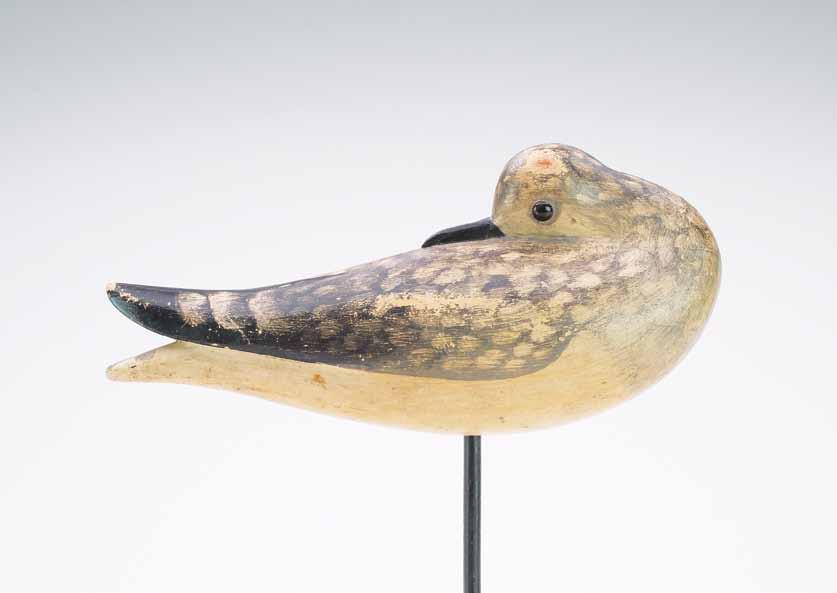

9A Melvin Gardner Lawrence (1880-1930), Revere, Massachusetts. Sleeping plover in winter plumage. Glass eyes and split tail carving. Measures 9” long. Original paint with moderate wear; shallow dent near stick hole, otherwise very good structurally.
Provenance: Ted and Judy Harmon collection. (20,000 - 30,000)


Provenance: Ted and Judy Harmon collection. (6,000 - 9,000)

10 Unknown maker, 19th century, Massachusetts. Excellent golden plover in winter plumage. Thinly hollowed two piece body and outstanding paint detail. Measures 11” long. Original paint with minor flaking and wear; lightly hit by shot; tiny amount of glue visible where the original bill meets the face.
Provenance: Ted and Judy Harmon collection. (20,000 - 30,000)

Remarkably, one of the Island’s most famous decoy carvers did not consider this gift noteworthy and certainly not his greatest accomplishment. Rather, his first love was raising poultry.
In Chadwick’s day, the production of chickens was a necessity for meat and eggs, and poultry farms were a common sight throughout the region. Similarly, the raising of “fancy fowl” was a widespread popular hobby and business. After high school on the Island, Keyes attended New York State Agricultural College and returned to the Vineyard to begin his own flock. In 1893, he wed local Chilmark girl, Lydia Stephen Pease, while he worked in Oak Bluffs as a carpenter. He was always fond of chickens. About 1904, his dream seemed to be fulfilled when he was hired by the large Owen Poultry farm at Lamberts Cove in West Tisbury. Unfortunately, his efforts in this regard did not prove sufficiently lucrative and, other than a brief period around 1910 when he worked as a fisherman, for most of his life he relied on his skill as a carpenter and his ability to execute fine Spenserian penmanship to support his family. By 1940, at the age of 75, he was transitioning into retirement, and he listed his occupation as farmer, presumably with a few of his beloved chickens.
He made his first decoys about 1881 when he was sixteen. When he started to sell his wares, his early work showed the strong influence of his neighbor Ben Smith (1866 – 1946) however, being the perfectionist he was, Chadwick was constantly adapting his patterns to improve the final product. It is estimated that his lifetime production numbered about 2000 pieces, but he may have done more. He and Lydia lived practically their entire wedded lives on Circuit Avenue, just on the
outskirts of the religious “cottage city” and very near the ferry landing. His shop was in the basement of his home and when the weather permitted, he would carve under a grapevine in his rear yard.
Chadwick, like so many of the Vineyard men, did some waterfowl hunting but he much preferred following his small pack of beagles in pursuit of the abundant rabbits on the Island. Ham Luce (1905 – 1998) hunted rabbits and fished with Chadwick and, like so many others who knew him, remembers him as saying: “ You know – I never wanted to be known as a master carver, I was an expert poultryman” . He and his wife had no children, and they are buried in her childhood town of West Tisbury.





11 Keyes Chadwick (1865-1958), Oaks Bluff, Massachusetts. Excellent rigmate pair of mergansers with slightly turned heads. Measure 17.5” and 18.5” long. Original paint with fine crazing and minor wear; some scattered paint rubs and dents; slight separation at hen’s neck seat.
Provenance: Ted and Judy Harmon collection.
Literature: “Massachusetts Masters” John Clayton, curator, Ward Museum of Wildfowl Art, page 68, exact decoy pictured. (12,000 - 18,000)
12 Keyes Chadwick (1865-1958), Oaks Bluff, Massachusetts. Rare working brant with round inlayed lead weight. “TSH” stamped in underside for Theodore Steven Harmon. Measures 18.5” long. Original paint with minor wear under a thin coat of varnish that has darkened with age; drying split in the underside; minor flaking around eyes; slight separation at neck seat.
Provenance: Ted and Judy Harmon collection.
Literature: “The Great Book of Wildfowl Decoys”, Joe Engers, Editor, page 61, exact decoy pictured. “Massachusetts Masters” John Clayton, curator, Ward Museum of Wildfowl Art, page 69, exact decoy pictured. (8,000 - 12,000)

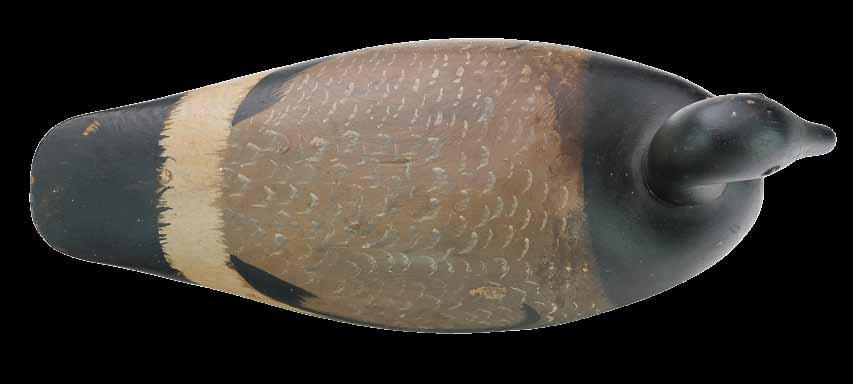
13 Keyes Chadwick (1865-1958), Oaks Bluff, Massachusetts. Goldeneye with slightly turned head. Round inlayed lead weight. “CSA” branded on underside. Measures 14.25” long. Original paint with very minor wear; tight crazing to black on back; area of filler on one side of head from when the decoy was made; drying crack along the underside.
Provenance: Ted and Judy Harmon collection. (2,000 - 3,000)
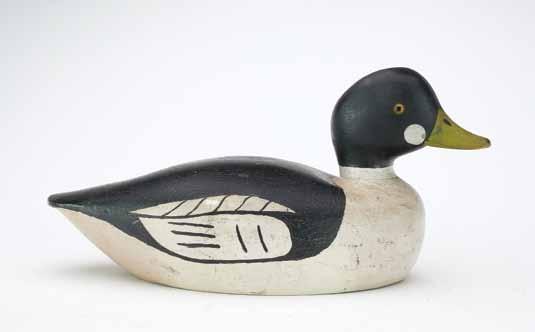
14 Keyes Chadwick (1865-1958), Oaks Bluff, Massachusetts. Pair of redheads. Hen with tucked head. Both with round inlayed weights in underside. Measure 14.5” and 15.25” long. Original paint with minor gunning wear; surface is darkened with age; each with a drying crack along the underside.
Provenance: Ted and Judy Harmon collection. (3,000 - 5,000)

15 Keyes Chadwick (1865-1958), Oaks Bluff, Massachusetts. Rare widgeon hen with slightly turned head and round inlayed weight in the underside. Measures 15.25” long. Original paint with minor gunning wear; old chip in one side of tail; roughness on tip of bill with small loss of wood on underside; drying crack along the underside.
Provenance: Ted and Judy Harmon collection.
Literature: “Decoys – A North American Survey” by Gene and Linda Kangas, page 99, exact decoy pictured. (2,000 - 3,000)


16 Joseph Lincoln (1859-1938), Accord, Massachusetts. Classic brant. Measures 19.75” long. Original paint with minor gunning wear; minor roughness on edges of tail; typical drying split along the underside; professional neck crack repair at upper part of neck.
Provenance: Ted and Judy Harmon collection.
(10,000 - 15,000)




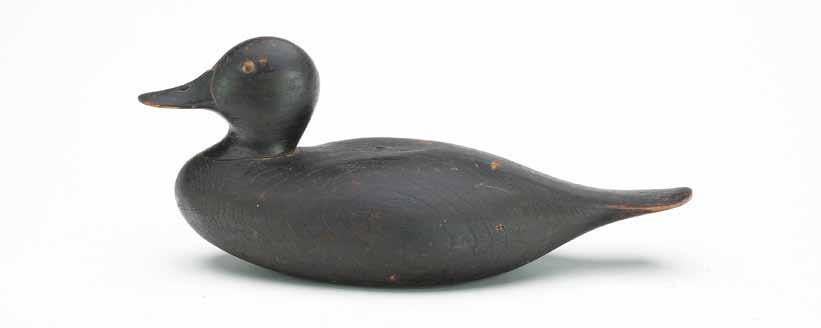

17 Joseph Lincoln (1859-1938), Accord, Massachusetts. Very rare rigmate pair of goldeneye. Relief shoulder carving and tack eyes. Illegible rig stamps on the undersides. Measure 13.5” long. Original paint with moderate flaking and wear; minor roughness on edge of tails; lightly hit by shot; half of drake’s bill and a chip on top of head was professionally restored.
Provenance: Ted and Judy Harmon collection.
Literature: “Josph W. Lincoln” by Cap Vinal, page 53, exact pair pictured. “Decoys – A North American Survey” by Gene and Linda Kangas, page 92, exact hen pictured. (6,000 - 9,000)
18 Joseph Lincoln (1859-1938), Accord, Massachusetts. Rare ruddy duck with slightly reared back head and brass tack eyes. This exact decoy was used on the 1985 Massachusetts duck stamp. Measures 12” long. Original paint with moderate wear; lightly hit by shot; typical drying split on the underside; chip in one side of tail and one side of bill tip were professionally restored
Provenance: Ted and Judy Harmon collection. (4,000 - 6,000)

20 Joseph Lincoln (1859-1938), Accord, Massachusetts.
Hollow carved self bailing scoter with chamfered bottom board. Measures 18.5” long. Original paint with moderate gunning wear; lightly hit by shot; drying crack along one side; small chip on edge of bottom board near breast.
Provenance: Ted and Judy Harmon collection.
(2,000 - 4,000)
19 Joseph Lincoln (1859-1938), Accord, Massachusetts.
Canvas over wood frame scoter with tack eyes. Measures 17.5” long. Original paint with very minor wear; one shot strike on head; otherwise excellent structurally.
Provenance: Ted and Judy Harmon collection.
(2,000 - 4,000)


21 Joseph Lincoln (1859-1938), Accord, Massachusetts.
Classic oversized black duck with reared back head and slight shoulder carving. Mackey collection ink stamp on the underside. Measures 18” long. Original paint with moderate flaking and wear; small dents in one side; typical drying split along the underside that runs up the breast slightly; minor separation at neck seat.
Provenance: : William J. Mackey Jr collection. Ted and Judy Harmon collection.
(5,000 - 8,000)
22 Clarence Bailey (1882-1952), Kingston, Massachusetts. Rigmate pair of oversized mergansers. Slight relief wingtip carving and drake with extended crest. Measure 22.5” long. Original paint with minor flaking and wear; small chip at tip of drake’s crest; drake’s eyes appear to have been replaced with touchup to the filler around eyes.
Provenance: Ted and Judy Harmon collection.
Literature: “American Vernacular: New Discoveries in Folk, SelfTaught, and Outsider Sculptures” by Frank Maresca and Roger Ricco, page 36 and 37, exact decoys pictured. (12,000 - 18,000)
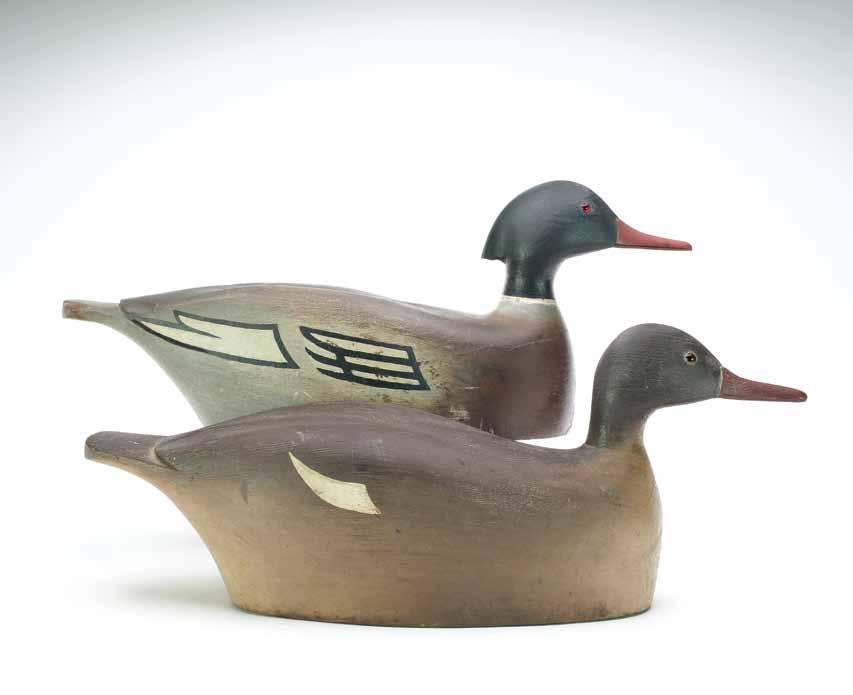



A. Elmer Crowell (1862-1951), East Harwich, Massachusetts. Excellent brant with applied bill typical of this style. Maker’s oval brand on the underside. Measures 18” long. Original paint with very minor wear; minor roughness on edge of tail; drying crack along the underside; hairline separation and cracks to filler at neck seat.
Provenance: Ted and Judy Harmon collection. (15,000 - 25,000)
24

A. Elmer Crowell (1862-1951), East Harwich, Massachusetts. Rare rigmate pair of hollow carved goldeneyes. Relief carved, crossed wingtips and tail feather carving. Maker’s oval brand on the undersides. Measure 13” and 13.75” long. Original paint with moderate flaking and wear under an early coat of varnish; small dents and shot marks; hairline crack in each neck; wood putty used to repair a chip in drake’s tail and bill; roughness on edge of hen’s tail and bill with small amount of touchup to bill.
Provenance: Ted and Judy Harmon collection.
(10,000 - 15,000)





26 A. Elmer Crowell (1862-1951), East
Harwich, Massachusetts. Early scoter with relief carved, crossed wingtips and tail feather carving. Underside likely had maker’s oval brand, but much of the underside has been planed down. Measures 16.25” long. Original paint with moderate flaking and wear; hit by shot; roughness on edge of tail; professional repair to chip in one side of neck; some glue visible at neck seat.
Provenance: Ted and Judy Harmon collection. (5,000 - 8,000)
27 A. Elmer Crowell (1862-1951), East
Harwich, Massachusetts. Canada goose weathervane. Slighty raised wingtips and large brass tack eyes. Measures 25” long. Original paint with moderate flaking and wear from exposure to the elements; a few small chips and shot marks in body; thin loss of wood on one side of neck; minor roughness on tip of bill.
Provenance: Ted and Judy Harmon collection. (4,000 - 6,000)


28 A. Elmer Crowell (1862-1951), East Harwich, Massachusetts. Excellent decorative bluejay with acorn in its beak. Maker’s oval brand on the underside. Measures 10.25” long. Excellent original paint with almost no wear; minor discoloration on base; one jesso toe was professionally restored; small nail hole in front of base where it was secured to a shelf.
Provenance: Ted and Judy Harmon collection. (15,000 - 25,000)


Charles Frederick Coffin (1835-1919), Nantucket, Massachusetts. Large curlew with two piece head and body. Measures 15.25” long. Original paint with minor to moderate wear; significant flaking to the original hardwood bill; tiny chip on the underside of bill tip and a fine hairline crack on top of bill; separation at neck seat; with a tiny chip at back of neck seat.
Provenance: Ted and Judy Harmon collection. (12,000 - 18,000)


Unknown maker, 19th century, Massachusetts. Very thinly hollowed eskimo curlew with split tail carving and inlayed metal sleeve in stick hole. “JFN” carved in underside. Measures 12.5” long. Original paint with minor to moderate flaking; an early coat of varnish has caused a very appealing tightly crazed surface; filler around the eyes has been replaced.
Provenance: Ted and Judy Harmon collection.
Literature: “The Great Book of Wildfowl Decoys”, Joe Engers, Editor, page 57, exact decoy pictured. (8,000 - 12,000)
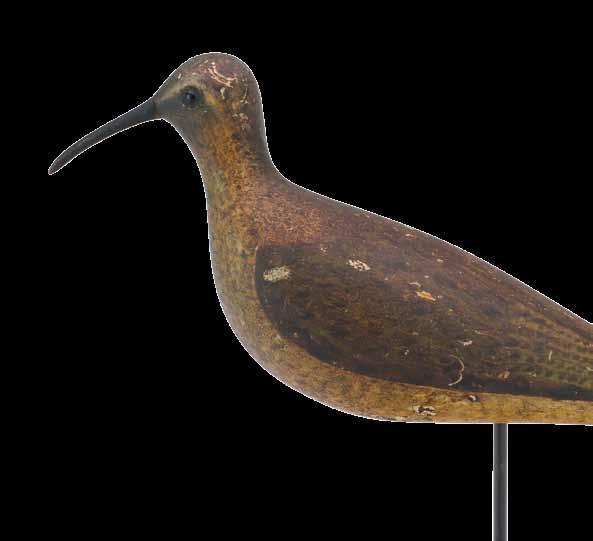



Born in rural Plympton, little is known of Holmes’ early years until 1848 when he married Elizabeth H. Washburn in Kingston, a town just to the east of his birthplace. By that time, he was listed as a “furnaceman”. Kingston had a thriving forge and foundry industry that took advantage of the abundant local sources of bog iron to produce everything from nails to axes and ships anchors and Lothrop would spend the next 22 years of his life employed in that trade. Until 1856/57 he worked in Kingston, likely at the Triphammer Forge. In 1857, the family relocated to Providence, RI where he worked at the huge Phenix Iron Foundry. When his mother died in 1870, Holmes inherited his childhood farm and that, coupled with his home in Kingston and another coastal property at Brant Rock, placed him in a position of some relative wealth and he appears in the 1870 Federal Census as a “gentleman”. Various city directories and census records indicate that by 1880 he had returned to his earlier occupation as a moulder. What he did for the next few years is unclear but research by Gigi Hopkins reveals that in 1887 he was made a Trustee of the nearby Evergreen Cemetery and the 1890 Kingston City Directory listed him as “Superintendent – cemetery”. Evergreen Cemetery (est 1853) is one of the first rural, landscaped, so-called Garden Cemeteries in the US. These were a distinct departure from the rigid, overcrowded, church graveyards of the day. Their focus was on undulating natural landforms, mature native plantings and an overall curvilinear network of roadways, all meant to inspire quiet meditation. His wife passed away in 1896 and, three years later, Lothrop died from senile dementia and exhaustion at the Westboro Insane Hospital.
His move from being a hot, gritty, foundry worker to Garden Cemetery Superintendent is somewhat indicative of his aesthetic preferences, and Holmes’ love of the outdoors undoubtedly made the transition a rather easy one. He had always been an enthusiastic hunter and his elaborate mahogany gunning box, which closely resembles a chest for




distant from the nearby coast of Kingston Bay. All of his shorebirds must be considered rarities. Ms Hopkins has only identified “perhaps two dozen yellowlegs” but only “one golden plover”. The feeding yellowlegs being offered here is distinctive in its design and the plover, is one of only two known in original paint.

His simple obituary, which was published in the October 14, 1899 issue of the Old Colony Memorial, succinctly describes this unassuming, yet extremely talented pilgrim descendant:
“Mr. Holmes was born and spent most of his life in Kingston, except when following his trade, a molder, at Providence, R.I. He also worked at factories here. Mr. Holmes was for many years superintendent of Evergreen Cemetery, resigning a few years ago. He lived a quiet life, and was respected by the community at large. He was passionately fond of instrumental music, the banjo being his favorite. Mr. Holmes was a widower, his wife having died several years ago. He was a mason”.

31 Lothrop Holmes (1824-1899), Kingston, Massachusetts. Rare feeding yellowlegs with tack eyes and split tail carving. Measures 13” long. Original paint with very minor wear; old chip in underside of raised wingtip; small amount of roughness on edge of stick hole; bill is an early professional replacement.
Provenance: Ted and Judy Harmon collection. (20,000 - 30,000)


Lothrop Holmes (1824-1899), Kingston, Massachusetts.
Excellent and extremely rare golden plover with split tail carving and painted eyes. One of two known examples. Measures 10.5” long.
Original paint with very minor wear; a few small shot strikes; bill is an early replacement.
Provenance: Ted and Judy Harmon collection. (12,000 - 18,000)

Few in the world of waterfowling have wider name recognition than Dr. Phillips. Born into wealth as a member of Boston society, he attended Harvard and received his medical degree from there in 1904, but never practiced medicine professionally. Instead, he enjoyed a leisurely sporting life, hunting and fishing with similarly minded affluent sportsmen at numerous locations throughout New England and beyond. He is well known for his numerous publications that document many of these exploits. He is probably best known for his love of “stand gunning”, not only at his own property at Wenham Lake but at numerous other locations statewide. Understandably, a review of the records clearly indicates that few shorebirds were actually shot at these stands. Beginning in his college years, however, he frequented the shorefront and marshes of Cape Cod, the Islands, and the north shore in active pursuit of shorebirds. It is the opinion of many that it was on one or more of these trips that he acquired the wonderfully carved decoys that, although by an unknown hand, are now collectively known as the “Phillips rig” birds.



33 Unknown maker, 19th century, North Shore, Massachusetts. Rare feeding dowitcher with tack eyes and slit tail carving. Measures 10.25” long. Original paint with moderate wear; very lightly hit by shot; a few small spots of touchup on body; bill is a professional replacement by Cameron McIntyre.
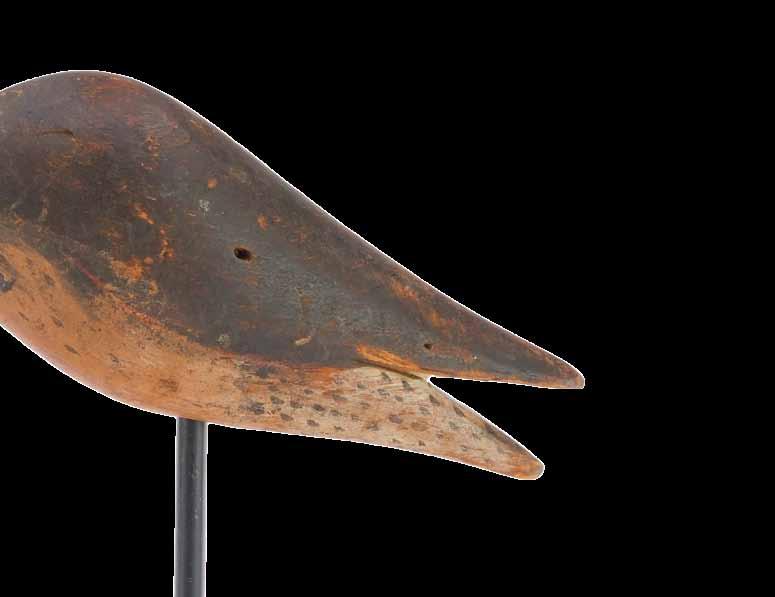
Provenance: Ted and Judy Harmon collection. (30,000 - 40,000)


Unknown maker, 19th century, North Shore, Massachusetts. Rare feeding dowitcher from the rig of Dr. John C. Phillips. Relief wing carving and raised wingtips. Carrying hole drilled through tail. Measures 10.25” long. Original paint with moderate wear, down to bare wood in areas; lightly hit by shot; bill is an early replacement with glue visible where it meets the face; professional restoration to both raised wingtips.
Provenance: Ted and Judy Harmon collection. (10,000 - 15,000)


34A “Coot Shooting”, 19th century, unknown artist, Massachusetts. Oil on canvas. Image measures 19.5” x 23.5”. Canvas has been relined and tightened; inpainting has stabilized crazing throughout; conservation stickers on back indicate painting was restored by Copley Fine Arts, Newburry St. and also Cape Cod Picture Framing and Restoration; under UV light an expected amount of inpainting can be seen; mostly following some of the longer crazing marks that have been conserved.
Provenance: Harry V. Long collection. Cap Vinal collection. Ted and Judy Harmon collection. (10,000 - 12,000)
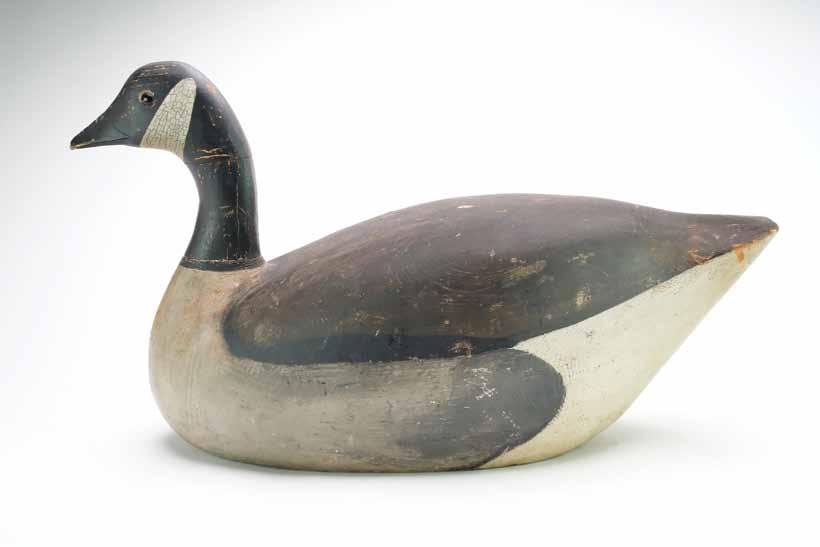
35 Frederick Baumgartner (1879-1959), Newburyport, Massachusetts. Large Canada goose with slightly raised neck seat and two piece head and neck. “IV-I” branded on underside. Measures 29” long, 11” wide. Original paint with moderate flaking and wear; split along one side, otherwise very good structurally.
Provenance: Ted and Judy Harmon collection. (12,000 - 18,000)

36 Captain Samuel Fabens (1814-1899), Marble Head, Massachusetts. Goldeneye hen with wooden keel. Solid body. Measures 13.25” long. Original paint with moderate flaking and wear; mostly around center of decoy; drying crack along the underside; old filler added to a small chip at center of tail; some old glue visible at neck seat; tight crack in back of head; one eye is missing.
Provenance: Ted and Judy Harmon collection.
Literature: “The Great Book of Wildfowl Decoys”, Joe Engers, Editor, page 45, exact decoy pictured. “Massachusetts Masters” John Clayton, curator, Ward Museum of Wildfowl Art, page 10, exact decoy pictured. “Decoys –A North American Survey” by Gene and Linda Kangas, page 94, exact decoy pictured.
(1,500 - 2,500)


38 Unknown maker, 19th century, Boston Harbor, Massachusetts. Appealing long-tail duck with large neck seat. Appears to have had two applied tail sprigs that are now missing. Measures 11.5” long. Original paint with moderate flaking and wear; fine crazing on much of the decoy; lightly hit by shot; two chips on top of tail, likely where tail sprigs broke away.
Provenance: Ted and Judy Harmon collection. (2,000 - 4,000)
37 Unknown maker, early 20th century, North Shore, Massachusetts. Nicely carved scoter hen with raised neck seat, deep relief wing carving, and inserted metal keel. Measures 14.75” long. Original paint with minor wear; small dents and shot marks; thin wash of white on wing patches.
Provenance: Ted and Judy Harmon collection. (2,500 - 3,500)

39 Fred Nickerson (1902-1980), Falmouth, Massachusetts and Villagedale, Nova Scotia. Pair of hollow carved red-breasted mergansers with relief wingtip carving and inserted horse hair crest. Drake with slightly turned head. Measure 19.5” long. Original paint with minor flaking and wear; filled crack in drake’s bottom board; crack through drake’s neck; hairline crack in one side of hen.
Provenance: Ted and Judy Harmon collection. (5,000 - 8,000)




40 Unknown maker, 20th century, Massachusetts. Hollow carved greenwing teal with inalyed neck seat and tack eyes. Inlayed lead weight on underside. Measures 10.75” long. Mostly original paint with moderate gunning wear; very early second coat over an area of comb paint detail on wings; minor roughness on edge of tail; crack through neck was secured with a few small nails.
Provenance: Ted and Judy Harmon collection. (3,000 - 5,000)
41 Charles Hart (1862-1960), Gloucester, Massachusetts. Hollow carved black duck with relief wing feather carving. Two piece body was hollowed from the underside. Measures 17.5” long. Original paint with very minor wear; slight separation at neck seat; hairline crack in one side of neck.
Provenance: Ted and Judy Harmon collection. (3,000 - 5,000)


42 A. Elmer Crowell (1862-1951), East Harwich, Massachusetts. Yellowlegs with split tail carving and tack eyes. Muller collection ink stamp on underside. Measures 12.25” long. Original paint with fine crazing on back and virtually no wear; tiny blunting on tip of raised wingtip.
Provenance: Dr. Peter and Peggy Muller collection. Ted and Judy Harmon collection. (10,000 - 15,000)


44 Unknown maker, Massachusetts, 2nd half 19th century. Hollow carved black bellied plover with glass eyes and split tail carving. An elongated stick hole with a specific stick made for this decoy, which has a nail inserted at tip of stick so that the bird can be placed in a few different positions. Formerly in the Joe French collection, both stick and decoy are stamped JB French. Measures 11” long. Original paint with minor wear; bill appears to be an early working replacement; small area of restoration on one side near tail; a few small chips missing at top of tail were probably darkened a long time ago; Joe French’s invisible ink is also visible under UV light.
Provenance: Joe French collection. Ted and Judy Harmon collection. (4,000 - 6,000)
45 Walter Savary (1855-1936), Wareham, Massachusetts. Feeding dowitcher with carved eyes and split tail carving. Measures 10.5” long. Original paint with moderate to significant flaking and wear; lightly hit by shot; bill is a professional replacement.
Provenance: Ted and Judy Harmon collection. (6,000 - 9,000)
“Thanks, everyone, for 60 years of fun”
- Peter and Diana Bennett
The Bennetts began collecting soon after their marriage in 1965. Initially, the focus was on early Americana, first as objects to furnish their 1681 home, but soon their interest broadened to include more decorative folkart pieces such as New England redware, Hingham woodenware, marine antiques and, eventually, decoys.
Peter grew up in Hingham (MA) and, as a young man, hunted over a rig of Lincoln decoys with his cousin, Roger Lincoln, a relative of the famous carver. Diana, too, was a native of nearby Marshfield Hills and grew up drawn to the waters and marshes of the North River. While they were still dating, Peter managed to talk her into accompanying him on a hunt but, as she recalls, a quick crawl through the mud almost caused the courtship to come to an early end.
Peter’s initial interest in decoys was one of practicality but, quickly, both he and Diana began to appreciate them for their history and beauty, Peter was drawn to the ducks and geese and Diana, the shorebirds. They were first exposed to the idea of actually collecting decoys on a trip to Vermont where they met Loy and Rae Harrell and remember wondering why anyone would want to own so many decoys. They left, however, owning their first Masons. Another trip north resulted in their meeting Russ and Karen Goldberger at the New Hampshire Antiques Show. Impressed by the breadth of Russ’s knowledge and expertise, a friendship quickly developed, and the Bennetts sought him out to help build their collection, purchasing most of their decoys either from him directly, or, at auction with Russ sometimes acting as their agent.
The collection quickly matured with a focus on the early, pre factory, work of William J. Mason and a further concentration on challenge grade pairs. With an emphasis on exceptional quality and rarity, the
collection grew to number over 100 examples of Mason’s finest and earliest handmade, high grade, decoys. Their quest for owning “the best” and “the rarest” has resulted in their assembling a collection that has given them many hours of enjoyment. It has also led to their developing many lasting friendships, not only the collectors and dealers listed here, but many others, such as Jim and Dailene Goodman and the late Jay Koetje, both recognized as possessing two of the very finest collections of Mason decoys in the country and both being formidable adversaries in an auction arena.
At this juncture in their lives, they have decided to downsize, in their words, “to a townhouse in the land of the Pilgrims’, with a desire to share some of their items with others who will, hopefully, appreciate them as much as they did.
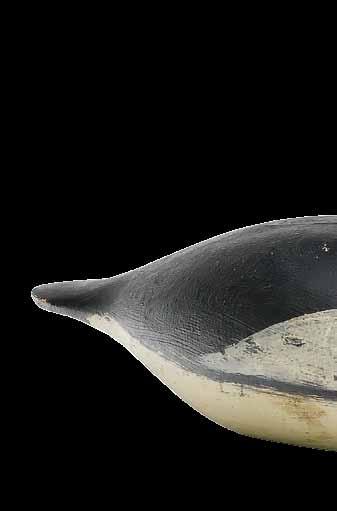
Scan for a

47 Mason Decoy Factory (1889-1924), Detroit, Michigan. Very rare and important rigmate pair of buffleheads. Early hand made challenge grade models. Drake with head turned 40 degrees. Measure 12.5” long. Original paint with very minor wear; hairline crack on underside of drake; tight drying crack along underside of hen was filled, but not touched up; minor blunting on tip of hen’s tail; drake retains all of the original neck filler; hen with half of the neck filler professionally restored with a few minor flakes.
Provenance: Dr. James McCleery collection. Peter and Diana Bennett collection.
Literature: “Mason Decoys – A Complete Pictorial Guide” by Russ J. Goldberger and Alan G. Haid, page 6, the forward by Dr. James McCleery and 77, exact pair pictured. “Factory Decoys of Mason, Stevens, Dodge, and Peterson” by John and Shirley Delph, page 50, exact pair pictured. (30,000 - 50,000)




47A Mason Decoy Factory (1889-1924), Detroit, Michigan. Three different, very rare, Mason Factory sales catalogs. One in its original envelope with one cent George Washington stamp postmarked 1921. Also includes four later reprints of early missing catalogs. Very good to fair; larger catalog with old tape at spine; creasing and tears to cover.
Provenance: Peter and Diana Bennett collection. (1,200 - 1,500)

Mason Decoy Factory (1889-1924), Detroit, Michigan. Exceedingly rare long-tailed duck. Early hand carved challenge grade model. Originally found in Duxbury, Massachusetts. Measures 17” long. Original paint with moderate wear; neck filler is missing; drying crack along the underside; professional tail chip repair by Ken Delong.
Provenance: Peter and Diana Bennett collection. (8,000 - 12,000)

49 Mason Decoy Factory (1889-1924), Detroit, Michigan. Early rigmate pair of broadbills. Hand carved challenge grade, circa 1890 with excellent paint detail. Measure 13.5” long. Original paint with very minor wear; minor flaking to the original neck filler; hairline drying crack on one side of drake’s head; otherwise excellent structurally.
Provenance: Peter and Diana Bennett collection.
Literature: “Mason Decoys: A Complete Pictorial Guide –Updated Edition” by Russ J. Goldberger and Alan G. Haid, page 42, exact pair pictured. “Factory Decoys of Mason, Stevens, Dodge, and Peterson” by John and Shirley Delph, page 38, exact pair pictured. (10,000 - 15,000)



50 Mason Decoy Factory (1889-1924), Detroit, Michigan. Extremely rare oversized curlew. Made in the style of William Bowman with deep relief wing carving and raised wingtips. McCleery collection ink stamp on underside. Includes the McCleery wooden stand. One of only three known. Measures 16” long. Original paint with very minor wear; small dents and shot marks; hairline cracks at a knot in one side; the iron bill is an early replacement with some touch up where it meets the face; chip in one of raised wingtips is professionally repaired.
Provenance: Peter and Diana Bennett collection.
Literature: “Mason Decoys: A Complete Pictorial Guide - Updated Edition” by Russ J. Goldberger and Alan G. Haid, page 134 exact decoy pictured.
(40,000 - 60,000)



51 Mason Decoy Factory (1889-1924), Detroit, Michigan. Extremely rare snipe. Early glass eye model with wooden bill. Two-piece body and head. Excellent paint detail. One of only three known. Measures 10.5” long. Dry original paint with almost no wear; small amount of flaking where hardwood bill meets face; excellent structurally.
Provenance: Peter and Diana Bennett collection. (30,000 - 50,000)

52 Mason Decoy Factory (1889-1924), Detroit, Michigan. Very rare red breasted merganser hen. Challenge grade with extended crest, glass eyes, and snakey head style. Measures 17.25” long. Original paint with minor wear; some rubs on one side of head and body; some paint flaking near neck seat.
Provenance: Peter and Diana Bennett collection. (8,000 - 12,000)
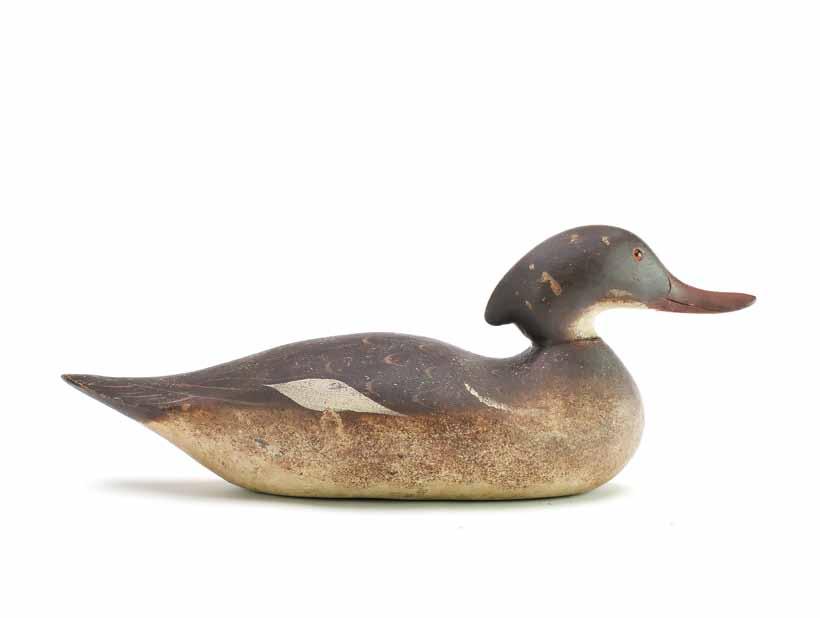



53 Mason Decoy Factory (1889-1924), Detroit, Michigan. Very early, handmade Canada goose with two-piece head and neck construction. The best of two known examples. Measures 21” long. Original paint with moderate flaking and wear; filled split along the underside; hairline vertical drying cracks in neck; some filler restoration where head and neck join; chipping around base of neck was restored; small amount of touchup on edge of bill.
Provenance: Peter and Diana Bennett collection. (15,000 - 25,000)



54 Mason Decoy Factory (1889-1924), Detroit, Michigan. Rare special order black coot. One of only two known that were made with a ducklike head and painted stripes across bill. White stripe on edge of tail and a larger wing patch than typical. Challenge grade with upswept tail. Measures 12.5” long. Original paint with moderate flaking and wear; tight drying crack along back and underside; small tail chip repair; hairline crack in one eye.
Provenance: Peter and Diana Bennett collection.
Literature: “Factory Decoys of Mason, Stevens, Dodge, and Peterson” by John and Shirley Delph, page 61, similar example pictured. (5,000 - 8,000)
55 Mason Decoy Factory (1889-1924), Detroit, Michigan. Very early coot. Challenge grade with slightly turned, uplooking head. “H” painted on underside. Measures 10.75” long. Original paint with minor gunning wear; tiny chip in tip of tail; some loss to filler at a knot hole on one lower side; hairline crack in one eye; chip in neck was professionally restored; some touchup to black on underside of face.
Provenance: Peter and Diana Bennett collection. (4,000 - 6,000)

56 Mason Decoy Factory (1889-1924), Detroit, Michigan. Brant. Challenge grade with “Barron” branded on back and one side. Used at the Barron Gun Club in Virginia. Measures 19.5” long. Original paint with minor wear; very minor flaking at neck seat; hairline cracks in neck.
Provenance: Peter and Diana Bennett collection. (4,000 - 6,000)

57 Mason Decoy Factory (1889-1924),
Detroit, Michigan. Golden plover in winter plumage. Early glass eye model with split tail carving and wooden bill. Small “JF” stamped near stick hole for the collection of Joe French. Measures 10” long. Original paint with minor to moderate wear, mostly on back; hairline crack in each eye; bill appears original; minor roughness on raised wingtip.
Provenance: Joe French Collection. Peter and Diana Bennett collection.
(6,000 - 9,000)
58 Mason Decoy Factory (1889-1924),
Detroit, Michigan. Early yellowlegs with glass eyes and wooden bill. Measures 13.25” long. Original paint with very minor wear; a few small dents in back and top of head, possibly where hunter was driving in the stickup stake; tight crack along one side; bill is a professional replacement.
Provenance: Peter and Diana Bennett collection.
Literature: “Mason Decoys – A Complete Pictorial Guide” by Russ J. Goldberger and Alan G. Haid, page 97 and 102, exact decoy pictured. (6,000 - 9,000)


59 Mason Decoy Factory (1889-1924), Detroit, Michigan. Very rare golden plover in spring plumage. Glass eye model with iron bill. Measures 11.5” long. Original paint with moderate wear; lightly hit by shot; hairline crack in one side; a very early thin wash of white on top of tail area.
Provenance: Peter and Diana Bennett collection.
Literature: “Mason Decoys – A Complete Pictorial Guide” by Russ J. Goldberger and Alan G. Haid, page 101, exact decoy pictured. (5,000 - 8,000)


Boyd with miniatures c1938.
Courtesy Jim Cullen
Boyd and shop c1905.
Courtesy Jim Cullen
George Boyd’s first venture into the world of work was, like so many other men of the day, associated with the local shoe industry. He was, however, never very far from the salt marshes of Seabrook and these, along with the surrounding fields and forest, were his long-time favored hunting and fishing grounds. These provided not only sport but were also important sources of food and income. He began his carving career in a very practical way by producing duck, geese and shorebird decoys meant to be shot over. Others were doing the same but, like in any area, some men excelled at their craft and George’s work fit nicely into that category. Eventually he was producing greater and greater numbers of decoys for sale locally, as well as in a few select retail operations, such as Iver Johnson in Boston.

An avid hunter, George Boyd was a frequent guest at the “Port of Missing Men”, a gunning stand (formed 1929) on New Hampshire’s Great Bay. Another frequent guest was Edward V Papin (1869 – 1955), an affluent summer resident of Rye, NH. Papin became a staunch friend and patron of Boyd and, reportedly, it was he that encouraged Boyd to begin carving miniatures.
As noted by Joe Ellis in his “Birds in Wood and Paint”: “Like Crowell and Lincoln before him, Boyd recognized by the late 1920’s that carving miniatures was faster and more lucrative than producing decoys, and by the early 1930’s he had quit shoe manufacturing to concentrate exclusively on his carving, focusing primarily on miniatures”.

“What more could one ask than to sit beside the fire and carve out these little birds?”
- George Boyd, 1938
He worked out of a small workshop behind his home on Collins Street that formerly housed his cobbler business. His small ducks and geese were, like Joe Lincoln, tiny versions of his full size, working decoys. Like his decoys, many had the head carved separately from the body and then attached with a tiny dowel. He rarely changed the basic body form and relied instead on his painting detail to identify individual species. Unlike Lincoln who was a minimalist, and Crowell with his delicately blended paint, Boyd used up to hundreds of individual tiny paint strokes to achieve the look he desired in the plumage. Unlike Lincoln, who is not known to have ever carved anything but miniature ducks and geese, Boyd, like Crowell, carved a wide variety of waterfowl, shorebird and upland species with only a few, very rare, miscellaneous species, such as his hummingbirds and passenger pigeons. In total, Ellis lists 60 different species that Boyd is known to have carved and Jim Cullen, through his exhaustive research, has expanded that list to 69 species. He sold his carvings not only at his own small shop in his backyard, but through Abercrombie and Fitch and Macy’s. He priced his carvings at only $.50 apiece and the retail outlets realized a nice profit by selling them at $25.00 apiece. His total lifetime production was rather limited. His daughter estimates that her father only produced about 700 miniatures while his grandson raises that estimate to about 1000 pieces, both small numbers compared to other noted miniaturists of his day.

George Boyd received relatively little fame or recognition in his lifetime. He did not advertise his work and there was not even a sign on his shop. He declined solicitations to be included in Abercrombie and Fitch exhibitions in New York, as well as offers to participate in the State of New Hampshire Exhibit at the World’s Fair in New York in 1939. As late as 1965, when Bill Mackey published his “American Bird Decoys”, Boyd’s working shorebirds were still referred to as being by “ - - - a prolific but unknown maker ”. It was only due to a chance auction and a later exhibit in the late 1970’s did a world far beyond the borders of Seabrook, New Hampshire begin to recognize and appreciate Boyd as the outstanding artist that he was. When his daughter was asked what he would think about the auction prices for his work today, she replied, “I guess he’d just laugh”
Many of the miniature George Boyd carvings in this sale were purchased at an auction in October 1977 held by M.D. Straw, Jr and Emory Sanders. On that day the collection of Philip S. Drake was sold at public auction. Mr. Drake had acquired the collection from Mr. Edward Papin who had encouraged George Boyd to carve miniatures. These miniatures can be considered some of Boyd’s earliest and rarest work.

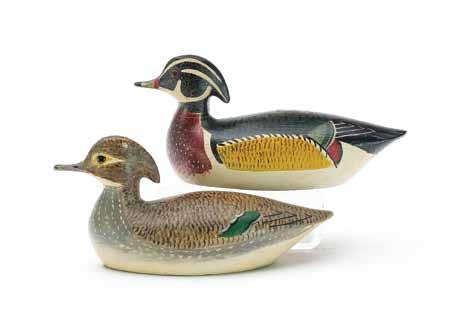
61 George Boyd (1873-1941), Seabrook, New Hampshire. Very rare pair of miniature loons. Slightly turned heads. Measure 4.75” long.
A few tiny paint rubs on drake; some fine lines of paint shrinkage on hen’s back; both excellent structurally.
Provenance: Dan Graf collection.
Literature: “Finely Carved & Nicely Painted” by Jim Cullen, page 75, exact pair pictured. (5,000 - 8,000)
60 George Boyd (1873-1941), Seabrook, New Hampshire. Outstanding pair of miniature wood ducks. Extended crest carving and very detailed paint pattern. Both identified in pencil on underside. Measure 3.75” long. Original paint with very fine crazing; excellent structurally.

Provenance: Dan Graf collection.
Literature: “Finely Carved & Nicely Painted” by Jim Cullen, page 14, exact pair pictured. (5,000 - 8,000)



62 George Boyd (1873-1941), Seabrook, New Hampshire. Very rare pair of miniature ruddy ducks. Hen with slightly turned head and drake with upturned, fanned out tail carving. Measure 4” long. Original paint with only very minor rubs; structurally excellent.
Provenance: Dan Graf collection.

Literature: “Finely Carved & Nicely Painted” by Jim Cullen, page 75, exact pair pictured. (5,000 - 8,000)



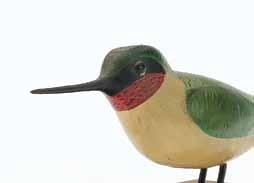
63
64
George Boyd (1873-1941), Seabrook, New Hampshire. Exceedingly rare miniature hummingbird. Measures 4” long. Excellent original paint with fine crazing to red on throat; paint flakes on the underside of split tail.
Provenance: Dan Graf collection.
Literature: “Finely Carved & Nicely Painted” by Jim Cullen, page 69, exact pair pictured. (5,000 - 8,000)
George Boyd (1873-1941), Seabrook, New Hampshire. Pair of miniature great blue herons with heads turned 90 degrees. Male with extended head feathers. Measure 5.25” and 6” long. Hairline separation at female’s neck seat; male’s head feathers appear to have been professionally replaced.
Provenance: Dan Graf collection. (4,000 - 6,000)


66 George Boyd (1873-1941), Seabrook, New Hampshire. Extremely rare miniature pair of turkeys. Tom with inserted wooden beard. Both in walking pose. Measure 5.75” long. Both in original paint with fine crazing; surface has darkened slightly with age; both excellent structurally.
Provenance: Dan Graf collection.
Literature: “Finely Carved & Nicely Painted” by Jim Cullen, page 67, exact pair pictured. (3,000 - 5,000)
65 George Boyd (1873-1941), Seabrook, New Hampshire. Very rare miniature puffin. Stands 3.5” tall including base. Very fine crazing, otherwise excellent and original.
Provenance: Dan Graf collection. (2,000 - 4,000)

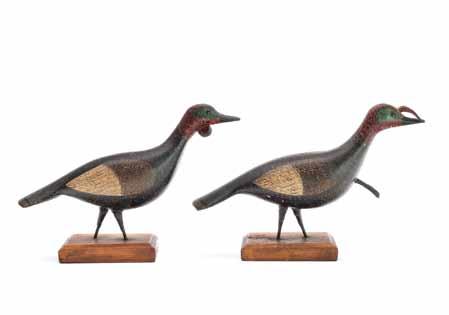

67 George Boyd (1873-1941), Seabrook, New Hampshire. Exceedingly rare miniature grouse. Measures 4.25” long. Original paint with very fine crazing and almost no wear.

Provenance: Dan Graf collection. (3,000 - 5,000)
68 George Boyd (1873-1941), Seabrook, New Hampshire. Pair of miniature night herons. Male with extended head feathers. Measure 3.75” long. Original paint with very fine crazing on back of male’s neck; two tiny paint rubs on hen’s back; otherwise both excellent and original.
Provenance: Dan Graf collection.
Literature: “Finely Carved & Nicely
Painted” by Jim Cullen, page 67, exact pair pictured. (4,000 - 6,000)



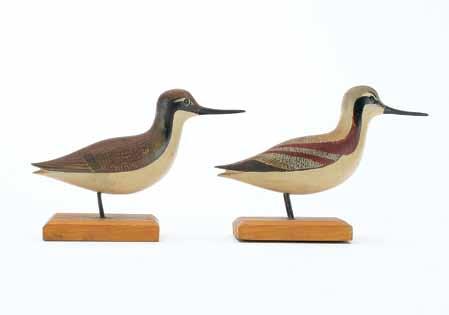
70 George Boyd (1873-1941), Seabrook, New Hampshire. Pair of miniature bluewing teal. Both identified in pencil on the underside. Measure 3.75” long. A few tiny paint rubs, otherwise excellent and original.
Provenance: Dan Graf collection.
Literature: “Finely Carved & Nicely Painted” by Jim Cullen, page 41, exact pair pictured. (2,000 - 3,000)

69 George Boyd (1873-1941), Seabrook, New Hampshire. Outstanding pair of miniature Wilson phalaropes. Identified on the undersides. Measures 4.25” long. Very minor crazing on male’s head and two tiny paint rubs on one side of male’s bill; otherwise excellent and original.
Provenance: Dan Graf collection.
Literature: “Finely Carved & Nicely Painted” by Jim Cullen, page 71, exact pair pictured. (3,000 - 5,000)


72 George Boyd (1873-1941), Seabrook, New Hampshire. Pair of miniature ringneck ducks. Measure 4” long. Original paint with scattered rubs; both excellent structurally.
Provenance: Dan Graf collection.
Literature: “Finely Carved & Nicely Painted” by Jim Cullen, page 80, exact pair pictured. (3,000 - 5,000)
71 George Boyd (1873-1941), Seabrook, New Hampshire. Extremely rare pair of miniature labrador ducks. Measure 3.75” long. Original paint with a few rubs mostly on drake; both excellent structurally.
Provenance: Dan Graf collection. (4,000 - 6,000)


73 George Boyd (1873-1941), Seabrook, New Hampshire. Excellent pair of miniature shovelers. Both identified in pencil on underside. Measure 4.25” long. A few very minor paint rubs, otherwise excellent and original.
Provenance: Dan Graf collection.
Literature: “Finely Carved & Nicely Painted” by Jim Cullen, page 64, exact pair pictured. (3,000 - 5,000)
74 George Boyd (1873-1941), Seabrook, New Hampshire. Pair of miniature hooded mergansers. Hen with slightly turned head. Both with extended crests. Measure 3.75” long. Original paint with very minor flaking and rubs; excellent structurally.
Provenance: Dan Graf collection.
Literature: “Finely Carved & Nicely Painted” by Jim Cullen, page 72, exact pair pictured. (2,000 - 4,000)


76 George Boyd (1873-1941), Seabrook, New Hampshire. Rare standing miniature Canada goose. Measures 5” long. Original paint under a thin coat of varnish that has crazed; slight separation at neck seat; bill was cracked down and reset.
Provenance: Dan Graf collection.
Literature: “Finely Carved & Nicely Painted” by Jim Cullen, page 61, exact carving pictured. (2,000 - 3,000)
75 George Boyd (1873-1941), Seabrook, New Hampshire. Excellent pair of miniature redbreasted mergansers. Hen with slightly turned head and both with extended crest. Drake is identified in pencil on the underside. Measure 4.25” long. Drake is near mint; hen with a few small spots of touchup; hen’s bill has been professionally restored.
Provenance: Dan Graf collection.
Literature: “Finely Carved & Nicely Painted” by Jim Cullen, page 61, exact pair pictured. (2,000 - 4,000)

The following 21 Elmer Crowell miniatures are from the same set of 25 originally purchased from Crowell.


77 A. Elmer Crowell (1862-1952), East Harwich, Massachusetts. Miniature wood duck with extended crest carving. Maker’s rectangle stamp on the underside. Also numbered 23. Measures 4.25” long. Excellent and original. (1,200 - 1,800)
78 A. Elmer Crowell (1862-1952), East Harwich, Massachusetts. Miniature American merganser. Maker’s rectangle stamp on the underside. Also numbered 17. Measures 5” long. Excellent and original. (800 - 1,200)


79 A. Elmer Crowell (1862-1952), East Harwich, Massachusetts. Miniature running red breasted merganser. Maker’s rectangle stamp on the underside. Also numbered 11. Measures 6” long. Excellent and original. (1,000 - 1,400)
80 A. Elmer Crowell (1862-1952), East Harwich, Massachusetts. Miniature reaching brant. Maker’s rectangle stamp on underside. Also numbered 16. Measures 6” long. Four tiny paint flakes on one side, otherwise excellent and original. (1,000 - 1,400)


81 A. Elmer Crowell (1862-1952), East Harwich, Massachusetts. Miniature feeding canvasback. Maker’s rectangle stamp on underside. Also numbered 13. Measures 5” long. Some paint flaking on edge of bill; small dent on back; some roughness on tip of tail. (800 - 1,200)
82 A. Elmer Crowell (1862-1952), East Harwich, Massachusetts. Miniature pintail. Maker’s rectangle stamp on the underside. Also numbered 3. Measures 5.25” long. Original paint with no wear; professional neck crack and tail chip repair. (800 - 1,200)


83 A. Elmer Crowell (1862-1952), East Harwich, Massachusetts. Rare miniature pintail hen with reared back head. Maker’s rectangle stamp on the underside. Also numbered 4. Measures 3.5” long. Tiny paint rubs on tip of bill and tip of tail, otherwise excellent and original. (1,200 - 1,800)
84 A. Elmer Crowell (1862-1952), East Harwich, Massachusetts. Miniature widgeon. Maker’s rectangle stamp on the underside. Also numbered 24. Measures 4” long. Tiny paint flake on tip of bill, otherwise excellent and original. (800 - 1,200)



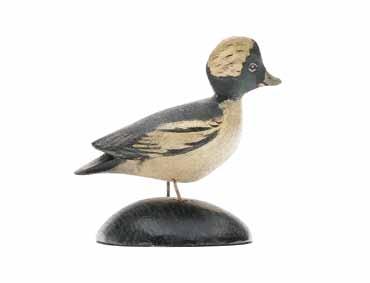
85 A. Elmer Crowell (1862-1952), East Harwich, Massachusetts. Miniature ruddy duck. Maker’s rectangle stamp on underside. Also numbered 8. Measures 1.75” long. Excellent and original. (800 - 1,200)
86 A. Elmer Crowell (1862-1952), East Harwich, Massachusetts. Miniature hooded merganser with extended crest feathers. Maker’s rectangle stamp on the underside. Also numbered 19. Measures 3” long. Excellent and original. (1,000 - 1,400)
87 A. Elmer Crowell (1862-1952), East Harwich, Massachusetts. Miniature long-tailed duck. Maker’s rectangle stamp on the underside. Also numbered 22. Measures 4” long. Tiny blunting on tip of tail, otherwise very good and original. (800 - 1,200)
88 A. Elmer Crowell (1862-1952), East Harwich, Massachusetts. Miniature bufflehead. Maker’s rectangle stamp on underside. Also numbered 7. Measures 2.75” long. Very good and original. (800 - 1,200)
89 A. Elmer Crowell (1862-1952), East Harwich, Massachusetts. Pair of miniature redheads. Maker’s rectangle stamp on the underside. Also numbered 5 and 6. Measure 4.25” long. Excellent and original. (1,500 - 2,500)


90 A. Elmer Crowell (1862-1952), East Harwich, Massachusetts. Pair of miniature bluebills. Maker’s rectangle stamp on the underside. Also numbered 9 and 10. Measures 3.5” long. Tiny paint flakes on lower edge of hen’s base; small paint flake in one side of hen, otherwise very good and original. (1,500 - 2,500)
91 A. Elmer Crowell (1862-1952), East Harwich, Massachusetts. Miniature goldeneye. Maker’s rectangle stamp on the underside. Also numbered 21. Measures 4” long. Excellent and original. (800 - 1,200)


92 A. Elmer Crowell (1862-1952), East Harwich, Massachusetts. Miniature Canada goose. Maker’s rectangle stamp on the underside. Also numbered 25. Measures 5.75” long. Tiny paint rub on tip of bill, otherwise excellent and original. (1,200 - 1,800)
93 A. Elmer Crowell (1862-1952), East Harwich, Massachusetts. Pair of miniature mallards. Maker’s rectangle stamp on the underside. Also numbered 1 and 2. Measure 4.5” and 5” long. Professional neck crack repair on drake, otherwise excellent and original.
(1,500 - 2,500)


94 A. Elmer Crowell (1862-1952), East Harwich, Massachusetts. Miniature black duck. Maker’s rectangle stamp on the underside. Also numbered 20. Measures 5.75” long. Excellent and original. (800 - 1,200)




95 Unknown maker, 2nd quarter 20th century, Crisfield, Maryland. Miniature pintail similar to the work of Lloyd Sterling. With reared back head and upswept tail. Measures 5.75” long. Original paint with significant crazing and very minor wear; old chip in tip of tail; reglued crack through neck. (200 - 300)
96 Unknown maker, 2nd quarter 20th century, Crisfield, Maryland. Pair of miniature mallards. Similar to the work of Lloyd Tyler. Identified on the undersides. Measure 5.25” long. Original paint with very minor wear; old chip in each tail; crack in drake’s neck; reglued chip in hen’s bill. (200 - 400)
97 Unknown maker, 2nd quarter 20th century, Crisfield, Maryland. Pair of miniature goldeneyes. Slightly turned heads. Measure 4.5” long. Original paint with significant crazing and minor wear; very minor roughness on edge of drake’s tail, otherwise very good structurally. (300 - 500)
98 Unknown maker, 2nd quarter 20th century, Crisfield, Maryland. Three miniature goldeneye hens with slightly turned heads and scratch feather paint details. Two with paper labels from Manro Trading Company Inc on underside. Measure 4.5” - 5” long. Original paint with very minor wear; very good structurally. (300 - 500)

shown here

for similarities and age.

99 Ward Brothers, Crisfield, Maryland. Exceedingly rare standing Canada goose. This early and unique decorative goose was made around the same time as the famed Bishops Head Gun Club geese with the same head carving, paint detail, and hump under the tail as that famous rig. Relief wing carving with applied peach basket stave wingtips. Head is turned 45 degrees. “Ward’s Decoys Crisfield, Maryland” painting on underside of tail. Measures 24” long, stands 19.5” tall. Original paint with minor crazing; some flaking to white on cheek patches; two dents on one side of tail; some restoration to jesso where one leg meets body; hairline crack in each side of body; tight crack in one side of lower neck.
Literature: “The Ward Brothers’ Decoys – A Collector’s Guide” by Ronald J. Gard and Brian J. McGrath, page 121 and 126, exact decoy pictured. “Timeless Treasures: Ward Brothers Decoys” by The Ward Museum of Wildfowl Art, Salisbury, Maryland, page 65, exact decoy pictured.
(80,000 - 120,000)
100 Ward Brothers, Crisfield, Maryland. Very rare balsa body greenwing teal with slightly turned head and extended crest. Excellent paint detail. Measures 12.5” long. Original paint with a few spots of flaking and almost no wear; short hairline crack in one side of breast; hairline crack in bill at nostril. (17,500 - 22,500)



101 Ward Brothers, Crisfield, Maryland. Greenwing teal hen with slightly turned head. Fine feather paint detail including on head and neck which the Wards did not always do. Maker’s ink stamp on the underside. Measures 11.75” long. Original paint with very minor flaking and rubs; filler above nail in top of head has flaked; minor chipping at neck seat; hairline drying crack along back and breast; tiny chip in tip of bill with some touchup on underside of bill; short hairline crack in tip of tail.
(12,000 - 18,000)



102 Ward Brothers, Crisfield, Maryland. Two piece black duck with head turned 45 degrees. 1936 style. Measures 16” long. Excellent original paint with very minor wear; dowel on top of head has risen slightly; tiny spot of filler added above nostril; crack along back and tail was filled and touched up.
Provenance: Tom Karras collection. (10,000 - 15,000)


(6,000 - 9,000)
103 Ward Brothers, Crisfield, Maryland. Preening canvasback hen. Balsa body with green felt on underside. Identified, signed, and dated 1952 under tail. Measures 15” long. Original paint with moderate flaking, mostly on one side of back and top of head; dowel in top of head has risen slightly.

104 Ward Brothers, Crisfield, Maryland. Mallard hen, circa 1930. “SGH” stamped in underside for collection of Somers G. Headly. Measures 18” long. Original paint with minor wear under a thin coat of varnish; professional neck crack repair; tight drying crack in tail; white paint was added to the underside long ago.
Literature: “Decoys of the Mid-Atlantic Region” by Henry A. Fleckenstein Jr., page 167, exact decoy pictured. (6,000 - 9,000)


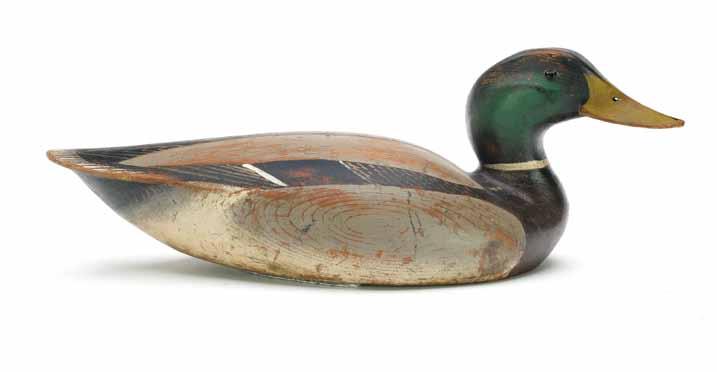
Ward Brothers, Crisfield, Maryland. Canada goose with slightly turned head. Signed by the makers on the underside. “DWS” stamped on underside for the collection of Don Snyder. Measures 22” long. Original paint with minor to moderate wear; in the making filled cracks in back have opened over time; with some type of glue added; crack through neck.
Provenance: Don and Mary Elizabeth Snyder collection.
(3,000 - 5,000)
106 Ward Brothers, Crisfield, Maryland. 1936 style mallard with slightly turned head. Curved lead weight like those used at the White Mallard Club, appears to have been added at a later date. Measures 17.25” long. Original paint with moderate gunning wear; minor roughness on edge of tail; small chip in one side of bill.
(8,000 - 12,000)


Very good and original.
(2,500 - 3,500)
108 Ward Brothers, Crisfield, Maryland. Canada goose with excellent head carving and large tack eyes. Signed and dated 1948 at a later date on the underside. Measures 27.75” long. Black on head and bill appears original; the rest is an early working repaint by the Ward Brothers showing moderate flaking and wear; drying crack along back and tail; old chipping and roughness on edge of tail; tight crack at base of neck.
(2,000 - 4,000)


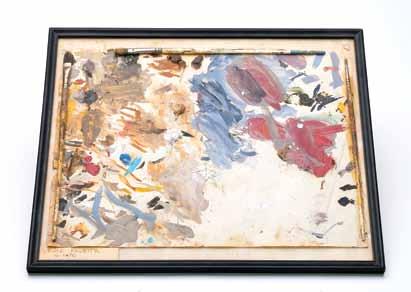
109 Cast brass pintail modeled after one by the Ward Brothers. Inset piece of wood on underside is signed by Lem and Steve, and numbered 2. Measures 16.5” long. Minor rubs and discoloration, otherwise excellent. (800 - 1,200)
110 Lem Ward (1896-1984), oil on canvas board. Image measures 7.5” x 9.5”. Signed lower right and dated 1972. Chesapeake retriever with mallard. Stamped on back, “R.H. Richardson collection”, along with a postcard from which the painting was inspired. Painting is slightly dirty with light discoloration to varnish.
Provenance: David Fannon collection. (500 - 800)
111 Lem Ward (1896-1984), Crisfield, Maryland. Three paint brushes and paper pallet used by Lem Ward, circa 1970. Mounted on framed glass backboard. Frame measures 14.5” x 17.5”. Original. (600 - 900)

Perhaps as a sign of the times in which Ira Hudson lived or because of the remoteness of his world, the family did not know the exact date of his birth. While it is assumed to be between 1875 and 1877, most references show it to be 1873. He apparently thought he was born in Delaware. He was actually born in Bishopville, Maryland to Ananias Hudson and Mary Elizabeth Beebe and was reportedly given the middle name of the family’s favorite minister. His family was accustomed to working with their hands and earning a living around the water. In a 1900 census, his father was listed as a “house carpenter” and his uncle as a “lighthouse keeper.” These family occupations apparently influenced Ira’s choice of careers for he is listed as a “waterman” in 1900 and as an “oysterman” in 1910. He married Eva Bowden and the couple raised twelve children on Chincoteague.
Ira never achieved any level of great financial wealth, however, the family never seemed to be deprived of a comfortable existence. Family was very important to Ira and, even in his later years, he enjoyed getting together with them on Sundays. His success was due in part to Hudson’s willingness to do whatever was necessary to provide for their well-being. He clammed, fished, oystered, and raised his own chickens. He built boats, took on carpentry projects, and he carved decoys. It is this last endeavor that brought him some degree of fame during his life, and even higher acclaim after his death.
He hand chopped all his early decoys. In 1940, because the family had no electricity in their home, he acquired his first gas powered band saw. His earliest decoys were his work alone but in later years, family members, most notably two of his sons, Norman and Delbert, would assist in the finishing and painting of the birds. In Ira’s mind, he was not creating “art” but rather utilitarian objects that were needed to attract the migrating flocks of ducks and geese. He certainly possessed an artistic flair as is evidenced in some of his finest working pieces, and it is evident in his decorative flying and standing carvings.



112 Ira Hudson (1873-1949), Chincoteague, Virginia. Rare rigmate pair of mergansers. Hen with slightly turned head. Both with extended crests, tack eyes, and fluted tails. Partially inlayed neck seats. “SGH” stamped on underside for the collection of Somers G. Headly. Both are also branded “WHP Jr” for the collection of William Purnell. Measure 15.25” and 15.75” long. Drake in original paint with moderate gunning wear; area of discoloration on lower sides; lightly hit by shot; tight crack at neck seat; old chip at top of crest; hen was originally painted as a drake and
repainted as a hen by Hudson, likely before the bird left his shop; moderate flaking and wear; minor roughness on top of crest.
Provenance: Formerly in the collection of Bill Purnell, Jr. Formerly in collection of Somers G. Headly.
Literature: “The Bird Decoy An American Art Form,” Paul A. Johnsgard, p. 82 exact decoys. (35,000 - 45,000)
While mallards are a common site today they were considered extremely rare on the sea side area of the Eastern shore in the first half of the 20th century. Carvers on the eastern shore had no demand for mallard decoys and examples of mallards by makers like Dave Watson, Nathan Cobb, Eli Doughty, do not exist. This mallard by Ira Hudson is one of only two or three known.


113
Ira Hudson (1873-1949), Chincoteague, Virginia. Mallard with large round body and fluted tail. Good paint detail. Measures 15.75” long. Original paint with no wear; never rigged; paint shrinkage on breast; small paint flakes missing from top of tail; small crack at knot in lower side. (17,500 - 22,500)


113A Ira Hudson (1873-1949), Chincoteague, Virginia. Full size flying mallard with slightly turned head and fluted tail. Measures 20” long, with a 27” wingspan. Original paint with a thick coat of varnish that has darkened with age and was likely applied before the paint was dry causing scattered crazing and paint shrinkage; feet appear to be professional replacements. (8,000 - 12,000)
113B Ira Hudson (1873-1949), Chincoteague, Virginia. Important rigmate pair of goldeneyes. Both retain the Roy Bull brand on underside. Both are in an appealing second coat of paint by Ward Brothers. 14 1/2” long. Ward brothers paint has moderate gunning wear with wood grain exposed in some areas; flaking to filler at neck seat; crack in hen’s back; professional bill chip repair on drake.
Literature: “Ward Brothers Decoys,” Ron Gard and Brian McGrath, p. 36, exact decoys pictured. “Ira Hudson and Family,” Henry Stansbury, p. 104, exact decoys pictured. (6,000 - 9,000)

113B

114 Ira Hudson (1873-1949),
Chincoteague, Virginia. Bluebill with tack eyes, fluted tail, and partially inlayed neck seat. Scratch feather paint detail on center of back. Measures 13.75” long. Original paint with minor gunning wear; half of the bill is a professional replacement. (1,000 - 1,400)
115 Doug Jester (1876-1961), Chincoteague, Virginia. Small merganser with raised neck seat and extended crest. Measures 11.75” long. Original paint with moderate crazing and wear; tight crack in one side of head; minor roughness on top of crest; spot of roughness on one side near tail. (1,200 - 1,800)


116 Doug Jester (1876-1961), Chincoteague, Virginia. Rare pair of bufflehead. “P” branded on the undersides. Measure 10.25” long. Original paint with minor to moderate gunning wear; drake is lightly hit by shot; hen with hairline cracks in back; a reglued crack in neck; thin wash on white areas of hen. (2,000 - 3,000)



117 Noah Sterling (1884-1954), Crisfield, Maryland. Rare brant with scratch feather paint detail. Large iron spike weight. Measures 21” long. Black on breast and head appears original with moderate flaking and wear; old over paint on the rest of the decoy was taken down to much of the original; old chipping on edge of tail; split and loss to wood on underside; tight crack through lower neck; professional bill chip repair. (3,000 - 5,000)
118 Leonard Pryor (1876-1967) Chesapeake City, Maryland. Hollow carved black duck. Carved eyes. “F” branded on underside for the collection of Henry Fleckenstein. Measures 18.5” long. Original paint with very minor wear; under a thin coat of varnish; separation at wood grain in one side was secured in the making with some tiny nails. (3,000 - 4,000)


119 Miles Hancock (1887-1974), Chincoteague, Virginia. Excellent Canada goose. Made from cotton wood, with tiny tack eyes. Measures 24.5” long. Original paint with very minor wear, mostly on edge of tail and bill; excellent structurally. (2,000 - 3,000)
120 Ira Hudson (1873-1949), Chincoteague, Virginia. Swimming Canada goose with raised neck seat and stickup hole drilled in underside. Measures 27.5” long. Head is carved by Mark McNair, and the paint was professionally restored by McNair in the Hudson style; filled drying cracks in body have flaked; minor roughness on edge of tail. (2,000 - 3,000)


Born in Cheriton, Virginia, Robert began working as early as age 13, listed along with his two brothers as a “laborer” (presumably on the family farm) while his father, William, worked as a Mariner. When he was 22, he married Amanda Mckunn and together they raised their son, Garland. He worked briefly as a “sailor” and this experience would serve him well when, around the late 1880s, he became a surfman at the Smith Island Life Saving Station. It was here, in about 1897, that he served with and collaborated on a rig of shorebirds with John Henry Downes and Alma Fitchett. By 1900, he was back in Capeville working as a sailor and “watchman/oysterer” until finally taking up house painting in the 1920s.

While known for his shorebirds, he also carved a number of black ducks and brant. There is no record that he ever made decoys to sell so we have to assume that he carved solely for his own use and thus, his production must have been quite small.
The quality of his work undoubtedly places Andrews in the ranks of one of the most desirable of the Smith Island, Cobb Island and Hog Island carvers.
Note: His gravestone lists his DOB as 1863 however all other census, marriage, birth, and death records list his DOB as variously 1855, 56 or 57.

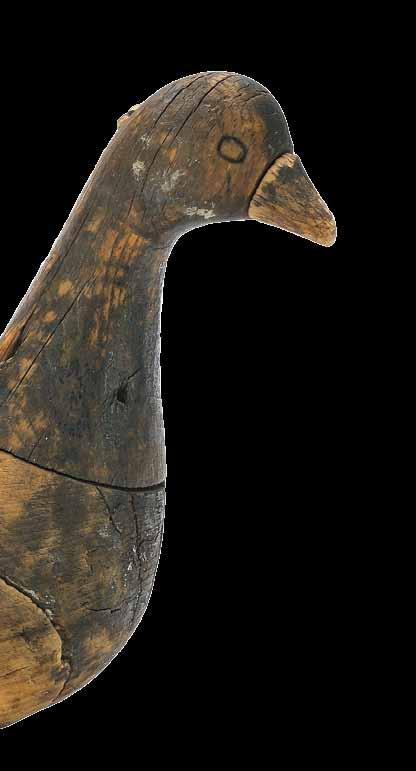
121 Captain Robert Andrews (1863-1925), Smith Island, Virginia. Extremely rare brant. In swimming pose with split tail carving, carved eyes, and inserted hardwood bill. ‘A’ carved under the tail. ‘ELW’ branded twice on the underside. Retains Charlie Hunter III collection tag. Measures 18.5” long. Old working repaint with significant flaking and wear; many drying cracks in body, head, and neck; loss to wood near one nail attaching neck to body; two screw holes in top of back.
Provenance: Guyette & Schmidt April 1996 sale, lot 551. Charlie Hunter III collection. Al Marzorini collection.
Literature: “Chesapeake Bay Decoys,” Robert Richardson, p. 208, exact decoy pictured. (10,000 - 15,000)



Elkanah Cobb (1852-1943), Cobb Island, Virginia. Hollow carved black duck with inlayed neck seat, carved eyes, and split tail carving. Serifed “E” carved in underside. Measures 16” long. Paint was professionally restored; crack in back of neck and one side of head; short drying cracks in body; filler added to loss in wood on one lower side near tail. (7,000 - 10,000)

123

Unknown maker, 19th century, Eastern Shore of Virginia. Running black bellied plover with relief wing carving and raised wingtips. Dr. Lloyd Griffith collection ink stamp on the underside. Measures 10.5” long. Original paint with moderate wear under a thick coat of varnish; lightly hit by shot; bill is a very well done professional replacement.
Provenance: Dr. Lloyd Griffith collection. Private Southern collection. (6,000 - 9,000)
George Douglas Thornton (1880 – 1957) was the firstborn child of John H (1857 – 1914) and Traney (Tranie) Thornton. Like many of their neighbors, the Thornton’s were watermen on Chincoteague, earning their living working the local waters for oysters, fish and crabs. By about the age of 11or 12, young George had completed 6th grade at the local school and began to work with his father. At age 18, as was the custom of some of the islanders at the time, he accompanied his parent to New York to work there for the winter season. Returning to Chincoteague, he lived at home working as an oysterman until 1902. In that year, he wed young Henrietta (various spellings) Thornton, another member of the large clan by that same name on the Island. According to verbal history handed down in the family, the couple eloped across the bay in George’s small boat to be wed on the mainland at Franklin City. They had two children that survived to adulthood, a son, Clarence, and a daughter, Melva. A third child died at birth in 1912.
George must have been quite successful at his chosen profession of waterman for, in 1925, he purchased a large, comfortable home on Poplar St, near the intersection with Main. George continued to work as an oysterman or fisherman until retiring by the time of the 1950 census. In his death certificate, he is listed not only as a retired waterman but also a poultry raiser. It is unknown how long he had been interested in poultry or if this aspect of his life was ever meant to be income producing or, simply, a hobby. He died at his home and Henrietta remained at the Poplar St address until her death in 1965.
Upon his passing, a rig of 19 fine shorebirds was a part of George’s estate. The group, including dowitchers, curlews, knots, and black bellied plovers, represents the work of what appears to be, at least, four different makers. Such mixed rigs are not uncommon, as stray

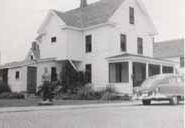
THORNTON HOME
POPLAR ST, C1950
birds may have occasionally been found or acquired and simply added to a hunter’s spread. Some of the assemblage are similar to, or possibly even by, Charles Clark and Umbrella Watson, while others seem to have a Cobb Island connection. Nine of the rig are by the same hand and, since they do not match any of the local carvers that we are aware of, are assumed to have been carved by a member of the Thornton family, possibly George or his father. It is also possible that, perhaps, some other, yet unidentified, member of the Chincoteague community made the nine decoys. It would certainly be logical to assume that they were hunted over by Thornton family members. All are in fine original paint, indicating that they were well cared for. The 19 decoys remained with George’s wife who then passed them to her daughter, Melva. She, in turn, gave the entire original rig to her son. The family is now willing to deaccession the decoys. In their words, “ It’s time to let someone else enjoy them”.
Legal hunting of shorebirds was partially prohibited in 1918 and, finally, completely outlawed in 1928. It is extremely rare that a complete rig of working shorebirds would remain intact and in the hands of the same family for approximately one hundred years.
124 Unknown maker, last quarter 19th century, Chincoteague, Virginia. Red knot. Found with this group of Chincoteague decoys, but likely made around Cobb or Hogg Island. Strong ridge line down lower half of back, as well as back of head. Measures 7” long. Head appears to be in original paint; body is mostly original with possibly some working touchup. half of the bill is a professional replacement by Russ Allen. (3,000 - 4,000)

125 Unknown maker, 2nd half 19th century, Chincoteague, Virginia.
Curlew with an “H” carved in underside. Similar to the work of Charles Clark. Painted eyes and two tone body. Measures 14” long. Original paint.
(3,500 - 4,500)
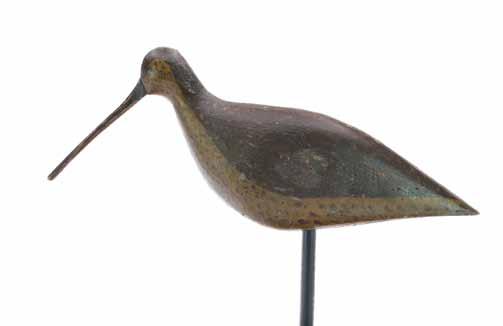
126 Unknown maker, 2nd half 19th century, Chincoteague, Virginia. Black bellied plover in winter plumage. Slight relief wingtip carving and distinct ridge down back. Measures 9.5” long. Original paint with moderate wear; lightly hit by shot; small chip in back of head; chip in the original bill was reglued.
(2,000 - 4,000)
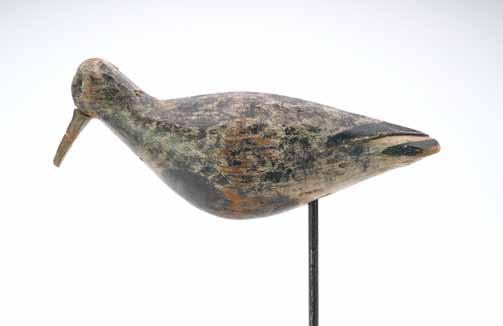



127 Unknown maker, 2nd half 19th century, Chincoteague, Virginia. Curlew with an “H” carved in underside. Similar to the work of Charles Clark. Painted eyes and two tone body. Measures 14” long. Original paint; 3/4 of bill has been professionally replaced by Russ Allen.
(1,500 - 2,500)
128 Unknown maker, last half 19th century, Chincoteague, Virginia. Shorebird found on Chincoteague but likely carved on Hogg or Cobb Island as the tail carving would indicate. “OMG” carved in underside of tail. One carved eye. Measures 13”. Traces of original paint and bare wood. Rough area at end of tail; bill is a professional replacement by Russ Allen.
(1,000 - 2,000)
129 Unknown maker, circa 1900, Chincoteague, Virginia. Pair of red knots. One in spring plumage and other in fall plumage. Measure approximately 9” long. Both in excellent original paint; shot scars; bills are splined though back of head. bill on fall plumage is a replacement of approximately 50%.
(3,500 - 4,500)
130 Unknown maker, Chincoteague, Virginia. A pair of black bellied plover by the same makers as the dowitchers in this group. Each measures 12” long. Both are in original paint. (1,000 - 1,500)

131 Unknown maker, circa 1900, Chincoteague, Virginia. Five dowitchers. Each measures approximately 10” long. Mostly original paint; some shot scars; one has a hole drilled near the tail area of the back; one has a complete bill replacement.
(3,000 - 4,000)

132 Unknown maker, circa 1900, Chincoteague, Virginia. Pair of red knots. Both carved from the same hand. Measure 9” long. Old paint some of which is original and some has been strengthened; both display shot scars; both have had a brand scratched off of underside of tail. (2,000 - 3,000)

132A Unknown maker, Chincoteague, Virginia. Group of three dowitchers by two different makers. The short bird has a body with more of a Cobb Island tail and an early working head replacement put on by the maker of the other two birds. Larger birds measure 11”. All are in old paint, some which is original with old working repaint in some areas.
(1,000 - 1,500)



Alvirah Wright was born and raised in the small community of Old Trap in the eastern part of Camden County near the Pasquotank River and, like so many men in his community, he made his living on the water. He followed in his father’s footsteps and became a tugboat captain by trade. In about 1906, he moved to the Martin’s Point area of Dare County where he married Amy Rogers, set up a logging operation, and built a two story logging mill. Apparently, neither the timber nor the marriage proved sustainable causing him to move back to Old Trap and, in 1914, he married his second wife, Sally Forbes. He was also an accomplished boat builder and he developed quite a reputation for his skill in that trade.
It is reported that Wright only made 300 - 500 decoys in his lifetime. He made mostly large battery canvasbacks, a few redheads and scaup, and a small number of ruddy ducks. He is justly considered one of North Carolina’s finest decoy makers.

133 Alvirah Wright (1872-1951), Knotts Island, North Carolina. Large redhead with raised and reared back head. Measures 15.75” long. Early second coat of paint with moderate flaking and wear under an early coat of wax; crack through upper part of neck with nails added to secure. (25,000 - 35,000)
1950
“(He) had a few close friends and no enemies” (fishing companion, Leckler Lewis)
Although all recent references state Fulcher’s residence as being in Stacy, from the time of his birth through the time of his death, his home was referred to in all formal records as being in “Hunting Quarters”, an area historically including the townships of Sea Level and Atlantic, directly across Nelson Bay from Stacy. Regardless of semantics, the name is a very fitting label for an area that would produce Carteret County’s most accomplished decoy carver.
Hunting Quarters was about as far off the proverbial beaten path as one could get. His home was in the midst of some of the finest waterfowling in the region and the residents of the tiny coastal community, including his father, subsisted on fishing and farming. Life was not easy. By the time of the 1880 census, it appears that Mitchell’s parents had separated, and he was living with his mother, Elizabeth, in the home of her brother. Sadly, his mother died that same year. Mitchell was only eleven. After receiving a very rudimentary education, he began to work as a fisherman and would list either fishing, oysterman, or crabber as his occupation for his entire life. He also trapped and worked in the terrapin trade. In 1905, he married a local girl, Susan Gaskill and
134 Mitchell Fulcher (1869-1950), Stacy, North Carolina. Bluebill hen with carved eyes and maker’s initials carved in underside. Measures 14.25” long. Mix of original and very early thin second coat; showing moderate flaking and wear; two small losses to wood near knots in back and a drying split in underside, otherwise very good structurally.
Provenance: Consigned for conservation to support Ducks Unlimited. (8,000 - 12,000)
they would have two children, Ellen, who died at age five, and Cartie, who survived to adulthood.
Fulcher was considered a perfectionist in everything he did. His small orchard, grapevines and garden were considered the finest in the community. If he had a downside, seemingly, it was his violent temper. After becoming mad with his flock of geese one day, he proceeded to shoot them all. During a loud, profanity ridden rant to his wife, she retreated to the house, took down the shotgun, and fired a shot over his head. Apparently, this calmed him down rather quickly.
He took great pride in his decoys which were far better crafted than those of most of his neighbors. His head patterns were based on birds he had shot and, using only a hand saw, hatchet, pocketknife and sandpaper, he produced the finest decoys from the region and his work served as the inspiration for many area carvers to follow. For about ten years in the early 1900’s, he worked as a guide at the Carteret Rod and Gun Club at Cedar Bank which later became the Core Banks Rod and Gun Club. He made decoys for a few close friends or associates and the birds in his own personal rig were clearly marked with his carved “MF” initials in the bottoms. With good reason, his decoys are among the most sought after from Carteret County.
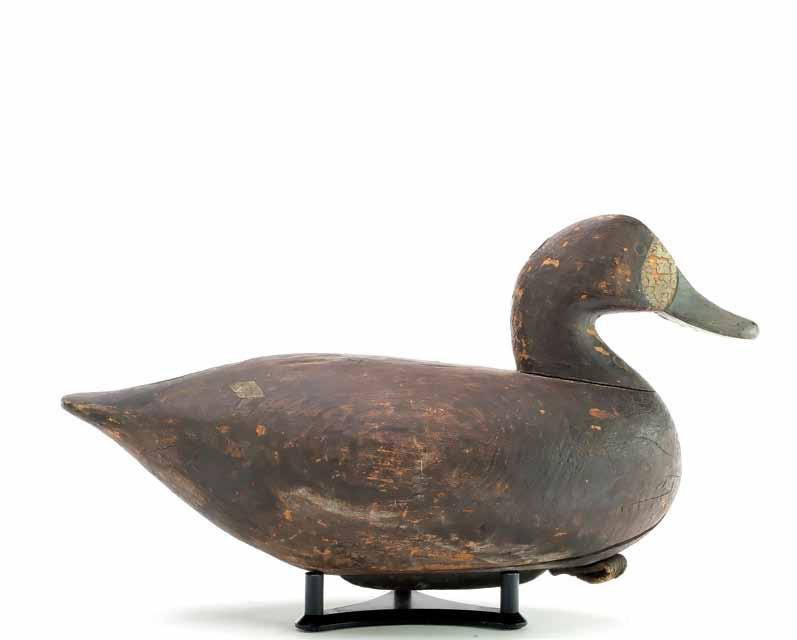
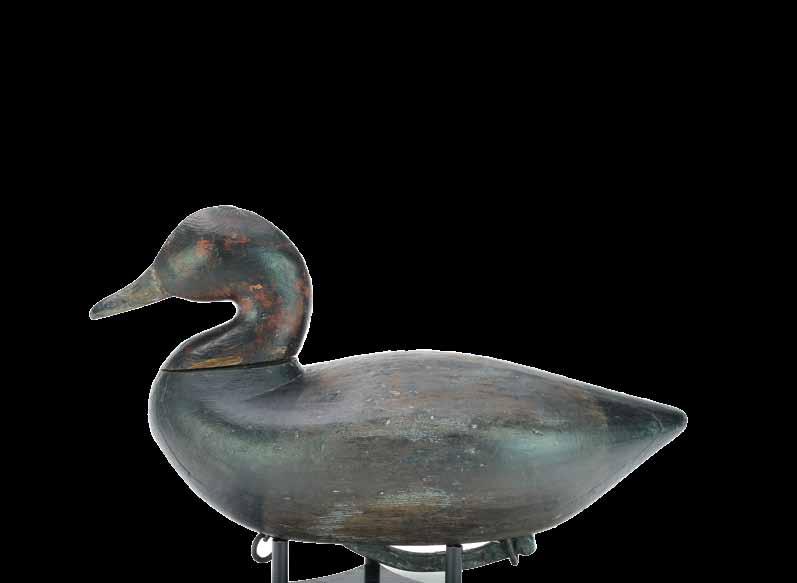
It appears that James Best’s early life was a tumultuous one. His father, Nichodermus, died when he was only 6 years old and, by age 14, he was living with the family of John Hoggard and his wife Sallie while working as a laborer. His mother died when he was 15. He joined the Life Saving Service in 1887 and, in 1889, while working as a surfman at the Kill Devil Hills Station, he married Mary H. Baum. Tragically, the couple lost all three of their children before any of them had lived more than one year. To add to the pain, Mary, age 26, died in 1897. In 1899, he remarried, this time to Mary F. Meekins, and in 1901, he
was stationed at the Kitty Hawk station. He worked there continuously through the merging of the Life Saving Service with the US Coast Guard in 1915 and, with the closing of the Kitty Hawk Station in 1921, he retired the following year with a rank of surfman.
Unlike most carvers of decoys, Best was not considered particularly fond of hunting, at least not ducks and geese. He was, however, very skilled with tools and was often called upon to produce decoys for others and is probably best remembered for his majestic geese or swans that he carved from the masts of schooners that had wrecked off the treacherous coast of the outer banks. He is known to have spent what would be considered an inordinate amount of time on individual decoys, striving for perfection in his work. He was fond of shorebird shooting but, after his death, in 1967, his grandson was called upon to clean up his property and a barn, containing two large boxes of his shorebirds, was bulldozed and burned.

134A James Best, (1866-1933) Kitty Hawk, North Carolina. Sculptural redhead with raised neck seat and iron spike weight. From the Ashburn rig. Measures 13.5” long. Worn old paint with many small dents and shot marks; tight drying cracks in body; slight separation and a small chip on one side of neck seat; X-ray shows it to be the original head.
Literature: “Gunnin’ Birds,” Kroghie Andresen, p. 362 and 368. (3,000 - 5,000)
Until the 1980s, most collectors generally accepted the idea that there were no examples of handmade, quality decoys from South Carolina. This ultimately proved to be a myth when, in fact, it became known that a small group of exquisitely sculptured birds was known, and all of these seemed to have originated from an area in the vicinity of Georgetown. The existence of these birds was known to very few and was a closely guarded local secret. Eventually it became known that these decoys were made by a group of brothers who were raised in the marshes north of Georgetown – “Ball” (1849 – 1914), “Sawney” (1859 – 1938), “Pluty” (1869 – 1911), “Hucks” (1876 – 1944) and “Bob” (1879 – 1923) – the Caines brothers.
They lived in an area that was originally settled by their grandparents, known as Caines Village, a locale fronting on Muddy Bay facing Pumpkinseed Island. They made their livelihood from the surrounding land and waters. They cultivated and harvested rice, worked as commercial fisherman, guided, and gunned for the market. These hunting ventures eventually led to their carving their own decoys.
In 1905, the coastal plantations, including Caines Village which had been a part of the Michaw plantation, were purchased by wealthy businessman and Statesman Bernard M. Baruch. The land on which the Caines lived became part of his famous 17,500 acre estate – Hobcaw Barony. As was the tradition, when Baruch purchased the plantations, the tenants and their settlements were included in the purchase. Suddenly, the land they had hunted for years was now posted and the brothers were forced to poach in order to continue to earn a living. In his autobiography, Baruch recalls apprehending Hucks Caines one morning with 166 black ducks and mallards in his possession. Hucks was quickly hired by Baruch to do what he had always done – hunt ducks. From this point on however, he was required to take Baruch’s guests out hunting with him. Eventually, Hucks became Baruch’s favorite guide. All of the Caines brothers, with the exception of Ball, eventually worked for Baruch.
The brothers probably only made a few hundred decoys but only 50 or so remain in existence today, the majority having fallen victims to fire, neglect, and insects. The brothers knew Hobcaw well, and all five are laid to rest with family members in a cemetery located on the Barony, not far from the bay itself.


135 Caines Brothers, Georgetown, South Carolina, late 19th century. Very appealing mallard hen with deep relief heart pattern wing carving. Reared back head and upswept tail. Made for use at Hobcaw Barony, near Georgetown, South Carolina. Measures 16.25” long. Early and appealing in use repaint by the Caines Brothers with moderate flaking and wear; at some point the bill was broken off and reattached by Caines who used lead caulking in that area and at neck seat; when the decoy was discovered at an auction in the 1990’s it had been fitted as a lamp, a small hole in the back was then plugged and touched up

Provenance: Discovered and purchased from an auction in the 1990s by Dick McIntyre. Collectible Old Decoys collection. Alan and Elaine Haid collection (sold by Guyette & Schmidt, April 2006). Jim and Jean Barrow collection (sold by Brunk Auctions, May 2023). Private southern collection.
Literature: “Art to Capture Nature, The Southern Decoy as an Art Form” by Dick McIntyre, page 7 & back cover, related examples illustrated. “Caines Brothers Decoys, Birds of Great Distinction” article by Dick McIntyre, Decoy Magazine, March/April 1989, pages 8-13, related examples illustrated. “Southern Decoys of Virginia and The Carolinas” by Henry A. Fleckenstein Jr., pages 246-248, related examples illustrated. “North American Decoys Magazine”, Oct-Dec 1978, pages 6-10, related examples illustrated. (40,000 - 60,000)
b. 1947 | Cape Charles, Virginia
“Frogs and turtles were always a favorite of mine growing up - like most kids, I caught (and released them), and my father would tell me tales of him trapping them for food during the depression. The various species and colors of these creatures continue to amaze me, so, unsurprisingly, they frequently become subjects for my art. I think this piece, while whimsical, still highlights the natural features and appeal of these often overlooked pond dwellers.”
- Frank Finney



136 Frank Finney (b.1947), Cape Charles, Virginia. Outstanding full size turtle and bull frog with bag of loot. Bull frog reading the Pond Gazette with headlines “Major Jewelry Heist : Two Suspects on the Run”. Turtle’s shell is hinged and opens to a storage compartment. Maker’s initials carved on underside. Measures 25” long, stands 14” tall. Excellent and original. (12,000 - 18,000)

137 Frank Finney (b.1947), Cape Charles, Virginia. Miniature standing fox juggling eggs. Titled “Playing with his Food”. Turned head and open mouth. Four eggs up in the air, and two carved eggs on base that were dropped and cracked. Maker’s initials carved in underside. Measures 10.5” tall.
Excellent and original. (3,000 - 5,000)
138 Frank Finney (b.1947), Cape Charles, Virginia. Full size chipmunk eating peanuts. Turned head with full cheeks and arm extended offering a nut. Maker’s initials carved in underside. Stands 6” tall. Excellent and original. (3,000 - 5,000)


139 Frank Finney (b.1947), Cape Charles, Virginia. Miniature walking beagle. Maker’s initials carved on underside. Measures 9” long, stands 7.5” tall. Excellent and original. (3,000 - 4,000)



140 Frank Finney (b.1947), Cape Charles, Virginia. Excellent preening swallow with raised wings and split tail carving. Relief carved wing and tail feathers. Maker’s initials carved in underside. Measures 10” long, stands 5.5” tall. Tightly reglued chip in one tip of tail, otherwise excellent. (2,000 - 3,000)
140A Frank Finney (b.1947), Cape Charles, Virginia. Large curlew with split tail carving and applied head. Measures 18.5” long. Made to appear older with some flaking and wear; some areas of sap bleed, otherwise excellent and original. (1,500 - 2,500)
140B Frank Finney (b.1947), Cape Charles, Virginia. Black headed grosbeak. Relief tail feather carving. Maker’s initials carved in underside.
Measures 4.75” long. Excellent and original. (500 - 800)

140C Frank Finney (b.1947), Cape Charles, Virginia. Eastern towhee. Relief wingtip and tail feather carving. Maker’s initials carved in underside.
Measures 4.75” long. Excellent and original. (500 - 800)

140D Frank Finney (b.1947), Cape Charles, Virginia. Yellow throated vireo. Raised, extended wingtips and relief tail feather carving. Maker’s initials carved in underside. Measures 5” long. Excellent and original. (500 - 800)

140E Frank Finney (b.1947), Cape Charles, Virginia. Slate colored junco. Relief tail feather carving. Maker’s initials carved in underside. Measures 4.5” long. Excellent and original. (500 - 800)



141 Frank Finney (b.1947), Cape Charles, Virginia. Hollow carved preening woodcock with outstretched wings and relief feather carving. Maker’s initials carved on top of base. Measures 7.5” long, stands 8” tall. Some small spots of discoloration on top of base, otherwise excellent and original. (1,200 - 1,800)

142 Frank Finney (b.1947), Cape Charles, Virginia. Miniature golden pheasant with relief wing carving, extended tail, and head turned 90 degrees. Maker’s initials and ink stamp on the underside. Measures 9” long. Excellent and original. (1,000 - 1,400)



144
143 Frank Finney (b.1947), Cape Charles, Virginia. Turkey box call. With applied decorative handle at base with Frank’s “F” carved in the shield area. Handle is a tom gobbler. Natural wood is slightly tiger striped and darkened. The pin holding the paddle appears to be carved bone. Call measures 10” long. (2,000 - 3,000)
144 Frank Finney (b.1947), Cape Charles, Virginia. Turkey call made from a bull horn with inset decorative bone depicting a bursting sun on one side with a moon and stars depicting night on the other, with Frank’s serifed “F” scratched in the center. A piece of deer bone with a wooden tip scratches the inset slate piece with vocalization exiting the large end of the hollow horn. Call Measures 10”. (2,000 - 3,000)

145 Eddie Wozny (b.1959), Cambridge, Maryland. Wall hanging gobbler turkey in flight. Relief carved wing and tail feathers. Approximate 5.5” carved and inserted beard. Head is a superb execution of a gobbler turkey with beak open and glass eyes. This is approximately 2/3 size, with a wingspan of 29”. Measures 27” from beak to tail. Excellent in all respects. (4,000 - 6,000)


146 Eddie Wozny (b.1959), Cambridge, Maryland. Miniature ocellated gobbler in full strut. Mounted to decorative base which is signed by the maker. Highly detailed carving and painting. Glass eyes. Stands 6” tall. Excellent and original. (1,500 - 2,500)


147
148 Eddie Wozny (b.1959), Cambridge, Maryland. Morning dove with slightly turned head and raised wingtips. Relief wing and tail feather carving. Identified, signed, and dated 2005 on the underside. Measures 10.5” long, stands 7” tall. Excellent and original. (800 - 1,200)
147 Eddie Wozny (b.1959), Cambridge, Maryland. 1/4 size standing turkey. Slightly turned head and relief feather carving. Identified, signed, and dated 2007 on underside. Painted oak leaves on top of base. Measures 13.5” long, stands 11.25”tall. Excellent and original. (1,000 - 1,500)

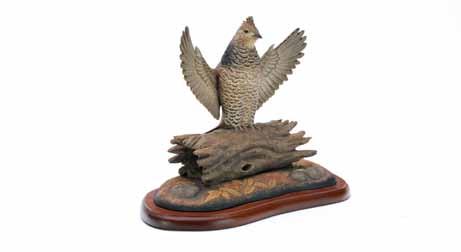
148A Eddie Wozny (b.1959), Cambridge, Maryland. Miniature drumming grouse. Fancy carved base with fallen leaves and carved hollow log. Standing grouse with wings outstretched in the process of territorial drumming. Detailed relief feather carving and fanned out tail. Signed on the underside of the base. Measures 6.25” tall including base with a 5.5” wingspan. Mint. (1,200 - 1,800)

150 Oliver Lawson (b.1938), Crisfield, Maryland. Decorative greenwing teal with raised, extended wingtips and detailed feather carving. Signed and dated 1976 on driftwood base. Measures 10.5” long. Excellent original paint that has mellowed with age; crack in each lead leg and a few small spots of discoloration on front of head.
(2,500 - 3,500)
149 William Gibian (b.1946), Onancock, Virginia. California towhee on peach. Relief wing and tail feather carving. “Gibian” carved in underside of bird. Maker’s business card glued to underside of base. Measures 10” long, stands 8” all. Excellent and original. (1,000 - 1,500)


151 Robert Ptashnik ( -1993), Ontario, Canada. Excellent decorative avocet. Tucked head and raised, crossed wingtips. Highly detailed feather carving. Signed and dated 1984 on back of driftwood base. Measures 14” long, stands 10.5” tall. Tiny spot of touchup on one side of breast, otherwise excellent and original. (1,200 - 1,800)


152 Steve Weaver (b.1950), Cape Cod, Massachusetts. Excellent decorative ruby throated hummingbird. Signed and titled “Bejeweled” on the underside of base. Maker’s initials on top of base. Flowers are carved wood. Measures 9.5” tall, hummingbird measures 3.75” long. Excellent and original. (3,500 - 4,500)


Lester Braddock
Union, Maine. Decorative gold crowned kinglet. Standing on branch with outstretched wings. Relief wing and tail feather carving. Very nice paint detail. Measures 13.5” tall including base. Kinglet with a 3.5” wingspan. Excellent and original.
(800 - 1,200)
154 Peter Kaune, Montana. Decorative gnat catcher on metal branch. Dropped wingtip and detailed feather carving. Measures 4” long, stands 18.75” tall. Excellent and original.
(600 - 900)


155 Jim Hazeley. Highly decorative preening barn swallow. Standing on barbwire perch with outstretched wings and detailed feather carving. Identified and signed on underside of base.
Measures 6.75” long, stands 12” tall. Chip in one extended tail feather, otherwise excellent.
(600 - 900)
156 Peter Kaune, Montana. Decorative greentailed towhee on metal branch. Slightly turned head and raised wingtips. Detailed feather carving. Signed and dated 11. Measures 6.25” long, stands 14.25” tall. Excellent and original.
(600 - 900)


bunting on metal branch. Calling pose with open beak and extended tongue. Highly detailed feather carving. Signed and dated 6/92. Measures 5.25” long, stands 9” tall. A few tiny paint flakes from metal leaves, otherwise excellent and original. (600 - 900)
Peter Kaune, Montana. Decorative Bullock’s oriole on metal branch. Relief wing carving with extended wingtips. Highly detailed feather carving. Signed and dated 2002 on underside. Measures 7” long, stands 13” tall. Excellent and original. (600 - 900)


Peter
Montana. Decorative junco on metal branch with extended wingtips and detailed feather carving. Signed and dated 6/2001 on underside. Measures 5.5” long, stands 11.5” tall. Excellent and original. (600 - 900)
160 Peter Kaune, Montana. Decorative fly catcher on metal pine branch. Turned head with fly clutched in beak. Raised wingtips and highly detailed feather carving. Signed and dated 6/90 on underside. Measures 4.5” long, stands 16” tall. Excellent and original. (600 - 900)


161 Peter Kaune, Montana. Decorative rock wren in calling pose with open beak and extended tongue. Relief wing carving and highly detailed feathers. Signed and dated 05 on the underside. Measures 5” long, stands 12.25” tall. Excellent. (600 - 900)
162 Peter Kaune, Montana. Decorative Phainopepla on metal twig branch. Slightly turned head with extended crest feathers. Relief wingtips and highly detailed feather carving. Signed and dated 6/03 on the underside. Measures 6.5” long, stands 16” tall. Excellent and original. (600 - 900)


163 Peter Kaune, Montana. Decorative chickadee. Plump little bird with relief wingtip carving and highly detailed feathers. Signed on the underside of base. Measures 4.25” long, stands 12”. Excellent and original. (600 - 900)
164 Peter Kaune, Montana. Decorative cactus wren with slightly turned head and open beak. Relief wing carving and highly detailed feathers. Signed and dated 6/94 on the underside. Measures 7.5” long, stands 13.25” tall. Tiny paint flake on tip of beak and a small reset chip on cactus at lower left foot, otherwise excellent. (600 - 900)
Phippsburg, Maine has a history dating back to early colonial times, and the Wallace family has been deeply entwined with the community, as well as that of neighboring Harpswell, for practically the entire period. The town is on a rather narrow peninsula jutting into the Atlantic with the New Meadow River to the west and the famed Kennebec to the east. At its very tip lie the tiny communities of Small Point and West Point, home to numerous members of the Wallace family, a great many of whom are known to have carved decoys.
The decoy being offered here is attributed to an Irving Wallace of Small Point. There was an Irving Jewett Wallace (1875 – 1965) that was born and died in Phippsburg. His father was a sailor/fisherman, and after an eighth-grade education, Irving also entered the fishing/lobstering trade. In 1904, he married local girl, Julia Sweeney, and the couple had three sons, two of which also became fisherman. For a period, he apparently sold his catch, both wholesale and retail, and he remained an active fisherman/lobsterman until he was at least 75.
His story would seem typical and answer any questions regarding the attribution, but it becomes complicated. As noted, the Wallace clan was a large and established one at the tip of Phippsburg. Members of the family often repeated common names and first and middle monikers were often interchanged in their daily lives to distinguish one member from another. This, coupled with the use of nicknames, makes trying to research any one individual a distinct conundrum. Such is the case with birds attributed to “Irving Wallace”. The Irving J noted above lived for a period on West Point Rd. One of his neighbors on the same short street was Jessie Irving Wallace (1883 – 1947). Jessie’s father was also named


Jessie, so his son often referred to himself in various documents as Irving or Irving J. Likewise, there was another Irving S Wallace (1879 – 1941) that resided in nearby Harpswell, that had an almost identical life story. In the final analysis, it would certainly be possible that someone other than the Irving J noted in the attached obituary and referred to above was the actual carver of the decoy.
As noted, numerous members of the Wallace family are known to have carved decoys. The work of men such as Amos Wallace (1882 – 1968) and others are all distinguished by a high degree of craftsmanship. Perhaps, at some point, additional research will identify the Wallace patriarch that instilled such artistry in family members that would follow.




(25,00 - 35,000)
165 Attributed to Irving Wallace, Small Point, Maine, early 20th century. Excellent and unused rigmate pair of red-breasted mergansers. Long bodies with inlayed neck seats and extended crests. Measure 21.5” and 19.25” long. Original paint with minor rubs and wear; appealing tightly crazed surface on white areas; tiny chip at the tip of each crest; tiny chip and roughness on tip of drake’s bill.

1838 - 1888 | Deer Isle, Maine


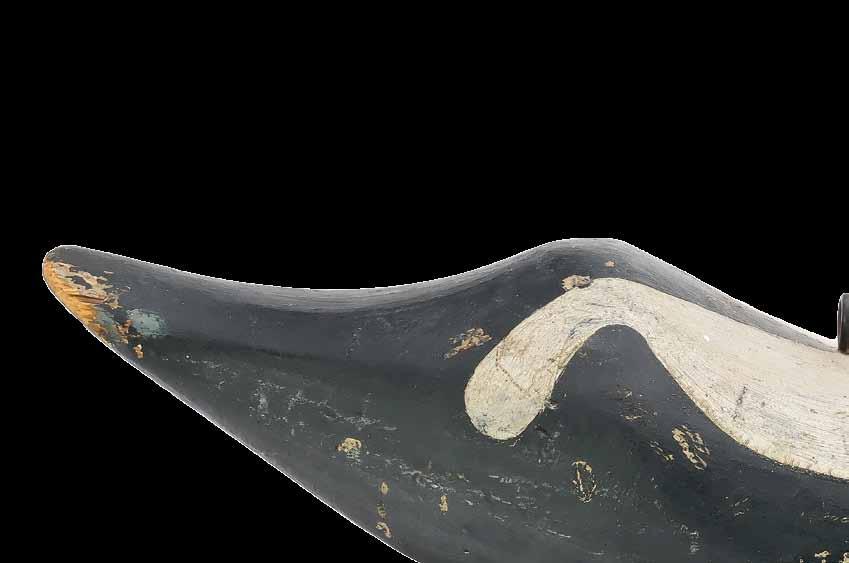


166 Eben Weed Eaton (18381888), Deer Isle, Maine. Sculptural eider with long inlayed neck seat. So called “rocking horse” style body. Relief bill carving and slightly raised crest down center of head. Measures 18” long. Very early in use repaint over the original pattern; shows moderate flaking and wear; minor roughness on edge of tail; separation at neck seat; lightly hit by shot.
Provenance: Gene and Linda Kangas collection.
(15,000 - 25,000)
The town of Harpswell consists of a series of peninsulas and islands that extend, fingerlike, into Casco Bay, Maine. It was, and remains, home to a number of small, scenic, unspoiled, working villages, each with its own identity, and most with their own harbor. It was a favored haunt of pioneer collector George Ross Starr in the 1950’s. His were the type of adventures that most collectors have never experienced and can only dream about. Decoys were seemingly to be had in almost every harbor, tucked away in boat houses, fish shacks, lofts or basements. Most were either retired or on the verge of being so as the newer, “modern” decoys were entering the scene. To the disgruntlement of the aging population that had made and used the old wooden “tollers”, laws were changing, and hunting was just not the same. Accordingly, their decoys had little value other than sentimental and were ripe for the picking. On the opening pages of his groundbreaking book, “Decoys of the Atlantic Flyway” Starr describes one such visit that brought him to the tiny hamlet of Cundy’s Harbor. The story is now very well known, and one that has become legendary in the decoy collecting community.
With only a few omissions, Willie’s simple life was well documented in his obituary. His father was a sea captain and built the home in which Willie was living at the time of Starr’s visit. He had probably lived there his entire life. In 1895, he married the local schoolteacher Julia F Thompson. They were both 24 years old and they raised three children before her death in 1936. Willie had already made the loon by the time of this first marriage due to his statement that he made the decoy in 1887 when he would have been 16. This would seem to be quite a woodworking accomplishment for a young man of that age but, in typical coastal Maine fashion, you didn’t buy something if you could make it! The decoy could have been used until the passing of “The Migratory Bird Act” in 1918 but this may or may not have been taken seriously by the locals. In Willie’s own words: “Aya, those were the days! Shoot from ‘see to see’ the year round, and no one to tell you how many you could or couldn’t shoot - - - - “. When Willie remarried in 1939,


he gifted the loon to his second wife and, presumably they shot over it together. She treasured it because: “(It) - - - had been a symbol of the good things for her and Willie for many years” but, she also stated: “I don’t reckon I’ll be doing any more gunning (this year)”.
Starr truly treasured the decoy, and it remained a focal point in his outstanding collection until the time of his death. He considered it a New England Classic, proclaiming: “Certain decoys are such outstanding examples of the decoy maker’s art that they are the ‘classics’ of the decoy world against which all other birds should be judged” and this loon is “- - - one of the finest examples of decoy design and construction that I have ever seen”. Likewise, author and senior collector Gene Kangas saw the decoy as: “An integral part of American History”.

166A Willie Eastman (1871-1956), Harpswell, Maine. Large hollow carved working loon with inlayed neck seat. Loon is hollowed from the underside with applied canvas covering. Paper label and remnants of ink stamp from the collection of Dr. George Ross Starr. Also with remnants of ink stamp from the collection of Roger Williams. Measures 30.5” long. Mix of original and early in use touchup; shows moderate flaking and wear; small dents and shot marks; many tight drying cracks; and separations to wood grain on sides; neck seat was constructed from three pieces of wood with separation at seems; crack through neck with a small chip missing from one side; tight drying crack in one side of head was filled and touched up.
Provenance: Dr. George Ross Starr Jr collection. Roger Williams collection. Gene and Linda Kangas collection.
Literature: “Decoys of the Atlantic Flyway” by Dr. George Ross Starr Jr., page 142, exact decoy pictured. (20,000 - 30,000)



167 Augustus “Gus” Wilson (1864-1950), South Portland, Maine. Early scoter with slightly turned breast, preening head. Large inlayed neck seat and relief wing carving. Measures 16” long. Mostly original paint under a thin coat of varnish; moderate gunning wear; small dents and shot marks; cracks at back corners of neck seat; drying split along the underside. (5,000 - 8,000)
168 Augustus Aaron Wilson (1864-1950), South Portland, Maine. Flying mallard. Applied, carved feet. Incised feather carving on wings. “MD17” stamped in underside. Measures 23” long, with a 26” wingspan. Original paint with very minor wear under an old coat of varnish that has darkened slightly; tight cracks in underside and along wings; wooden patch along the back from when the decoy was made.
Provenance: Gene and Linda Kangas collection. (3,000 - 5,000)


169 Unknown maker, early 20th century, Westport, Massachusetts. Red-breasted merganser with carved eyes and incised bill carving. Two piece head and neck with slightly extended crest. Measures 14” long. Original paint with minor to moderate wear; hairline crack along the back; lightly hit by shot; hairline drying cracks in breast; small wooden patch on tail appears to be from when the decoy was made; approximately half of the bill is a professional replacement. (3,000 - 4,000)
170 George Boyd (1873-1941), Seabrook, New Hampshire. Canvas over wood frame Canada goose with shoe button eyes. Measures 27” long. Original paint with minor to moderate wear; surface has darkened with age; old tear across canvas at tail; chip in one side of bill tip was repaired; small spots of black touchup on head and bill.
Provenance: Dan Graf collection. (3,000 - 5,000)

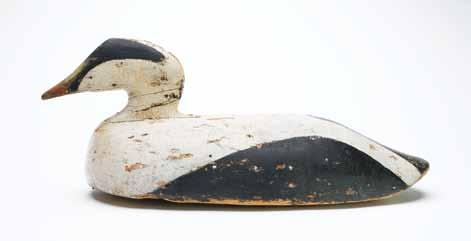


171 William Harnden Foster (18861941), Massachusetts. Hollow carved black duck with deep relief wing carving and raised wingtips. Doweled head is removable by turning it to match a recess carved in the neck seat. Measures 17.25” long with head in forward pose. Original paint with minor wear; very good structurally. (1,500 - 2,500)
172 Everette Sinnett (1863-1943), Harpswell, Maine. Oversized eider with inlayed neck seat and relief bill carving. Measures 24.5” long. Very early in use repaint with moderate flaking and wear; heavily hit by shot; hairline cracks in body; tight cracks in neck with old nails added to secure. (2,500 - 3,500)
173 Augustus Aaron Wilson (18641950), South Portland, Maine. Red breasted merganser with inlet head turned 90 degrees to one side. Relief wing carving and applied leather crest. Measures 18” long. Mix of original and repaint that has been taken down to the original pattern; tail chip repair; minor roughness on tip of bill; old cracks in neck with some separation.
Provenance: Gene and Linda Kangas collection. (2,000 - 3,000)
173A Wendell Gilley (1904-1983), South West Harbor, Maine. Hollow carved scoter with removable head that can be set in four different positions. Measures 21” long in forward head pose. Original paint with moderate wear; mostly around one side of body seam; tight crack in back near tail; separation to bottom body seam; tightly reglued chip in underside of bill tip.
Literature: “Decoys of the Atlantic Flyway” by Dr. George Ross Starr Jr., page 141, exact decoy pictured. (1,200 - 1,800)
174 Willie Ross (1878-1954), Chebeague Island, Maine. Red-breasted merganser hen with inlayed neck seat and inserted paint bristle crest. Tim Eastland collection ink stamp on the underside. Measures 17.25” long. Original paint with moderate to significant wear; tight drying cracks in body and one side of head; minor roughness on edge of tail; professional neck crack repair; like most Ross mergansers the original peacock plum crest was missing and replaced.
(1,500 - 2,500)
175 Clarence Bailey (1882-1952), Kingston, Massachusetts. Oversized canvas scoter. Measures 20.75” long. Original paint with minor to moderate flaking and wear; minor roughness on tip of bill.
Provenance: Dan Graf collection.
(1,500 - 2,500)
176 Attributed to William Frank Dennis, Marblehead, Massachusetts. Merganser hen with wooden keel and partially inlayed neck seat. Measures 16.25” long. Original paint with minor to moderate wear; short propeller strike on one lower side; hairline crack through neck; minor roughness on tip of bill.
Provenance: Dan Graf collection. (800 - 1,200)



177 Roy Patterson, Massachusetts. Brant with slightly turned head and deep relief feather carving. Two-piece head and neck. Maker’s brand on the underside. Measures 23” long. Mix of original and later touchups; showing minor discoloration and wear; small dents and hairline drying cracks including one across front of upper neck.
Provenance: Dan Graf collection. (800 - 1,200)




178 A. Elmer Crowell (1862-1952), East Harwich, Massachusetts. Early preening black duck with raised crossed wingtips and relief tail feather carving. Chip carving between raised wingtips and tail. Measures 16.5” long. Original paint with significant flaking and wear; down to much bare wood; small dents and shot marks; old chipping and roughness on edge of tail. (20,000 - 30,000)


179 A. Elmer Crowell (1862-1952), East Harwich, Massachusetts. Very early black duck with relief tail carving and slightly turned head. Pre-brand model. Measures 16.5” long. Original paint with moderate wear; significant flaking on one side of head; many drying cracks in body; minor roughness on edge of tail and bill tip; old chip in one side of neck seat. (3,000 - 4,000)
180 A. Elmer Crowell (1862-1952), East Harwich, Massachusetts. Black duck with slightly turned head. Relief wingtip and tail feather carving. Maker’s rectangle stamp on the underside. Decoy was never rigged or weighted. Measures 16” long. Original paint with very minor wear; many thin .25” dents along back and top of head and bill; filler used at a defect in wood on back when the decoy was made. (4,000 - 6,000)

Wheeler’s decoy production was limited and was never a commercial venture. He carved for his own pleasure and refused to sell his birds, giving most away to friends as gifts. His early birds were strictly for gunning the marshes at the mouth of the Housatonic River but his abundant artistic flair and talent finally led him to competition carving. In 1923, he entered the first Bellport, New York Decoy Show wher e he won first place in the amateur category. For twelve consecutive years he won first prize in the amateur category of the International Decoy Makers contest held annually at the Sportsman’s Show in New York City. He finally withdrew from competition feeling that “it was time to give somebody else a chance.”
He is renowned today as a member of Connecticut’s leading decoy triumvirate consisting of Albert Laing, Ben Holmes, and himself. His carvings certainly represent the Stratford School of carving at its pinnacle of perfection. His keen eye observed all the nuances of each species’s anatomy and feathering and are faithful reproductions of nature and accomplished works of art. Although he carved a wide variety of species for competition, he seems to have lavished most of his love on the black duck. It is said that “imitation is the greatest form of flattery” and Wheeler’s efforts were the inspiration for a host of Connecticut carvers to follow. Men such as Rathmell, Welles, Disbrow, Merwin, Bliss, and Breit, to name a few, followed closely in his footsteps and clearly reflect his influence in their work.


181 Charles E. ‘Shang’ Wheeler (1872-1949), Stratford, Connecticut. Exceptional hollow carved gunning black duck with scratch feather paint detail on head. Slightly turned head and subtle wing carving on back. Measures 19” long. Near mint original paint with a small flake on tip of tail; small dent in top of head and a tiny chip on one side of bill tip; a very fine hairline separation at neck seat, otherwise excellent.

Provenance: Made by Wheeler and given to William B. Smith, a Stratford sportsman, hunting companion, and friend of his.Private Southern collection.
Literature: “Shang,” Dixon Merkt. “Connecticut decoys,” Henry Chitwood. (20,000 - 30,000)
Born in Rahway NJ, Laing was only nine when the family moved to Manhattan, NY, and his father, Hugh, established a successful business adjacent to the famous Fulton Fish Market. The family was soon living at “Langside,” a 110 acre property on the East River. By the age of 20, Laing began his market gunning career to supply fresh game to the market and, in so doing, became one of the earliest documented American decoy carvers. In about 1836, he began to employ the use of a battery, and he also seemed to have used some sort of punt gun. Eventually, he is reported to have carried his battery and the large rig of decoys to the Chesapeake and Philadelphia regions in pursuit of the more lucrative canvasbacks. Unfortunately, there is a large gap of time in his journal between 1838 and 1863 where his activities and location become vague. The New York City directory in 1857 recorded him as living back in Manhattan in the Bucklands Hotel. In the 1870 census, he as listed as a “broker,” and in the 1880 census as “retired from the Hotel and Club business.”
He must have succeeded in whatever his business ventures were because, in 1863, he purchased a home and ten acres on the banks of the Housatonic River in Stratford, CT which became Albert Laing’s gentleman’s farm. By 1863, he was going on no more than five hunts per season, and he, apparently, ceased all hunting by 1871.
He was estranged from his family and was a childless bachelor. By age 75, he was going blind and becoming increasingly despondent. Albert Laing died from a single, self-inflicted guns hot from his own duck gun.
He may have given some of his decoys away over the years, and he likely lost or damaged some while hunting. His total lifelong production has been estimated at no more than 150. Early Stratford hunters such as Ben Holmes were aware of his carvings and rapidly adopted his designs. Upon his death, he willed his remaining rig of 111 decoys to the Beers family with the stipulation that they all be sold for $45!
His impact on decoy history is immense and almost unmeasurable. It is best described in the words of those that have written the most about him.
“No single individual ever exerted a more direct or lasting infl uence on the design and making of decoys. Albert Laing must be ranked as one of our greatest decoy makers.” When discussing a particular sleepi ng black duck: “The black duck by him in plate 46 is to a decoy collecti on what a Rembrandt is to an art museum.”
– William J. Mackey, Jr.
“Among collectors today, no name is held in higher esteem than Albert Laing. He is acclaimed as the father of the Stratford Sc hool and recognized as one of the greatest decoy carvers who ever lived. ”
– Henry C. Chitwood
“Laing was an innovator, and he was the first, if not the first e ver, to make hollow floating decoys – a model that became the norm in many pa rts of North America in the second half of the nineteenth century.”
– Robert Shaw


182 Albert Laing (1811-1886), Stratford, Connecticut. Hollow carved sleeping bluebill. With original Stratford style weight. Measures 13.5” long. Early in use repaint by Shang Wheeler with moderate discoloration and wear; small dents and shot marks; hairline crack in one side and in breast.
Provenance: Gene and Linda Kangas collection. (12,000 - 18,000)


Seagulls are one of the rarities in the decoy world. Those that were made were intended as confidence birds, meant to instill a sense of calm and security to incoming targets. Not every hunter used a confidence decoy and those few that did only required a single example. Bill Mackey felt that: “There is only one bird that is not shot in its own right and is helpful in luring birds of another species within gunshot. - - - The only true confidence decoy is a gull decoy”. Gulls are occasionally found elsewhere along the flyway, but some of the finest, early examples, from the collections of Mackey, Barber and Starr, were all from Long Island.
When discussing an example from the south shore of Long Island in his own collection Mackey wrote: “In this region, if anywhere, were made the perfect gulls from the collector’s standpoint” and “Generally, gull decoys from Long Island - - are real prizes - - “. Earlier, Barber, who owned three Long Island examples, felt that some of the sea gulls from this area represented “fine examples of the decoy makers art”.
A rigmate to the gull being offered here was proudly included in the Doc Starr collection and is prominently pictured both on the cover and in color plate 31. His gull was a gift from a gentleman on Long Island who told Starr that he had found the bird in a barn in Southampton and that “Nothing of (its) early history is known”. A little math indicates that this gentleman found the bird c1935 or perhaps earlier. Starr obviously greatly admired this gift, and he describes it in his book as follows:
“The body is solid and bears no marks of identification, and the low lines contrast with the stately erect head. The carving is deep and sure. The great crossed primaries stand free of the broad, flat tail. The paint is original and covered now with a fine crackle effect from exposure to weather”.
Starr goes on to write that, shortly after receiving his gull, a rigmate was found in a New York antique shop that he felt sure was “by the same hand”, again with no history attached. It is unclear if Starr acquired this (antique shop) gull but neither example was included in either the 1983 Willis Henry “boat yard sale” nor the 1986 Bourne sale of the Starr collection. There is a distinct possibility that the gull being offered here is this second gull referenced by Doc Starr. It would be a genuine prize in any mature collection.


183 Unknown maker, 1st quarter 20th century, Long Island, New York. Oversize confidence herring gull with carved shoulders, split tail, and carved extended wingtips. Measures 26” long. Original paint with even wear; scratches and rubs have exposed bare wood; cracks and blunting at tail, with some filler and touchup in the area; reglued chip on one side of raised wingtip; an early split in underside.
Provenance: Gene and Linda Kangas collection.
(20,000 - 30,000)


184 Obediah Verity (1813-1901), Seaford, Long Island, New York. Yellowlegs with deep relief wing carving and carved eyes. Measures 11.75” long. Original paint with minor wear; lightly hit by shot; small chip at back of stick hole; small amount of touchup at each eye. (10,000 - 14,000)

185 Obediah Verity (1813-1901), Seaford, Long Island, New York. Small black bellied plover with deep relief wing carving and carved eyes. Measures 9” long. Original paint with moderate wear; surface has darkened with age; heavily hit by shot; black on breast is a very early second coat; small chip at stick hole; bill appears to be a very early replacement.
Provenance: Tom Karras collection. (5,000 - 8,000)


187 Andrew Verity (1881-1976), Seaford, Long Island, New York. Black bellied plover in alert head pose. Wide body with relief wing carving and carved eyes. Measures 10.5” long. Original paint with moderate wear; lightly hit by shot; hairline crack in top of head; bill is a modern replacement. (2,500 - 3,500)
186 Obediah Verity (1813-1901), Seaford, Long Island, New York. Small sanderling with deep relief wing carving and carved eyes. Measures 6.5” long. Original paint with minor flaking and wear; lightly hit by shot; much of the bill is a professional replacement.
Provenance: Bud Ward collection. Mike and Ginger Raffia collection.
(5,000 - 8,000)
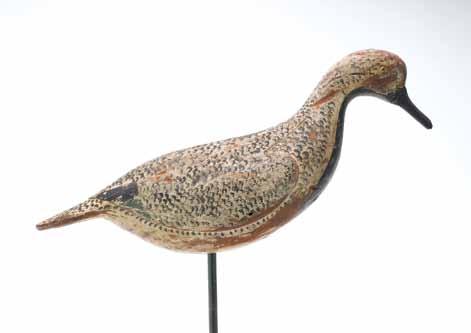


188 Alonzo Foster (1841-1913), Hampton Bays, Long Island, New York. Rare turned head curlew. Measures 10.75” long. Original paint with minor to moderate wear under a thin coat of varnish; a few small dents and shot marks; bill is a professional replacement with small amount of touchup where bill meets face and near a fine hairline crack on top of head; one edge of tail with a professional chip repair.
Provenance: Mike and Ginger Raffia collection. (6,000 - 9,000)


189 Thomas Gelston (1850-1924), Quogue, Long Island, New York.
Large curlew with tucked head and relief wingtip carving. Grant Nelson collection ink stamp on underside. Measures 18” long. Original paint with minor wear; spots where the wet paint was pulled before being dry; tight seam around neck where head was reset with small nails added through top of head; bill is a professional replacement.
Provenance: Grant Nelson collection. Private Tennessee collection. (8,000 - 12,000)


190 George Boyd (1873-1941), Seabrook, New Hampshire. Black bellied plover in emerging plumage. With split tail carving and tack eyes. Measures 11” long. Original paint with very minor wear, mostly on edge of bill; two tiny shot strikes on one side of body; otherwise excellent structurally. (5,000 - 8,000)
191 George Boyd (1873-1941), Seabrook, New Hampshire. Early black bellied plover in winter plumage with split tail carving and tack eyes. Measures 11.5” long. Original paint with very minor wear; significant discoloration on front of neck, breast, and underside of tail area; slight separation at a small knot in one side of neck.
Provenance: Dan Graf collection. (2,000 - 3,000)
192 Joseph Lincoln (1859-1938), Accord, Massachusetts. Black bellied plover in emerging plumage with split tail carving and tack eyes. Measures 10” long. Original paint with minor wear; lightly hit by shot, otherwise excellent structurally.
Provenance: Tom Karras collection. (2,000 - 3,000)

193 Joseph Lincoln (1859-1938), Accord, Massachusetts. Golden plover in emerging plumeage with split tail carving and tack eyes. Measures 10” long. Original paint with minor to moderate wear; small chip and roughness on edge of tail and raised wingtip; chipping to eyes; nine shot holes were filled, but not painted; two small spots of touchup on back of head; tight crack in the replaced bill.
Provenance: Tom Karras collection. (1,500 - 2,500)

194 Unknown maker, 19th century, Massachusetts. Black bellied plover with raised wingtips and large bead eyes. Grant Nelson ink stamp on the underside. Measures 11.25” long. Original paint with moderate flaking and wear; small chip in one edge of tail; shallow chips on top of each raised wingtip were shaved down long ago and left unpainted; bill is a professional replacement.
Provenance: Grant Nelson collection. Tom Karras collection. (2,500 - 3,500)




195 Unknown maker, circa 1900, Massachusetts. Plump black bellied plover with wide head and carved eyes. Measures 11” long. Original paint with moderate wear; lightly hit by shot; bill is a professional replacement. (1,200 - 1,800)
196 Bill Harris (1862-1912) Atlantic City, New Jersey. So called Brigantine bullhead black bellied plover. Measures 12.5” long. Original paint with minor wear; lightly hit by shot; old chip in one side of tail; .75” of the bill is a professional replacement.
Provenance: Tom Karras collection. (1,200 - 1,800)
197 Unknown maker, circa 1900, Massachusetts. Lesser yellowlegs with inlayed neck seat and carved eyes. Made by the same hand as lot 195. Measures 10.5” long. Original paint with moderate flaking and wear; iron bill is an early replacement. (1,000 - 1,400)

198 William Bowman (19th century), Lawrence, Long Island. Lesser yellowlegs with deep relief wing carving and raised wingtips. Head is in a slightly nestled or relaxed position. Faint stamp or brand is visible on the back of the bird, part of which reads “Edwards”. Measures 10” long. Original paint with a few shot scars; moderate flaking on one side, mostly on head and bill; significant flaking on the other side that has exposed a well oxidized wood surface; good structurally. (7,000 - 10,000)


199 Thomas Gelston (1850-1924), Quogue, Long Island, New York. Early long bill dowitcher in spring breeding plumage. Small glass tack eyes with raised primary wing carving. Measures 12” long. Strong original paint with some crazing at the breast; couple of tiny small rubs; approximately .5” of tip of bill is a professional replacement.
Provenance: Alan Haid collection. Private Long Island collection. (5,000 - 8,000)



200 Unknown maker, 19th century, New Jersey. Rare and important oversized egret silhouette. Measures 46.5” long, stands 49” tall with base. Old in use repaint with significant crazing and wear; very small chip in underside of bill tip; later repair to a chip in one side of stick hole.
Provenance: William J. Mackey Jr collection. Quintina Colio. John R. Wierdsma collection. Al Marzorini collection.
Literature: “American Bird Decoys” by William J. Mackey Jr., page 56, exact decoy pictured. “American Decoys” by Quintina Colio, page 83, exact decoy picture. “The Flowering of American Folk Art (1776-1876)” by Jean Lipman and Allice Winchester, page 167, exact decoy pictured. “The American Heritage Society Auction of Americana” Sotheby Parke Bernet, November 6-8, 1975, lot 262, exact decoy pictured. (12,000 - 18,000)
201 Chief Eugene Cuffee (18611941), East Hampton, New York. Or Henry Bennett. Full size standing blue heron. Measures 39” tall. Twopiece head and neck with carved eyes. Dropped wing carving and alert head pose. Mounted to base with detailed toes on feet. Original paint with minor to moderate flaking; tight drying cracks; slight separation at seams.
Provenance: Gene and Linda Kangas collection. (3,000 - 5,000)



202 Unknown maker, early 20th century, India. Large heron decoy. So called scabbed construction using multiple pieces of wood on body. Two piece head and neck with extended crest. Hollow carved with two leg holes on underside. Concave area carved in underside of tail. Measures 42” long. Old in use repaint with significant flaking and wear to much bare wood; cracks and separations at seams in body; tiny chip in underside of bill; tight vertical drying crack on one side of head; old chip repair on lower part of tail.
Provenance: Linda E. Johnson collection. Al Marzorini collection. (2,000 - 3,000)
203 Unknown maker, 20th century. Chincoteague, Virginia. Heron decoy. Shows good age. Made from two pieces of wood, probably a branch. Most of the paint has worn away, only leaving traces of color. Purchased in 1969 from famed decoy dealer Miller Jones in Chincoteague, Virginia. Stands 35” high on stand. Original paint with numerous natural age cracks.
Provenance: Charlie Hunter, III collection. Sold in a 1992 Guyette & Schmidt sale, lot 421 February . Ex collection Bobby Richardson. Al Marzorini collection. (1,500 - 2,500)



204 Unknown maker, 19th century, Long Island, New York. Root head heron with removable head. Measures 28” long. Early second coat of paint on body with moderate flaking and wear; many drying cracks along the body with a significant drying split along one lower side; original paint on head and neck has worn down to much bare wood; loss to wood on one side of neck appears to have been from when the decoy was made; chip at neck seat; head may have been from another decoy.
Provenance: Al Marzorini collection. (3,000 - 5,000)

Research about John Blair provided by Jeff Martinides
“The Blair Mystery”, as so eloquently coined by Hal Sorenson in his 1977 article for Decoy Collectors Guide, has puzzled collectors since the name John Blair was first mentioned in the publication of Joel Barber’s seminal tome “Wildfowl Decoys”, the first book published on decoys and decoys collecting, in 1934.
In his book, Barber highlights a pair of Mallards carved by Blair as an example of “outstanding decoys made by men other than established decoy makers, principally sportsmen”. The pair were on loan for illustration from John Blair, Jr., who happened to work with Barber at the same engineering firm in New York. Barber goes on to write “Blair, Jr. went on to explain the fine condition of the original painting, which after 70 years was still perfect; acknowledging that while the decoys were made by his father, a sportsman, the painting was done by a Philadelphia portrait painter of considerable note; the paint being so fine that Blair had individual canvas bags made to protect them.”
In his article, Sorenson seizes on a discrepancy between photographs of a particular pintail drake that Barber attributes to having been carved by John Blair, Sr. and a diagram or drawing Barber made of the same decoy, but titled the drawing as “Maker Unknown, Jersey Shore courtesy of John Blair, Jr.” Sorenson’s article generated much conversation and debate among early collectors, leading to additional questions and theories being put forth, culminating in what is commonly referred to as the “Blair Mystery” concerning the carver and the multitude of decoys historically identified as “Blair School” :
Mystery no. 1: “Who carved the Classic Blairs?”
While we may never know how or why the illustration Barber made of the pintail was titled the way it was, I respectfully disagree with Sorenson’s supporting reference to the “faulty memory of many an old-timer” who misidentify the carver or origin of a particular decoy, and wonders aloud “if it may have been the case with John Blair, Jr. when claiming his father made the decoys.” It appears to me that Joel Barber went to great lengths to credit John Blair, Sr. when discussing both the photographs and actual decoys themselves:
Referencing Plates Nos. 106 and 107, Barber clearly states on p. 138 “These very fine Mallards are the work of the late Mr. John Blair of Philadelphia and Elkton, Md.” and “The pair illustrated were loaned for reproduction by Mr. John Blair, Jr. of New York.” On p. 139 “Mr. Blair later presented me with the Pintail Drake diagrammed on Plate No. 50 and photographed on Plate No. 6. This was also made by his father, similar in construction and painted by the artist”. Closer inspection of Plate No’s. 106 & 107 indicate they were created in 1928, while Blair Sr. was still alive, and John Blair, Jr. was age 47, far too young for memory issues. Finally, John Blair, Sr., Blair, Jr. and youngest son Walter (also referenced in Barber’s book) were all gunners and carvers, sharing a passion for the sporting life. While I am certain that many people may substitute fiction for fact in their memory banks, I think it is highly unlikely that a family who shared both gunning and carving as mutual passions would mistake the identity of their father’s decoys.
Mystery no. 2: “Was Blair a portrait painter? A banker? The wealthy owner of a carriage manufacturer?”
The genesis of this mystery begins with Bill Mackey’s claim that Blair himself was the portrait painter in question, even though John Blair, Jr. identified his father as a “sportsman” in Barber’s book. Sorenson argues against Mackey’s conclusion and then shares his belief that Blair was a banker.... Some years later, the narrative takes another turn, courtesy of the the Bible of Delaware River decoys, “Floating Sculpture”. In it, the authors recount a visit to the Blair family farm in Elkton, MD. and with its current occupant, Colonel John Blair III. Col. Blair remembered his grandfather well, stating that he was a wheelwright and the birds were painted by a trolley painter. The authors go on to postulate that Blair, based on his alleged acquaintances, gun club memberships and purchase of the 138 acre Elkton farm must been the owner of a carriage manufacturer.
And there the lead goes cold, and the mystery remains. However some new information has come to light very recently, that seemingly clears up some long held misconceptions.
205 John Blair, Sr. (1843-1929), Philadelphia, Pennsylvania. Very rare bluewing teal hen. Hollow carved with raised neck seat and tack eyes. Branded “D.V. Allen” twice on underside. Measures 13.25” long. Original paint with moderate wear; many small dents in body; fine puppy chews on part of head and bill; tiny chip at body seam on one side of breast; head is slightly loose.
Provenance: Bruce Williams collection. Private southern collection. (30,000 - 40,000)



205A John Blair, Sr. (1843-1929), Philadelphia, Pennsylvania. Important hollow carved Canada goose. This decoy surfaced in the 1980’s from a rig owned by the old “Egg Island Gun Club” from Long Beach Island, New Jersey. Only a few of these very rare geese are known to exist and only two have retained any original paint. Measures 24.5” long. This decoy, as with the others, has had restoration to much of the surface; what appears to be original paint on underside of body and tail area; several thin cracks in head and a few tight neck crack repairs; one tack eye is missing; shot scar on back.
Provenance: Richard W. Oliver, July 1990 auction catalog. Charlie Hunter collection. Bartlett collection. Private Ohio collection. (25,000 – 35,000)

Extensive research conducted through The Carriage Museum of America, “The Hub” of 1890, which was the preeminent trade journal carriage builders, and “Gopsill’s Philadelphia Business Directory of 1879, 1887 & 1890 indicate that John Blair was not the wealthy owner of a carriage manufacturer, as his name is not included in any business name or advertisement. In fact, searching the Gopsill directories more deeply reveals there are no John Blair’s listed for the following occupations: Carriage & Coach Makers; Wagon Builders; Wheelwrights; Wood Turners; Carvers; Sporting Goods; Shipbuilders; Frame Makers; Clock Makers; Trimmers; Hubs & Spokes; Doll Heads; Engineers; Mechanics; or Painters.
However, upon closer inspection of the US Census of 1900, we can see in the far left margin that John Blair’s address is penciled in as 4936 Franklin Street, Philadelphia, Pa. How do we know this is the correct “John Blair” we are looking for? Because the entry includes what we know to be his wife (Susie) his sons (John Jr. And Walter) and his daughter, Maude.... Interestingly, John Blair also had a younger daughter, Annie, a sickly girl who passed away at age 15.... I mention this as Blair was initially investigated (found not guilty) of contributing to her death by discipling her with a severe whipping for misbehavior (The Times of Philadelphia, 1/17/1899).
John Blair resided in the Frankford section of Philadelphia, ward 23, at 5034 Franklin Street (1879) and then 4936 Franklin Street from 1883 until 1905, when the family moved to Elkton where he lived until his death. This period encompasses 50 years (age 36 - 86) certainly the prime of his life. Using records from the U.S. City Directory 1822-1995 in each case shows his occupation as “Carpenter”. This record, without deviation, is the closest thing we currently have as evidence of Blair’s occupation.
Of interest though, is an F. W. Swope resided at 4364 Franklin Street at the same time as John Blair lived at 4936 Franklin; who was an active member of the FrankfordBridesburg gun club, and who owned a carriage manufacturer! It is quite possible, even likely, that Blair was employed by Swope and through that relationship became associated with the well heeled patrons whose names are stamped on many of the Blair classics.....
Perhaps the greatest question, which in large part remains unanswered, is how could one person such as Blair, who was not a professional carver, who lived and worked in Philadelphia most of his life, carve the sheer volume of decoys with similar attributes that have shown up in many rigs and collections from around the country?
Extensive research published by Russ Allen a few years ago points to an earlier sportsman and carver from the Philadelphia area, Arthur B. Vance, as a likely source and possible influence to John Blair’s carvings, as they share similar paint and form, though not identical. Bob White, the dean of Delaware River collectors and carvers, has pondered the possibility of a job shop that employed a painter or painters to provide finishing work for the local trades, including carriage makers. Another logical conclusion is that Blair’s youngest son, Walter, is known to have carved a multitude of decoys using his father’s patterns. This may explain the scratch paint found on a few Blair black ducks that surface from time to time. Others point to well-healed Philadelphia banker Jay Cooke and his relationship with the Winous Shooting Club and carver Ned Hauser of Ohio.

Both the Midland Journal of Cecil, MD (6/23/1929) and the Evening Journal (6/21/1929) ran the following obituary: “John Blair, owner of Henderson Point Farm on the Elk River, was found dead in bed on June 18. He had been in fairly good health, despite his 86 years. Death was due to heart disease. Mr. Blair resided in Philadelphia until about 25 years ago, when he purchased the Henderson Point property.” Thus, Blair died in 1929, not 1928 as has been recorded, and 86 years would place his date of birth as 1843, not 1845 as reported in the 1900 US census.
A Correction from my previous research:
In an earlier post, I incorrectly mentioned that if John Blair was a member of two gun clubs, he was surely not an active one, as his name is never mentioned in any of the inter-club competitions amongst the numerous Philadelphia gun clubs of that era, which were regularly reported in in various Philadelphia sports pages at that time.
However, my further research efforts show Blair competing with the North End Gun Club (Phila. Inquirer 7/25/1886 and again 8/31/1890) and he was also an active member of The Frankford Gun Club, with Forrest & Stream offering the following:
“North End gun club visited Frankford gun club and shot a match that the young and enterprising club…. John Blair broke 13 for Frankford” (v. 34, Jan-Jul, 1890).
“On February 6th the Frankford Gun Club held its annual meeting……. Elected John Blair as a trustee. (v. 34, Jan-Jul, 1890).
“On October 12th the Wayne & Frankford gun clubs shot a friendly challenge match at Keystone targets….John Blair of the Frankford’s broke 20 straight, all that he shot at” (v. 43, Jul-Dec, 1894).
So, while much of the mystery remains, here are a few threats that hopefully lead to future success in solving the Blair Mystery!



206 Harry V. Shourds (1861-1920), Tuckerton, New Jersey. Hollow carved redhead with typically lead weight on underside. Measures 14” long. Original paint with minor gunning wear; two shot strikes in one side of head; minor roughness on one edge of bill; shallow chip in underside of bill was filled and touched up.
(12,000 - 18,000)


207 William Quinn (1915-1969), Yardley, Pennsylvania. Rare hollow carved mallard with relief carved wingtips and incised feather carving. From Quinn’s personal rig, with “W.Quinn Yardley PA” painted on underside. Measures 16.75” long. Excellent original paint with very minor wear; tiny chip on one side of tail and a dent in one side of body, otherwise excellent structrually.
Provenance: Johnny Hillman collection. Bill Gross collection. Bob White collection. Private New Jersey collection.
(6,000 - 9,000)
208 Clark Madera (1883-1953), Pitman, New Jersey. Hollow carved pintail hen with raised neck seat and tack eyes. Measures 18” long. Original paint with minor crazing and wear; professional tail chip repair; very minor blunt to tip of bill.
(2,000 - 3,000)
North Judson, Indiana is located on the edge of what was once the “Grand Kankakee Marsh.” This shallow marsh and slow moving river sprawled for miles on both sides along the Kankakee River and covered more than 1,500 square miles. It was once one of the largest wetlands in North America and earned the reputation as “the Everglades of the North.”
This outstanding and varied wetland habitat attracted phenomenal numbers of game which, in turn, attracted numerous market hunters. Fay Folsom Nichols, in her book, “The Kankakee,” described an 1869 shipment being loaded aboard a Chicago-bound train at the depot in Hebron, IN included: “five deer, four hundred and sixtyseven ducks (large), three hundred and ninety-two ducks (small), twenty-two geese (and) sixteen brant.” The game was being shipped by Beaubien and Sargent, commercial hunters. It was one of three shipments they made each week. The abundance of waterfowl ultimately drew hordes of sportsman from throughout the country and even Europe. In 1860, the Prince of Wales (the future King Edward VII of England) hunted in the Grand Kankakee Marsh while on a lengthy tour of the United States. Other famous hunters included President-elect Benjamin Harrison, President Grover Cleveland and Civil War Gen. Lew Wallace. To accommodate these gunners, elaborate “clubhouses” built by groups of wealthy sportsmen were scattered up and down the river. Some offered accommodations rivaling big-city hotels. The amount of game the members were able to shoot is staggering. “Many prominent people are on the Kankakee this season. Each hunter can average 100 birds a day if he wants to make the effort,” wrote a hunting guide quoted by marsh historian Marion Isaacs. Another guide reported, “The members of the Pittsburg Gun Club and their guests have got a total of 689 ducks, as well as many other birds.”
Unfortunately, these were the days before the value of wetlands was adequately understood or appreciated. Farmers and lumberman coveted the rich river bottom soils and, starting in the 1870s, drainage of this great marsh began and, by 1917, only 1% of the original remained.
Near this great wetland area, in the town of North Judson, a group of decoys from the hunting rig of Herman Trinosky was uncovered in 1967. In this rig were four of these
magnificent high head pintails, three drakes and one hen, several mallard drakes and a few bluebill drakes. They remained in storage for many years until, in 2007, when two pintails were auctioned off by Christie’s, New York. They were from the exact same rig as those still in the Trinosky family and had been consigned by an antique dealer in Minnesota. Word traveled fast to the owner of the decoys in North Judson, Indiana. Eventually select items from their original rig were offered at auction by Guyette & Schmidt. One additional drake was discovered in an estate sale about 50 miles from North Judson. This brings the total number of pintails by this maker to seven or eight. Although unproven, it is very conceivable that the carver was Herman Trinosky, in whose home the bulk of them were discovered. He had a skilled job that would have given him access to the tools necessary to produce them and he lived near the Kankakee in a time when the marsh was still flourishing. Since their discovery, a number of notable decoy and folk art authorities have lavished praise on this unique group of decoys:
“These high-neck pintails are the best in American folk carving (possessing) a remarkable sense of elegance and mystery” (Nancy Druckman)
“The Kankakee pintails are among the most sculpturally distictive decoys ever found.” (Bob Shaw)
“These carvings represent the very spirit of the American bird decoy - - - establish(ing) the bird decoy as a centerpiece of American folk art” (Frank Schmidt)




208A Hermon R. Trinosky (1874-1956) attributed. Hollow carved pintail with .25” bottom board extended tail and thin extended neck. Used in the Great Kankakee Marsh. One of only a handful known to exist. Retains the original swing weight. Measures 21” long. Old over paint was professionally removed to much of the original surface by Russ Allen; moderate wear and fine crazing; minor roughness on edge of tail; small dents mostly in one side; hairline cracks in neck were secured with some old filler added to a chip in one side.
(60,000 - 90,000)


209 Charles Perdew (1874-1963), Henry, Illinois. Hollow carved greenwing teal with comb feather paint detail. Measures 10.5” long. Original paint with moderate flaking and wear; chip in tip of tail; roughness on tip of bill; nail added to each side of neck seat to secure head; weight has been removed.
Provenance: Consigned for conservation to support Ducks Unlimited. (4,000 - 6,000)
209A Charles Perdew (1874-1963), Henry, Illinois. Hollow carved mallard with slightly turned head. Measures 15.5” long. Original paint with minor flaking and wear, mostly on head; thin coat of varnish with areas of flaking; slight separation at body seam.
Provenance: Consigned for conservation to support Ducks Unlimited. (4,000 - 6,000)


210 Ed Shirtz. Hollow carved greenwing teal. Raised neck seat and chamfered underside. Paint pattern is similar to teal by Charles Perdew. Measures 11.25” long. Original paint with significant flaking and wear; reglued crack through neck; minor roughness on edge of tail and one lower edge of body.
Provenance: Dick Brust collection. (1,200 - 1,800)
211 Charles Schoenheider Sr. (1854-1924), Peoria, Illinois. Hollow carved bluewing teal hen. Measures 12” long. Mostly original paint with moderate gunning wear; dents and shot marks; minor roughness on edge of tail; much of the back and tail area with a thin coat of brown paint or wax that has darkened.
Provenance: Consigned for conservation to support Ducks Unlimited. (3,000 - 5,000)
212 Hector “Heck” Whittington (1907-1981), Oglesby, Illinois. Early and outstanding sleeping mallard. Hollow carved with comb feather paint detail and inserted copper tail sprig. Maker’s name and “1947” painted on underside. Also with “Sleepy Joe” on underside. Measures 16” long. Original paint with tight crazing on head and moderate flaking on breast; excellent structurally.
(5,000 - 8,000)




Mallard drake. Hollow carved with slightly turned head and comb feather paint detail. “36” and “FHD” painted on underside. Measures 17.25” long. Original paint with minor to moderate wear; an early coat of varnish has darkened with age; one eye with cracks and a small chip, the other is an early replacement; a thin wash of gray on part of the underside has mostly worn away.
(3,500 - 4,500)
Mallard hen. Hollow carved with slightly turned head. “F. Dunbar” painted on underside. Measures 17” long. Original paint with minor wear and significant crazing; hairline cracks in neck; slight separation and chipping at dowel at top of head. (4,000 - 6,000)


215 Charles Perdew (1874-1963), Henry, Illinois. Hollow carved mallard. Comb feather paint detail on sides. Retains the original Perdew weight. “Travis” stenciled on underside. Measures 15.75” long. Original paint with minor to moderate gunning wear; structurally good. (2,500 - 3,500)
216 Charles Perdew (1874-1963), Henry, Illinois. Hollow carved mallard hen. Retains the original Perdew weight. Measures 15.75” long. Near mint. (4,000 - 6,000)


217 Bert Graves (1880-1956), Peoria, Illinois. Hollow carved mallard with comb feather paint detail. Retains the original Graves weight. Measures 17” long. Original paint with minor wear; hairline crack in one eye; a few very minor dents, otherwise excellent structurally.
Provenance: Consigned for conservation to support Ducks Unlimited. (2,000 - 3,000)
218 Bert Graves (1880-1956), Peoria, Illinois. Hollow carved mallard hen from the rig of Charles Justin Caswell, Peoria, Illinois. Retains the original Graves weight. “CJC” branded twice on underside. Measures 17.25” long. Original paint with minor wear; protected under a coat of varnish; four short lines of touchup on back near tail.
(4,000 - 5,000)
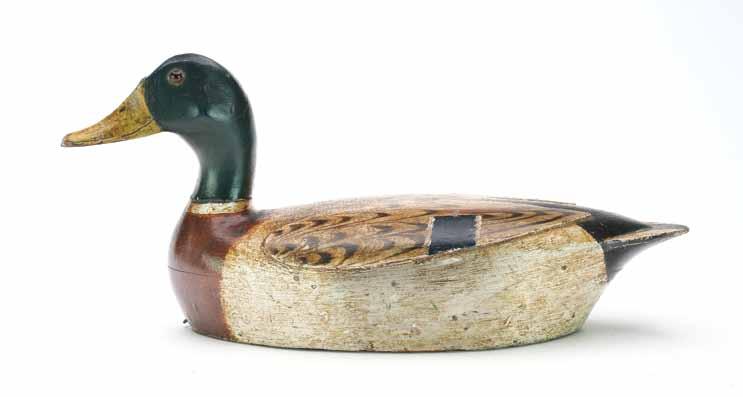

Mallard drake. Hollow carved, flat bottom style with relief wing carving and comb feather paint detail. Harold Haertel collection ink stamp on underside. Measures 17” long. Original paint with minor to moderate wear; an early coat of varnish has darkened with age; small dents and shot marks; tight crack through upper part of neck with some filler and touchup on back of head.
Provenance: Consigned for conservation to support Ducks Unlimited. (3,000 - 4,000)
Bert Graves
Illinois. Hollow carved mallard with slightly upswept tail. Retains the original Graves weight. “CES” stamped on weight and under breast. “VBR”, “FAD”, and “MGD” written on underside. Measures 17” long. Original paint under a thick coat of varnish that has darkened with age; white bars at wing patches and the green on head have an early second coat; minor roughness on edge of tail and bill.
Provenance: Consigned for conservation to support Ducks Unlimited. (1,200 - 1,800)


221 Bert Graves (1880-1956), Peoria, Illinois. Pair of canvasbacks. Hollow carved with comb feather paint detail. Both retain the original Graves weight. Measure 17” long. Original paint with moderate gunning wear; small dents and shot marks; slight separation to body seam on drake; cracks in each of drake’s eyes; tiny chip in underside of drake’s bill with touchup; hen with minor roughness on edge of tail; area of touchup on one side of breast; much of the hen’s bill with old touchup; hen’s eyes are early replacements.
Provenance: Consigned for conservation to support Ducks Unlimited. (2,000 - 3,000)
222 Robert Elliston (1849-1915), Bureau, Illinois. Hollow carved bluebill with comb feather paint detail. Measures 14” long. Original paint with moderate flaking and wear; heavily hit by shot in one side; roughness on edge of bill; heat exposure has caused the paint to bubble on much of the lower half of bird.
Provenance: Consigned for conservation to support Ducks Unlimited. (2,500 - 3,500)

Kinstler was born on his family’s dairy farm near Baltimore. His father, Henry, was actively involved in the production of butter under the name of H.W. Kinstler and Sons. In 1915, Calvin married Leola Howe, and in 1917, they had their son, Roy W. Kinstler had remained with the family business through this period but, by the time of the WWI draft, he was employed as an Inspector of Government Contracts, working for the Bartlett and Haywood Co in Baltimore. He continued to change jobs for the next few years and, by 1930, he was earning a living as an insurance collector.
The 1930 date was a pivotal one in Calvin’s life. Since childhood he had been infatuated with horses, especially the large draft horses on his father’s farm. The youngster was constantly sketching his equine subjects, then modeling them in putty or clay. As he progressed, wood became his favored medium and he continued to study any lithographs, paintings or photos that he could get his hands on. He quickly expanded his choice of subjects and shifted from draft horses to any member of the equidae family. His models became extremely accurate in every anatomical detail, but he felt that they still lacked what he sought in the finished product, so he took up oil painting and began to produce a number of canvases of his subjects. Eventually the two mediums were merged, and his horses took on an astounding realistic, near life quality. As his work matured so did his fame and recognition.
In the early 1930’s, he was invited by the director of the Baltimore Museum of Art to show some of his pieces at
“Cavlin Roy Kinstler achieved a level of exacting richness and beauty that may never again be realized. His stunningly delightful and realistic models are heirlooms serving as the hallmark of quality to be emulated and enjoyed”
- Jim Richendollar – The Draft Horse Journal.
the museum, and the exhibition drew rave reviews. In 1933, several of his models went on display at a book fair in New York, where they were discovered by an agent of Abercrombie and Fitch. Arrangements were made for a three-month consignment, but all of the pieces were sold within the first week. This was the beginning of a relationship with A&F that would last until the time of Kinstler’s death. He entered some of his work in a show sponsored by the American Artist Association in conjunction with the Kentucky State Fair, where he was awarded a First and the coveted Award of Merit. Similar results were realized at the 1939 Golden Gate Exposition. By this point, he began to realize that he could sustain his family financially with his art and, by 1940, he described himself in the census record as an “Artist – Own studio”.
Orders soon exceeded his ability to produce the carvings and, beginning in 1946, his son, Roy, joined in the execution of the works. Over the years, the studio filled orders from a number of important private collectors such as August Busch of Budweiser fame and Samuel Riddle, owner of the famous Man O War. Working with Philippine and Honduras mahogany, it is estimated that Kinstler would spend an average of six days on any one particular model and that his total production was about 2500 pieces.
His models are in the permanent collection of the International Museum of the Horse at the Kentucky Horse Park in Lexington, Kentucky, as well as in numerous elite private collections.
223 Calvin Kinstler (1890-1954). Carved model of a hunter horse. Relief carved mane and applied wooden ears and tail. Painted metal bridle. Signed by the maker on one side of base. Measures 12” long, 10.5” tall. Excellent original paint; hairline separation at filler where front legs join body; professional restoration to a crack where tail meets body; and a repair to a small chip in one ear. (400 - 600)

224 Calvin Kinstler (1890-1954). Carved model of a trotting Belgian Stallion. Carved wooden tail and ears. Applied running and button braids on top of mane. Painted metal bridle. Signed by the maker on one side of base. Also signed and dated Feb. ‘36 on the underside. Measures 10” long, stands 9.75” tall. Original paint with a few minor rubs; some paint restoration on legs. (600 - 900)

225 Calvin Kinstler (1890-1954). Carved model of a prancing hunter horse. Signed by the maker on one side of base. Measures 9.5” long, 10.5” tall. A few tiny paint rubs, otherwise very good and original. (600 - 900)





226 Calvin Kinstler (1890-1954). Carved model of a draft horse. Applied twine running and button braid along mane. Painted metal bridle. Signed by the maker on the underside. Measures 9.5” long, stands 8.5” tall. Original paint with minor flaking on back legs, otherwise very good.
(600 - 900)
227 Calvin Kinstler (1890-1954). Carved model of a hunter horse. With applied wooden arched tail and painted metal bridle. Signed by the maker on one side of base. Sticker from Abercrombie & Fitch, New York on underside. Measures 9.5” long, stands 9.25” tall. Original paint with minor rubs on back legs; small spots of sap bleed on body; hairline separation and minor flaking at filler where front legs attach to body; minor chipping on top of ears.
(600 - 900)
228 Calvin Kinstler (1890-1954). Carved model of a bull. Signed by the maker on one side of base. Measures 12” long, stands 9” tall. Very minor flaking where one front leg attaches to body, otherwise very good and original.
(600 - 900)
229 Unknown maker, 20th century. Carved model of a mare and foal. Excellent detail. Appears to be carved from one piece of wood. Measures 10.5” long, stands 7” tall. Natural wood finish with excellent patina; cracks and separation at three of the hooves likely from the wood drying and twisting.
(400 - 600)
230 Clark Voorhees (1911-1980), Weston, Vermont. Carved dolphin. Maker’s stamp on back. Measures 18.25” long. Thin coat of varnish that has darkened with age; otherwise excellent and original. (1,200 - 1,800)


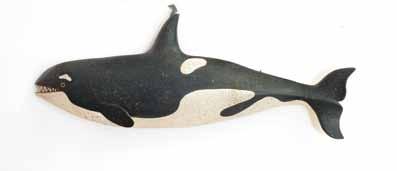
Measure
Provenance: Graf collection. (1,000 - 1,500)
231 Clark Voorhees (19111980), Weston, Vermont. Carved sperm whale plaque with open mouth and inserted teeth. Maker’s stamp on back. Measures 17.5” long. Excellent and original. (1,200 - 1,800)
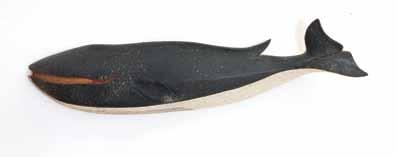

Complimentary Happy Hour Cruise aboard the Patriot Cruise Boat Friday, July 25, 5:30pm - 7:00pm

We are happy to offer our customers a complimentary “happy hour” cruise after day one of our auction!
The cruise will leave from St Michaels Harbor : 213 North Talbot Street. Enter the Chesapeake Bay Maritime Museum. Park in the Museum parking lot and the PATRIOT is next to the Crab Claw Restaurant.
Departure is 5:30pm on Friday, July 25, and will return at 7:00pm.
There will be an open bar.
Please contact our office no later than July 18 to reserve your ticket.
410-745-0485 | auction@guyetteanddeeter.com

Session Two • Saturday, July 26, 2025 • 10:00am
b. 1950 | Craddockville, Virginia

241 Mark McNair (b.1950), Craddockville, Virginia. Hollow carved sleeping black duck with raised wingtip carving and scratch feather paint detail on head. “MS McNair” carved in underside. “Island Neck, Sept 1989” painted on underside. Measures 14.75” long. Excellent and original.
Provenance: Mike and Ginger Raffia collection. (3,000 - 4,000)


242 Mark McNair (b.1950), Craddockville, Virginia. Pair of killdeer with relief wing carving and raised wingtips. One with head turned 90 degrees. Each with tack eyes, scratch feather paint detail, and carrying holes drilled in tail. “McNair” carved on the underside. Measure 10.25” and 10.75” long. Excellent and original.
Provenance: Mike and Ginger Raffia collection. (2,500 - 3,500)

is slightly turned. “McNair” carved in underside. Measures 24” long. Made to appear older; excellent and original.
Provenance: Mike and Ginger Raffia collection. (2,000 - 3,000)



Mark
Large curlew with relief wing carving and carved eyes. “McNair” carved in underside. Measures 16.75” long. Excellent and original.
Provenance: Mike and Ginger Raffia collection. (1,500 - 2,500)
McNair (b.1950), Craddockville, Virginia. Dove with metal legs mounted to base. Deep relief wing carving and raised wingtips. “McNair” carved on the underside. Measures 14.75” long, stands 13.25” tall. Excellent and original.
Provenance: Mike and Ginger Raffia collection. (1,200 - 1,800)
246 Mark McNair (b.1950), Craddockville, Virginia. Tucked head godwit with relief wing and slight eye groove carving. “McNair” carved in underside. Measures 13.5” long. Excellent and original.
Provenance: Mike and Ginger Raffia collection.
(1,200 - 1,800)
247 Martha McNair, Craddockville, Virginia. Tucked head dowitcher with tack eyes and relief wing carving. “MDM” carved in underside. Jack Conover collection ink stamp on underside. Measures 9.25” long. Excellent and original.
Provenance: Mike and Ginger Raffia collection.
(800 - 1,200)
Mark McNair (b.1950), Craddockville, Virginia. Tucked head dowitcher with relief wing carving. “M” carved in the underside. Measures 7.75” long. Excellent and original.
Provenance: Mike and Ginger Raffia collection. (1,000 - 1,400)






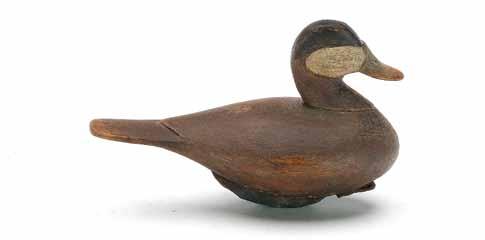
248
249
Mark McNair (b.1950), Craddockville, Virginia. Miniature white heron with removable head and relief wing carving. “McNair” carved in one side of tenon that slides in to mortised neck seat. Measures 7” long. Excellent and original.
Provenance: Mike and Ginger Raffia collection. (1,000 - 1,400)
Mark McNair (b.1950), Craddockville, Virginia. Miniature curlew in alert pose with relief wing carving. “McNair” carved in underside. Stand included. Measures 4” long. Excellent and original.
Provenance: Mike and Ginger Raffia collection. (1,000 - 1,400)
250 Mark McNair (b.1950), Craddockville, Virginia. Miniature swimming brant in the style of Nathan Cobb, Jr. Raised wingtip carving. “M” carved in the underside. Measures 5” long. Excellent and original.
Provenance: Mike and Ginger Raffia collection. (800 - 1,200)
251 Mark McNair (b.1950), Craddockville, Virginia. Miniature ruddy duck in the style of Lee Dudley, with reared back head and slight relief wingtip carving. “McNair” carved in underside. Measures 3.75” long. Excellent and original.
Provenance: Mike and Ginger Raffia collection. (800 - 1,200)


Virginia. Pair of terns with extended split tail carving and stylish form. “McNair” carved in the underside. Measure 16.25” long. Area of paint shrinkage on each breast, otherwise excellent and original.
Provenance: Mike and Ginger Raffia collection. (1,200 - 1,800)
Virginia. Thinly hollowed golden plover with relief wing carving and raised wingtips. “McNair” carved in underside. Measures 12” long. Excellent and original. (1,200 - 1,800)


Feeding yellowlegs with slightly turned head and raised wingtips. “McNair” carved in underside.
Measures 12.5” long. Moderate paint shrinkage on back, otherwise excellent and original.
Provenance: Mike and Ginger Raffia collection. (800 - 1,200)
Hollow carved herring gull with relief wing carving and wooden keel. “McNair” carved in one side of keel. Measures 18” long. Minor paint rub on wingtip, otherwise excellent. (2,000 - 3,000)


254 Mark McNair (b.1950), Craddockville, Virginia. Interesting coot with rocking head mechanism. Deep relief heart pattern wings. “McNair” carved on the underside. Measures 12.25” long. Drying crack along back and tail, otherwise excellent. (2,000 - 3,000)
255 Mark McNair (b.1950), Craddockville, Virginia. Golden plover silhouette with relief wing carving and carved eyes. Excellent paint detail. Measures 11” long. Excellent and original. (800 - 1,200)

257 Frank Finney (b.1947), Cape Charles, Virginia. Large preening curlew with one raised wing. Relief wing and tail feather carving. Maker’s initials carved on underside. Measures 12” long, stands 22.75” tall. Excellent and original. (4,000 - 6,000)

256 Frank Finney (b.1947), Cape Charles, Virginia. Full-size standing laughing gull. Deep relief wing carving with extended, crossed wingtips. Slightly turned head with open beak and extended tongue. Deep relief feather carving. Maker’s initials carved on top of base. Measures 18” long, stands 21.5” tall on base. Excellent and original. (4,000 - 6,000)

258 Frank Finney (b.1947), Cape Charles, Virginia. Full-size kingfisher with fish in bill. Extended crest feathers and dropped wing carving. Maker’s initials carved on natural wood perch. Measures 12” long, stands 13” tall. Excellent and original. (3,000 - 4,000)
259 Frank Finney (b.1947), Cape Charles, Virginia. Tropical kingfisher on an old wooden post with iron spike. Deep relief wing carving and slightly turned head. Maker’s initials carved on top of base. Measures 9” long, and stands 9” tall. Excellent and original. (2,000 - 3,000)

260 Frank Finney (b.1947), Cape Charles, Virginia. Walking greater yellowlegs with raised wingtips and relief feather carving. Signed and with maker’s initials carved on the underside of base. Measures 13” long, 9” tall. Excellent and original. (2,500 - 3,500)

261 Frank Finney (b.1947), Cape Charles, Virginia. Preening hooded merganser with extended crest and relief wing carving. Wingtips are raised and crossed. Scratch feather paint detail on lower sides. Maker’s signature was scratched in wet paint on underside. Measures 14” long. Very good and original. (2,000 - 3,000)
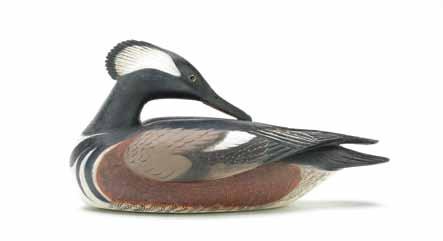
262 Frank Finney (b.1947), Cape Charles, Virginia.
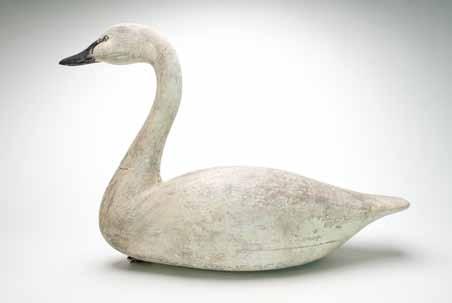
Bach was born in Switzerland and is reported to have been trained as an architect and draftsman although he listed his education as ending after three years in high school. This is a relatively insignificant detail, since art and creativity, as was to become apparent, can often be innate. After serving 6 years in the Swiss Infantry, he left his homeland and traveled to Denmark where he boarded the Hellig Olav and set sail for the United States. He was fluent in several languages, but not English and, upon his arrival to the States, he settled briefly in a German speaking community in Pennsylvania. Here, he polished his English and bought his first book in this country – one on the American Indian. This formed a fascination with the Native Americans that would remain with him for his entire life.
By 1917/18, he had migrated to Michigan where he is listed as a “draftsman”. Here he began to live in two separate and distinct worlds. He yearned for, and dreamt of, a life in the rugged north woods. However, even though he wielded a pen and not a wrench, for the remainder of his working life, he would be embroiled in the smoke and grit of Detroit’s renowned “motor city”. He found employment, first as a draftsman, and ultimately, head designer for a number of that city’s largest automobile manufacturers in their heyday including Studebaker, Rickenbacker, Chrysler and Dodge. In 1929, he married Margaret K Watson and lived in a very blue-collar neighborhood with her parents. They had a son, also named Ferdinand, but the union was dissolved in 1936 with Margaret being granted an (uncontested) divorce on the grounds of “nonsupport and extreme cruelty”. Ferdinand had to briefly pay alimony until Margaret remarried later that same year. Strangely, they must have remained somewhat friendly since she is listed as the person to notify in his 1942 WWII draft registration. Until this time, Bach had been living as a “lodger” or “boarder”. By the late 1940’s, however, he had purchased his own suburban home on Kramer St in St Claire Shores, a suburb of Detroit, and only a stone’s throw from Lake St Clair. Here he transformed his surroundings into a miniature interpretation of a north woods cabin, complete with its own tiny birch and evergreen forest. He had always enjoyed the outdoors, including hunting and fishing. Early in his life he traveled to the West to study the Native Americans and later, would annually make an extended pilgrimage to Golden Lake, Ontario to live among the Pikwakanagan members of the First People. He mastered a number of rural skills such as snowshoe making and basketry, but he particularly excelled at the construction of Birch Bark Canoes. He died unexpectedly when his body was found floating in the waters near his home.
His decoy carving was limited but, as one would expect from someone with his design background, always of the highest standard, both in terms of form and finish. As early as the 1920’s, he carved a small rig of detailed black ducks for a local policeman whose territory included the Detroit riverfront where the men may have met. He would later carve at least one other rig for an automotive associate. Other than these two known rigs, Bach carved only for his own use. His first rig was finished by the 1930’s but these were all lost in a tragic boat house fire. Undeterred, he set out to carve a second rig for himself and these have since been crowned his “classics”. These are muscular with and without detailed wing tips and designed to be visible to high flying flocks. He achieved a great deal of realism in this rig by utilizing 44 different head patterns in their construction. His work is usually identified with his name either signed or carved with a flourish on the bottoms, often with a conjoined “c” and “h” in “Bach”. History had taught him a painful lesson and he lavished great care on his new creations.
Bach exhibited his talents in a number of ways. Not only did he carve majestic decoys, but he also produced some miniatures, classic birch bark canoes (both in museum displays and today, recognized as some of the finest of their kind), duck boats, sailboats, skiffs and at least one miniature boat model complete with decoys. In addition, at least one piece of attractive, impressionistic, flat art is signed by him.
His decoys are now included in a select few private collections and have been described as “powerfully stylized” and “possessing both freshness and spontaneity”.
Bach did live in two worlds, the industrial complex of downtown Detroit and the wild, open freedom of the northern woods. We must assume that he far preferred the latter.

263 Ferdinand Bach (1888-1967), Detroit, Michigan. Canvasback with relief wingtip carving and fluted tail. “F Bach” carved in the underside for the rig of the maker. Measures 16.5” long. Original paint with very minor wear; three filled shot holes on one side of breast, otherwise excellent structurally.
Provenance: Jim and Patti Aikin collection. (10,000 - 14,000)




Quillin was Michigan’s earliest and finest commercial decoy craftsman. According to Jim Marsh, a Quillin authority, his most productive years were between 1880 and 1900. The majority of his decoys and boats were sold to members of the Pointe Mouillee Shooting Club where he worked as a guide. When pioneer collector Joel Barber set sight on Quillin’s boat body style decoys, he was so impressed that he created an architectural drawing of the cross section in 1951. He went on to write in his book about Quillin, “He took great pride in his work. He was very neat and everything had to be in perfect order. Not only would he make decoys, but he also painted them, and every bit of color was applied with great exactness and care. His appearance and temperament were this of an artist.” This widgeon drake is one of only a small number of Widgeon and it is the only known exam in original paint.




264 Nate Quillin (1839-1908), Rockwood, Michigan. Exceedingly rare widgeon. The only example in original paint. Thinly hollowed with .25” bottom board that is branded “J.C.M.” on underside for J.C. Morse, Pointe Mouillee club member 1894-1900. Inlayed neck seat and very slight shoulder carving. Measures 13.75” long. Original paint with moderate flaking and wear; significant stable crazing on much of the body; lightly hit by shot; crack through neck. (12,000 - 18,000)
265 Mallard, Tom Schroeder, Detroit, Michigan, 2nd quarter 20th century. Hollow carved with .75” bottom board that is hollowed on the underside and a rubber coated piece of metal added to cover the hole. Slightly turned head and relief wing carving. Measures 14.25” long. Original paint with minor wear under a thick coat of varnish that has darkened slightly; separate piece added to back of the neck in the making; old filler added to a small chip in tail; a few small dents. (5,000 - 8,000)

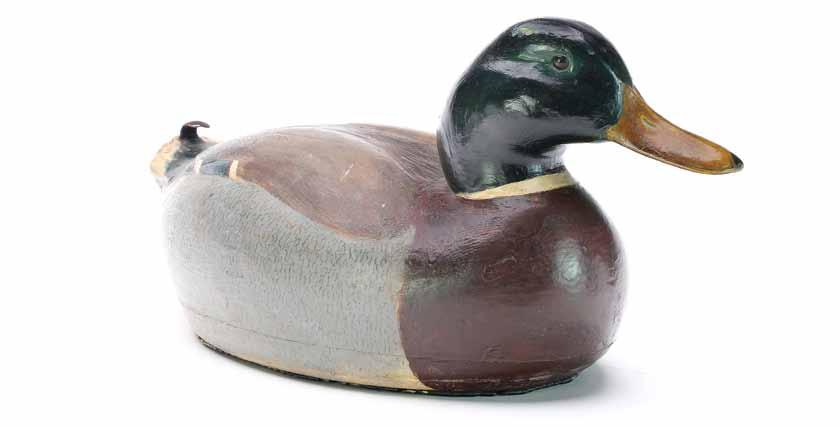
266 Tom Schroeder (1886-1976), Detroit, Michigan. Rare flying tern with outstretched wings and applied wire feet. Measures 12.5” long, with a 19” wingspan. Original paint that has darkened slightly under the original coat of varnish; tiny chips on tip of one wing; each tail feather has been reset.
Provenance: Len Carnaghi collection. (400 - 600)

267 Tom Schroeder (1886-1976), Detroit, Michigan. Crappie fish plaque with relief gill carving and incised scale stamping. Applied wooden fins. Maker’s name and 190 branded on back of plaque. Fish measures 14” long, plaque is 8.5” x 18”. Tightly reset chip in bottom half of tail, otherwise very good and original.
Provenance: Len Carnaghi collection. (600 - 900)
268 Tom Schroeder (1886-1976), Detroit, Michigan. Four canvasback heads with different poses. Including two sleepers. Measure 6” long. Sleeper with no eyes has a small chip on top of head and tip of bill, otherwise all are very good and original.
Provenance: Len Carnaghi collection. (500 - 800)


269 Tom Schroeder (1886-1976), Detroit, Michigan. Group of nine heads. Including wood duck, widgeon, and gallinule. Measures from 3.5” - 6.25”. A few minor paint rubs, otherwise excellent.
Provenance: Len Carnaghi collection. (800 - 1,200)




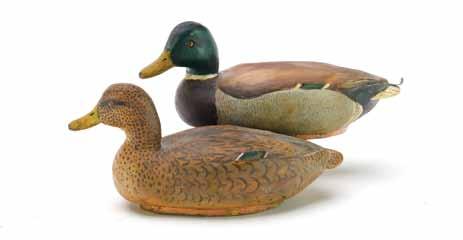
270 Tom Schroeder (1886-1976), Detroit, Michigan. 1/3 size widgeon with raised wing feathers and relief tail feather carving. Maker’s name and 1960 branded in underside. Measures 9” long. Excellent and original.
Provenance: Len Carnaghi collection. (400 - 600)
271 Tom Schroeder (1886-1976), Detroit, Michigan. Pair of miniature pintails. Both with relief wingtip carving. Measure 6.25” and 7.25” long. Drake with areas of touchup on the head and a thin wash to white areas likely done by the maker; both very good structurally.
Provenance: Len Carnaghi collection. (600 - 900)
272 Tom Schroeder (1886-1976), Detroit, Michigan. Pair of miniature bufflehead. Relief wingtip carving. Measure 5.5” long. White areas were painted after the varnish layer by the maker; flaking around lower edge of each; very good structurally.
Provenance: Len Carnaghi collection. (600 - 900)
273 Tom Schroeder (1886-1976), Detroit, Michigan. Pair of miniature mallards. Slightly turned heads. Metal tail sprig added on drake. Signed and dated 1969 on underside. Measure 5.5” long. Drake with two small spots of touchup on head; tiny spots of white spray paint on hen’s back.
Provenance: Len Carnaghi collection. (400 - 600)



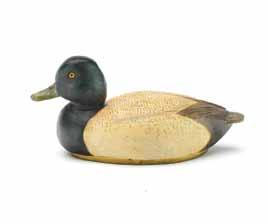
274 Tom Schroeder (1886-1976), Detroit, Michigan. 1/4 size canvasback with relief wingtip carving. Measures 7” long. Original paint under the original coat of varnish; excellent and original.
Provenance: Len Carnaghi collection. (400 - 600)
275 Tom Schroeder (1886-1976), Detroit, Michigan. 1/4
size greenwing teal with tucked head and extended crest. Relief wing and tail feather carving. Measures 7” long. Original paint under the original coat of varnish; excellent and original.
Provenance: Len Carnaghi collection. (400 - 600)
276 Tom Schroeder (1886-1976), Detroit, Michigan. 1/4
size redhead with tucked and slightly turned head. Relief wingtip carving. Measures 6.5” long. Original paint under the original coat of varnish that is somewhat uneven; area on back appears to have been shaved down and touched up.
Provenance: Len Carnaghi collection. (300 - 500)


277 Tom Schroeder (1886-1976), Detroit, Michigan. 1/4
size bluebill with relief wingtip carving. Maker’s name and 1960 branded in the underside. Measures 6.5” long. Original paint under the original coat of varnish; very good and original.
Provenance: Len Carnaghi collection. (400 - 600)
278 Tom Schroeder (1886-1976), Detroit, Michigan. 1/4
size mallard hen with slightly turned head and raised wingtips. Measures 7” long. Excellent and original.
Provenance: Len Carnaghi collection. (300 - 500)
279 Tom Schroeder (1886-1976), Detroit, Michigan. 1/4
size mallard with tucked head and relief wing feather carving. Small inserted metal tail sprig. Measures 7” long. Original paint under the original coat of varnish; a few small spots of touchup, likely by the maker.
Provenance: Len Carnaghi collection. (300 - 500)

280 Benjamin Schmidt (1884-1968), Detroit, Michigan. Hollow carved Canada goose with slight relief wingtip carving and feather stamping. Measures 23.5” long. Original paint with minor wear; thin coat of vanrish has darkened slightly; tight drying crack along the back; a few tiny dents and shot marks.
Provenance: Jim and Patti Aikin collection. (2,000 - 3,000)
281 Benjamin Schmidt (1884-1968), Detroit, Michigan. Pair of widgeon with slightly turned heads and extensive feather stamping. Hen with .25” bottom board. Both are signed and dated 1955. Also stamped “SGH” for the collection of Somers Headly. Measure 13.5” long. Original paint with almost no wear; hairline crack in drake’s neck; small chip reglued in hen’s tail; one edge of drake’s tail has been shaved down and touched up.
Provenance: Somers Headley collection. Len Carnaghi collection. (3,000 - 5,000)


282 Benjamin Schmidt (1884-1968), Detroit, Michigan. Preening black duck with incised feather carving. Measures 14.5” long. Original paint with very minor wear; small dent in top of head; minor flaking at neck seat; hairline cracks in each eye.
Provenance: Len Carnaghi collection. (1,200 - 1,800)
283 Benjamin Schmidt (1884-1968), Detroit, Michigan. Hollow carved black duck with .25” bottom board and uplooking head pose. Incised feather carving. Measures 18” long. Original paint with minor wear; hairline crack in neck seat; old gray paint on underside has come up lower sides slightly.
Provenance: Len Carnaghi collection. (1,200 - 1,800)


284 Benjamin Schmidt (1884-1968), Detroit, Michigan. Mallard hen and drake with incised feather carving. Drake with slightly turned head. Measure 16.75” long. Original paint with minor to moderate wear; roughness on edge of tails and drake’s bill; hairline drying cracks in hen’s head and body.
Provenance: Len Carnaghi collection. (1,200 - 1,800)
285 Benjamin Schmidt (1884-1968), Detroit, Michigan. Pair of bluebills with slight relief wingtip carving. Drake’s wooden keel was removed. Measures 14.5” long. Original paint with very minor wear; minor roughness on edge of hen’s bill and tail.
Provenance: Len Carnaghi collection. (800 - 1,200)


286 Benjamin Schmidt (1884-1968), Detroit, Michigan. Mallard with relief wingtip carving. Measures 17.75” long. Original paint with minor to moderate gunning wear; tight crack along one lower side; lightly hit by shot; hairline crack along back; small tail chip repair.
Provenance: Jim and Patti Aikin collection. (500 - 800)
287 Benjamin Schmidt (1884-1968), Detroit, Michigan. Pintail hen with raised wingtips and feather stamping. Measures 15” long. Original paint with very minor wear; blunting at tip of tail was darkened; hairline crack in one side of neck seat.
Provenance: Len Carnaghi collection. (800 - 1,200)


288 Ben Schmidt (1884-1968), Detroit, Michigan. Pair of canvasbacks. Drake has “RHB” branded in underside. Measure 16” long. Original paint with minimal to little wear.
Provenance: Len Carnaghi collection. (800 - 1,200)
289 Benjamin Schmidt (1884-1968), Detroit, Michigan. Rigmate pair of canvasbacks with relief wingtip carving. Measure 15.5” long. Original paint with minor gunning wear; mostly on hen’s head and bill; drying crack in hen’s breast and minor roughness on tip of hen’s tail.
Provenance: Jim and Patti Aikin collection. (1,200 - 1,800)


290 Benjamin Schmidt (1884-1968), Detroit, Michigan. Widgeon with slightly turned head and relief wing feather carving. Measures 17” long. Original paint with moderate flaking and wear; tight drying cracks in body; hairline crack in one eye; shallow chip on the underside.
Provenance: Jim and Patti Aikin collection. (1,200 - 1,800)
291 Benjamin Schmidt (1884-1968), Detroit, Michigan. Black duck with slightly turned head, slight relief wingtip carving, and extensive feather stamping. “W” carved in the underside. Measures 17.75” long. Original paint with very minor wear; tight hairline cracks in body.
Provenance: Jim and Patti Aikin collection. (600 - 900)


292 Benjamin Schmidt (1884-1968), Detroit, Michigan. Black duck with slightly turned and tucked head. Incised feather carving. Measures 17” long. Very good and original.
Provenance: Jim and Patti Aikin collection. (700 - 1,000)
293 Benjamin Schmidt (1884-1968), Detroit, Michigan. Mallard hen with slightly turned head and incised feather carving. Measures 16.75” long. Original paint with minor wear; mostly on back; minor roughness on edge of tail; hairline drying cracks in neck.
Provenance: Len Carnaghi collection. (600 - 900)


294 Benjamin Schmidt (1884-1968), Detroit, Michigan. Black duck with slight relief wingtip carving and extensive feather stamping. Measures 16.5” long. Original paint with very minor wear; very good structurally.
Provenance: Jim and Patti Aikin collection. (600 - 900)
295 John Schweikart (1870-1954), Strawberry Island, Michigan. Canvasback hen with applied metal wingtips and folding copper keel. Measures 17.5” long. Paint is a mix of original and very early repaint by Schweikart; reglued crack through neck; with very small chip missing.
Provenance: Len Carnaghi collection. (1,200 - 1,800)


297 John Schweikart (1870-1954), Strawberry Island, Michigan. Rare hollow carved coot. Measures 15.75” long. Like all the Schweikart coot, paint is a second coat with minor wear; some paint flaking at neck seat; slight separation at a knot on one side near breast.
Provenance: Len Carnaghi collection. (800 - 1,200)
296 Ralph Reghi (1910-1995), Detroit, Michigan. Rigmate pair of canvasbacks with weighted wooden keels. Hen in high head pose. Both branded “Lowrey”. Measure 16” and 17” long. Original paint with moderate gunning wear; white areas on drake appear to have had a second coat taken down; black on the bills is a second coat.
Provenance: Len Carnaghi collection. (1,500 - 2,500)




298 Mason Decoy Factory (1889-1924), Detroit, Michigan.
Hollow carved premier grade pintail with snakey head style. “Brooks Bros” painted on underside. Measures 19.25” long.
Original paint with minor wear; surface has darkened with age; moderately hit by shot with those around tail area having been filled, but not painted; 2.5” of the tail tip is professionally restored.
Provenance: Len Carnaghi collection. (5,000 - 8,000)
299 Mason Decoy Factory (1889-1924), Detroit, Michigan. Early premier grade pintail hen. Hollow carved, slope breast style. “J.F.?” brand on underside has been sanded down. Measures 17” long. Original paint with minor gunning wear; some shot marks in one side were filled and touched up; professional neck filler restoration; two small spots on one side of head and larger one near one wing patch and top of tail with touchup.
Provenance: Len Carnaghi collection.
(3,000 - 4,000)


300 Mason Decoy Factory (1889-1924), Detroit, Michigan. Rigmate pair of goldeneye. Challenge grade. Measure 14” long. Original paint with minor wear on hen, moderate wear on drake; tight drying crack along one side and underside of drake; both with professional restoration around neck seats.; hairline crack in one of hen’s eyes.
Provenance: Len Carnaghi collection.

(4,000 - 6,000)

301 Mason Decoy Factory (1889-1924), Detroit, Michigan. Rare special order goldeneye hen. Challenge grade in the style of George Bacon from Vermont. “BB-10” written on underside. From the collection of Dr. George Ross Starr. Measures 13.75” long. Original paint with minor to moderate flaking and wear; drying crack along the underside; hairline crack in each eye; “Starr” written in invisible ink on back and underside.
Literature: “Decoying – St. Clair to the St. Lawrence” by Bernard W Crandell, page 182, exact hen pictured. “Mason Decoys – A Complete Pictorial Guide” by Russ J. Goldberger and Alan G. Haid, page 114, exact decoy pictured. “Decoys of the Atlantic Flyway” by Dr. George Ross Starr Jr., page 225, exact decoy pictured.
(6,000 - 9,000)



302 Mason Decoy Factory (1889-1924), Detroit, Michigan. Canada goose. Premier grade with relief bill carving and feather loop paint detail on back. Measures 24.5” long. Original paint with moderate flaking and wear; crack in one side of neck; in factory filled split on one side has opened slightly; large area on that same side with filler and paint restoration.
Provenance: Len Carnaghi collection. (6,000 - 9,000)







Mason Decoy Factory (1889-1924), Detroit, Michigan. Premier grade bluewing teal. Hollow carved with relief bill carving. “Taylor” branded on the underside. Measures 12.75” long. Original paint with very minor wear; slight separation at body seam on one side; some flaking to filler above a small knot on one lower side; minor roughness on tip of bill and one edge of tail.
Provenance: Len Carnaghi collection.
(6,000 - 9,000)
Mason Decoy Factory (1889-1924), Detroit, Michigan. Premier grade bluewing teal hen. Hollow carved. Decoy was never rigged or weighted. Measures 12.25” long. Original paint with very minor wear, under an early coat of varnish that has darkened with age; dent on top of tail; minor roughness on edge of bill; hairline crack in one side of neck seat.
Provenance: Len Carnaghi collection.
(4,000 - 6,000)


305 Mason Decoy Factory (1889-1924), Detroit, Michigan. Rigmate pair of mallards. Hollow carved premier grade. Measure 17.75” long. Original paint with very minor wear; tiny tail chip repair on hen; small spot on top of hen’s head and back with touchup; drake with a few spots of touchup to gray on one side; and a thin wash of gray to areas on the other side.
Provenance: Len Carnaghi collection. (3,000 - 5,000)
306 Mason Decoy Factory (1889-1924), Detroit, Michigan. Pair of hollow carved mallards. Challenge grade with nice paint detail. Measure 16.5” long. Original paint with minor wear; both are hit by shot; hairline drying crack in hen’s back; drake with a professional tail chip repair and area of touchup on one side of body seam; each with professional neck filler restoration.
Provenance: Len Carnaghi collection. (2,000 - 3,000)




307 Mason Decoy Factory (1889-1924), Detroit, Michigan. Rigmate pair of bluebills. Hollow carved premier grade with wide bill carving. Measure 13.5” long. Original paint with minor to moderate wear under an early coat of varnish that has darkened with age; small dents and shot marks; roughness around drake’s bill; tight drying cracks and a tiny chip on drake’s tail; each with restoration around neck seat; hairline crack in one side of drake’s neck.
(3,000 - 5,000)
308 Mason Decoy Factory (1889-1924), Detroit, Michigan. Pair of pintails. Standard grade glass eye models. Measure 16.75” and 17.5” long. Original paint with minor wear on drake; retains much of the original neck filler with some glue visible at neck seat; tiny chip in bill tip; a few spots of discoloration on back; hen with some flaking to the original neck filler; tight drying cracks in underside and along one side where the wood grain has separated.
Provenance: Len Carnaghi collection. (2,000 - 3,000)
Early collector, George Wick, holding this exact decoy at a show in the mid 1970’s.



309 Mason Decoy Factory (1889-1924), Detroit, Michigan. Small mallard drake. Standard grade glass eye model. Made from a teal head and body. Scallop paint detail on breast and tail, not usually seen on standard grade decoys. Measures 12” long. Original paint with minor wear under an early coat of varnish; early tail chip repair with some minor roughness in that area; hairline crack along one side of head and underside; professional neck filler restoration.
Literature: “Mason Decoys – A Complete Pictorial Guide” by Russ J. Goldberger and Alan G. Haid, page 139, exact decoy pictured. (2,000 - 3,000)
310 Mason Decoy Factory (1889-1924), Detroit, Michigan. Extremely rare working wood duck. Standard grade, tack eye model. Measures 13.5” long. Original paint with minor to moderate flaking and wear; half inch of the neck filler has been restored; small amount of touchup around eyes; bill is a professional replacement. (5,000 - 8,000)


311 Mason Decoy Factory (1889-1924), Detroit, Michigan. Rigmate pair of canvasbacks. Premier grade, Seneca Lake models. Measure 16.75” long. Original paint with minor to moderate wear; small dents and shot marks; tight drying crack in underside of each.
Provenance: Chris Pitman collection. (2,500 - 3,500)
311A Mason Decoy Factory (1889-1924), Detroit, Michigan. Pair of bluebills. Challenge grade with snakey head style and wide bill carving. Original paint with moderate flaking and wear; flaking around drake’s neck seat; hen with significant restoration around neck seat and to defects in wood on underside.
Provenance: Len Carnaghi collection. (1,500 - 2,500)


311B Mason Decoy Factory (1889-1924), Detroit, Michigan. Very rare premier grade widgeon. Hollow carved body with early head style. “WRP” branded in underside. Measures 14.75” long. Original paint with significant flaking and wear; small dents and shot marks; roughness on edge of bill and top of head; 1” tail chip repair.
(6,000 - 9,000)
311C Mason Decoy Factory (1889-1924), Detroit, Michigan. Early redhead. Hollow caved premier grade with early up-looking head style. Measures 14.75” long. Original paint with moderate wear; under an early coat of varnish; minor roughness on edge of bill and tail; old glue visible at neck seat; loss to heart wood along center of underside.
Provenance: Len Carnaghi collection. (1,200 – 1,800)
312 Mason Decoy Factory (1889-1924), Detroit, Michigan. Hollow carved canvasback. Premier grade with relief bill carving. Measures 15” long. Original paint with minor to moderate wear; small dents and shot marks; tight crack in lower neck; touchup to flaking around neck seat.
Provenance: Len Carnaghi collection. (600 - 900)
313 Mason Decoy Factory (1889-1924), Detroit, Michigan. Hollow carved canvasback hen. Premier grade. Branded “Love” and “Hi” on underside. Also with VL&A, Chicago ink stamp. Measures 15” long. Original paint with minor to moderate wear; small spot of touchup on center of back; restoration around neck seat; lower part of bill was chipped down and reset with touchup in that area.
Provenance: Len Carnaghi collection. (800 - 1,200)
314 Unknown maker, early 20th century, Detroit, Michigan. Rigmate pair of canvasbacks by an employee of the Mason Decoy Factory. Bobtails with wooden keels. “Laurie” branded on the undersides. Measure 16” and 17” long. Original paint with moderate flaking and wear; small dents and shot marks; nail added to each side of drake’s neck seat; area on one side of drake’s breast with filler and touchup; both bills are repainted; hen’s head is loose.
Provenance: Len Carnaghi collection. (2,000 - 3,000)
315 Unknown maker, early 20th century, Detroit, Michigan. Bobtail canvasback with tucked head by an employee of the Mason Decoy Factory. Branded “Laurie” twice on the underside. Measures 15.5” long. Original paint with moderate gunning wear; hit by shot; a few nails added to secure head; professional bill chip repair.
Provenance: Len Carnaghi collection. (800 - 1,200)




Chauncy Wheeler’s life was centered on the St Lawrence River in upstate New York. He was born on Wellesley Island but soon moved to the hamlet of Alexandria Bay where he would remain until his death. As a youth, he worked at the local hotels that catered to affluent summer guests and then went on to serve as a boatman and captain for several of the seasonal residents on their private yachts and/or houseboats, ultimately becoming a licensed River Pilot. He came from a family of decoy carvers and made his first decoys (a pair of miniatures) when he was only eight. The river’s business and social life kept him busy from spring through early fall. As the tourist and summer visitors began to depart for the winter, he had more time to himself, and he could spend it with friends and neighbors, working together repairing boats and other tasks that benefited from multiple hands.
As winter began to settle in on the community and the river began to freeze solid, “Chance” would retreat to his shop on the waterfront. Here, he would begin to carve what he referred to as his “flocks” of decoys. He would arrive at the shop promptly at eight AM and, shortly thereafter, groups of men would also begin to assemble. Some would sled in loads of firewood over the ice, others would bring various forms of refreshments, liquid or otherwise, pipes and cigars would be lit, and the day’s activities would commence. Some would carve, others would simply watch, some would be assigned to tend the fire, and all would join


in on the conversation and congeniality. The shop was designated a male only zone, and all were expected to pitch in at the end of the day to be sure the floors were swept and all the tools and materials cleaned and returned to their proper place.
Wheeler was the unquestioned dean of the group, and his decoys were either copied directly or served as the basis for the design of others. He would lend his instruction as needed, and all were welcome to freely use his patterns and copy his painting methods. Over the years, men would come and go but Chauncy’s influence is clearly evident in the work of many of those that participated in the friendly gatherings. Among the men who can trace their roots to the little shop on Holland Street were Clovis LeFebvre, Frank Coombs, Len Massey, George Bruce, Bob Dingman, Gus Rogers, George Blevins, Roy Conklin and Fairman Davis to name a few.
With Wheeler at the helm, the decoys produced by these individuals clearly established the “Alexandria Bay” style of carving, one of the most desirable types identified with upstate New York decoys.



316 Chauncey Wheeler (1888-1945), Alexandria Bay, New York. Rare plover in winter plumage. Tack eyes and iron bill. Measures 11” long. Original paint with very minor wear; two small spots of red paint on one side; two small spots of touchup on one side of head; professional tail chip repair on each corner of tail; a second stickup hole on underside was filled and touched up. (3,000 - 5,000)
317 Gus Rogers (1892-1938), Alexandria Bay, New York. Rigmate pair of goldeneye with metal rig tags of Donald Baxter, Syracuse, New York. Measure 14.25” long. Original paint with minor gunning wear; lightly hit by shot; small chip in each tail.
Provenance: Chris Pitman collection. (3,000 - 5,000)

319 Chauncey Wheeler (1888-1945), Alexandria Bay, New York. Black duck with eye groove carving. Measures 17.75” long. Original paint with minor to moderate wear; small dents and shot marks; minor roughness on edge of tail; hairline crack in one side of neck seat; defect in wood on back near tail; cork at recessed screw hole on underside was replaced.
Provenance: Chris Pitman collection. (2,000 - 3,000)
318
Chauncey Wheeler (1888-1945), Alexandria Bay, New York. Bluebill hen with eye groove carving. Recessed line tie staple hole in underside. Measures 15.5” long. Original paint with minor gunning wear; minor roughness on tip of tail; thin coat of varnish that has worn down in areas; head is slightly loose; drip of white paint on one side of bill; line of touchup on one side near tail.
Provenance: Chris Pitman collection. (1,500 - 2,500)


320
Chauncey Wheeler (1888-1945), Alexandria Bay, New York. Goldeneye hen with typical eye groove carving. Measures 14.5” long. Original paint with moderate gunning wear; minor roughness on edge of tail; old chip in bill was reset with three old nails from the underside; lightly hit by shot.
Provenance: Chris Pitman collection. (1,200 - 1,800)
321 Gus Rogers (1892-1938), Alexandria Bay, New York. Canvasback hen with slight eye groove carving and appealing paint detail. From the triangle rig, with a red triangle painted on the underside. Measures 17” long. Original paint with very minor wear; a few shallow dents on top of head; cork in recessed screw hole on the underside was replaced but the head is all original.
Provenance: Chris Pitman collection. (800 - 1,200)


322 Frank Coombs (1882-1958), Alexandria Bay, New York. Bluebill hen with slightly raised head. Measures 14.5” long. Original paint with minor flaking; hairline crack in back; head swivels slightly.
Provenance: Chris Pitman collection. (600 - 900)
323 Gus Rogers (1892-1938), Alexandria Bay, New York. Rigmate pair of bluebills with metal tags from the rig of Donald Baxter, Syracuse, New York. Fine comb feather paint detail on back.
Measure 14.5” and 15.25” long. Original paint with moderate gunning wear; small dents and shot marks.
Provenance: Chris Pitman collection. (1,200 - 1,800)


324 Sam Denny (1874-1953) Alexandria Bay, New York. Goldeneye hen with deep eye groove carving. “Calumet” stamped in underside. Measures 15.5” long. Original paint with moderate wear; roughness on edge of tail; small dent in top of head.
Provenance: Chris Pitman collection. (1,200 - 1,800)
325 Sam Denny (1874-1953) Alexandria Bay, New York. Rigmate pair of bluebills in slightly swimming head pose. Measure 14.75” long. Original paint with moderate gunning wear under a thin coat of varnish; lightly hit by shot; minor roughness on edge of drake’s bill.
Provenance: Chris Pitman collection. (1,200 - 1,800)


326 Sam Denny (1874-1953) Alexandria Bay, New York. Canvasback with eye groove carving. Measures 17.5” long. Original paint with minor discoloration and wear; lightly hit by shot; knot in back has risen slightly; corrugated metal staple visible on one side.
Provenance: Chris Pitman collection. (800 - 1,200)
327 Gus Rogers (1892-1938), Alexandria Bay, New York. Goldeneye. Measures 14” long. Dry original paint with minor gunning wear; tail chip was reglued with a hairline seam visible on top.
Provenance: Chris Pitman collection. (800 - 1,200)
328 Chauncey Patterson (1904-1994), Wellesley Island, New York. Pair of bluebills. Comb feather paint detail on drake’s back. “PW” carved on underside of hen. “WP” carved in underside of drake. Measure 13.5” long. Original paint with minor wear; a few small dents on drake; two hairline cracks in hen’s back
Provenance: Chris Pitman collection. (1,200 - 1,800)
329 Rosh Douglas (1878-1962), Ogdensburg, New York. Very rare flying bluebill hen. Made for use as a stickup, with hole in underside. Cork body with applied wooden legs, wings, and head. Measures 16.25” long, with a 20” wingspan. Original paint with minor wear; thin coat of varnish has darkened slightly with age; some minor restoration where wings join body; repair to a small chip in tail; area of filler and touchup on underside.
Provenance: Chris Pitman collection. (1,200 - 1,800)
330 Attributed to Roy Conklin (1909-1967), Alexandria Bay, New York.. High head canvasback with deep eye groove carving and comb feather paint detail. Measures 17.25” long. Original paint with minor flaking and wear; tight crack around neck seat; small dents and shot marks; white bars at wing patches and on tail were touched up; some later gray paint added on underside.
Provenance: Chris Pitman collection. (800 - 1,200)





Ken’s early life is somewhat shrouded in mystery. His father was Sherman Rufus Harris and his mother Alda M Steele. They were married in 1905, and Ken was born one year later in Watertown. Apparently, his parents quickly separated, and, by the time of the 1910 census, his father was in Kingsbury and his mother in Syracuse, neither with Ken. By the time of the 1920 census, he is living in Watertown with his grandparents (Alda’s parents), so we can assume that they raised the young man immediately after the marital split. He attended Watertown High School, class of 1925, where he is noted in the yearbook for his talents with the violin. In 1926, he married Evelyn Francis Murry of Watertown, he was 19 and she, 18. At the time of the marriage, Ken was a violinist in the Avon Theater concert orchestra. He remained a concert violinist and music teacher through the mid 1930’s. During these years, he and Evelyn had their two sons, William in 1928 and Donald in 1932. The growing family likely placed additional financial burdens on a musician’s salary and, in 1935 Ken is recorded as being a manager – North Street service station. In 1940 he appears in the census records as being a game warden and, shortly thereafter, he became an investigator and claims adjuster for an insurance company. Through this period in his life, the family resided in Watertown. For a brief period early in his career he supplemented his income by acting as a guide at the Lakeview Club.
Harris had always been an ardent hunter and trout fisherman. He carved his first decoys in 1927 for his own use. These were obviously well received for, soon, he was making additional birds for friends and neighbors and the carving started to become an important economic sideline. Eventually this blossomed to the point where it became a part time business which he operated out of his basement workshop with the assistance of his wife and two sons. By 1944/45, it had grown to the point where the family left Watertown, moved to Woodville, and Ken began to carve full-time. In 1947, he relocated to his well-known Rt 3 location, and a barn on the property served as both workshop and salesroom.
Over the many years that Harris produced decoys, he experimented with a variety of construction materials, and his styles, likewise, changed. For many years his favored medium was cork, and the birds he produced during these years can be dated by the type of wooden bottom boards he used. Initially the bases sported a narrow, rather thick, “V” shape, almost “keel like”

Shop sign, Woodville, NY
design (through 1947), then a full ½” – ¾” pine base, which covered the entire bottom of the decoy (1948 – 1950). From 1950 through the middle of the decade, the bases on the cork decoys were of masonite. Beginning in the mid 1940’s, in addition to cork, Harris began to produce some birds with other, more durable, materials. Between 1945 and 1949, he added decoys carved in tupelo. In 1947, Adirondack white pine joined the lineup, and dense balsa put in an appearance from the mid 1950’s through the mid 1960’s. Stylistically, area collectors have coined the term “sockeye” for some of the decoys produced by Harris. This feature can be identified by the glass eyes being mounted in holes which Harris drilled noticeably larger than the actual eyes themselves. This design began to appear on the cork decoys in the late 1930’s then was added to the tupelo birds and, finally, those produced in pine. The “sockeye” concept in the cork and the tupelo decoys ended in 1949 but was retained on those in pine into the early 1950’s. In addition, beginning in 1947 and continuing through the early 1950’s, he produced decoys in his popular, self-explanatory, “long-tail” pattern.
Throughout this entire time frame, Harris focused on birds for the hunter and, for a period, some of his birds were marketed through Abercrombie and Fitch. In the late 1950’s he began to offer birds with a more detailed painted plumage, designed to appeal to those seeking a bird for the mantel. Around 1963, he discontinued his wholesale distribution of gunning decoys to various sources and began to concentrate on direct sales out of the Rt 3 showroom.
In 1981, at age 75, Harris retired and sold his business to Tom Ferguson. Sadly, Ken died a mere eight months later while checking his trapline. So ended another chapter in the long and proud history of decoy making in upstate New York.
Note: Guyette and Deeter would like to thank Eric Pitman for providing his valuable assistance.
331 Ken Harris (1905-1981), Woodville, New York. Rare cork body greenwing teal with comb feather paint detail and large recessed eye sockets. Measures 13.5” long. Original paint with minor gunning wear; some loss to cork on edge of tail; some shot marks that were filled but not painted.
Provenance: Chris Pitman collection. (800 - 1,200)

332 Ken Harris (1905-1981), Woodville, New York. Rare cork body black duck in preening pose with comb feather paint detail and large recessed eye sockets. Measures 14.5” long. Original paint with moderate flaking and wear; minor losses to cork on edge of tail.
Provenance: Chris Pitman collection. (500 - 800)

333 Ken Harris (1905-1981), Woodville, New York. Early pair of cork body mallards. Drake’s head turned 45 degrees. Scratch feather paint detail on drake. Measure 15” and 16” long. Original paint with minor wear; minor losses to cork including a chip on hen’s tail; hairline cracks and a small chip in hen’s eyes.
Provenance: Chris Pitman collection. (600 - 900)




334 Ken Harris (1905-1981), Woodville, New York. Tupelo body goldeneye with eye groove carving and large recessed eye sockets. “Made by Ken Harris, Woodville, NY” ink stamp on underside. Measures 14” long. Original paint with minor wear; tight crazing on back; hairline crack in one side of neck.
Provenance: Chris Pitman collection. (800 - 1,200)
335 Ken Harris (1905-1981), Woodville, New York. Rare preening black duck. Tupelo body with comb feather paint detail. Eye groove carving with large recessed eye sockets. Measures 13.5” long. Original paint with minor flaking and wear; old glue visible around eyes.
Provenance: Chris Pitman collection. (800 - 1,200)
336 Ken Harris (1905-1981), Woodville, New York. Tupelo body bluebill with eye groove carving and large recessed eye sockets. Measures 14.5” long. Original paint with minor wear; very good structurally.
Provenance: Chris Pitman collection. (800 - 1,200)
337 Ken Harris (1905-1981), Woodville, New York. Tupelo body mallard with eye groove carving and large recessed eye sockets. Scratch feather paint detail on wingtips. Measures 15” long. Original paint with minor wear; small chip on tip of bill.
Provenance: Chris Pitman collection. (800 - 1,200)

338 Ken Harris (1905-1981), Woodville, New York. High head tupelo body canvasback with eye groove carving and large recessed eye sockets. Measures 15.5” long. Original paint with minor wear; black paint added to underside was added to some of the breast area and runs slightly up tail area.
Provenance: Chris Pitman collection. (1,200 - 1,800)

339 Ken Harris (1905-1981), Woodville, New York. Rare tupelo body greenwing teal with relief eye groove carving. Comb feather paint detail and large recessed eye sockets. “Roy Japp Rochester” stenciled on underside. Measures 12” long. Original paint with very minor wear; under an early coat of varnish; moderately hit by shot; some roughness on edge of tail and lower edge of body; a few small spots of touchup on body and top of head.
Provenance: Chris Pitman collection. (1,200 - 1,800)



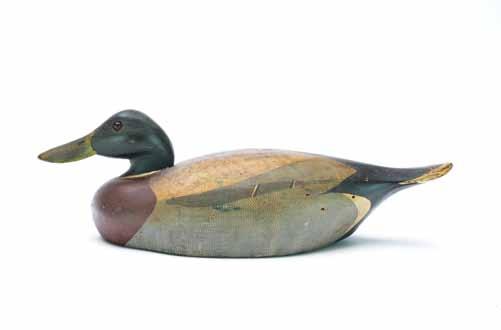
340 Ken Harris (1905-1981), Woodville, New York. Rare preening black duck. Long tail style with large eye socket carving. Scratch feather paint detail on body. Measures 14.5” long. Original paint with moderate wear; small chips and roughness on edge of tail; crack along the back was filled in the making with some paint flaking and touchup along that area.
Provenance: Chris Pitman collection. (800 - 1,200)
341 Ken Harris (1905-1981), Woodville, New York. Uplooking redhead. Long tail style with large recessed eye sockets. Fine comb feather paint detail on back. Small “A” stamped in to underside. Measures 15.75” long. Original paint with minor wear and scattered paint rubs on lower sides; hit by shot; minor roughness on edge of tail.
Provenance: Chris Pitman collection. (800 - 1,200)
342 Ken Harris (1905-1981), Woodville, New York. Mallard. Long tail style with deep recessed eye sockets and comb feather paint detail. Maker’s ink stamp on underside. Measures 17” long. Original paint with minor wear; lightly hit by shot; an early coat of varnish has darkened with age; a few shallow dents in back.
Provenance: Chris Pitman collection. (800 - 1,200)
343 Ken Harris (1905-1981), Woodville, New York. Rare early pintail with slightly turned head and comb feather paint detail. Long tail style with carved eye grooves and large recessed eye sockets. Remnants of maker’s ink stamp on underside. Measures 16.75” long. Original paint with moderate gunning wear; surface has darkened with age; crack through neck; drying crack along the back; large chip at tip of tail and one side of bill tip.
Provenance: Chris Pitman collection.
(1,500 - 2,500)

344 Ken Harris (1905-1981), Woodville, New York. Goldeneye hen and drake. Long tail style with large recessed eye sockets. Hen with slightly turned head and maker’s ink stamp on the underside. Hen is also branded “WT” for the collection of William Towner. Measure 17” and 16” long. Original paint with minor wear and moderate discoloration; each with a hairline crack in one eye; drying crack along the back of hen.
Provenance: Chris Pitman collection.
(1,200 - 1,800)
345 Ken Harris (1905-1981), Woodville, New York. Black duck with slightly turned and tucked head. Long tail style with scratch feather paint detail and large recessed eye sockets. Maker’s ink stamp on the underside. Measures 18.25” long. Original paint with minor wear; moderately hit by shot.
Provenance: Chris Pitman collection.
(1,000 - 1,400)





346
347
Ken Harris (1905-1981), Woodville, New York. Mallard hen with slightly turned head and extensive scratch feather paint detail. Long tail style with large recessed eye sockets. Rig stencil on underside partially painted over appears to say “Roy Japp Rochester, NY.” Measures 16.5” long. Original paint with very minor wear; hairline crack along underside and a small dent in back, otherwise excellent.
Provenance: Chris Pitman collection. (1,200 – 1,800)
348
Ken Harris (1905-1981), Woodville, New York. Rigmate pair of redheads. Long tail style with large recessed eye sockets and comb feather paint detail on drake’s back. Maker’s ink stamp on the undersides. Measure 16” long. Original paint with very minor wear; scattered paint rubs; separation in wood grain that runs along the underside of hen; including lower breast and tail area has been secured with an old screw and nails; hairline crack in one of hen’s eyes.
Provenance: Chris Pitman collection. (1,200 - 1,800)
Ken Harris (1905-1981), Woodville, New York. Wood duck with slightly turned head and extended crest. Fine comb feather paint detail. Maker’s ink stamp on the underside. Measures 13” long. Very good and original.
Provenance: Chris Pitman collection. (600 - 900)
349 Ken Harris (1905-1981), Woodville, New York. Wood duck hen with extended crest and scratch feather paint detail. Maker’s ink stamp on the underside. Measures 12.25” long. Original paint with very minor wear; excellent structurally.
Provenance: Chris Pitman collection. (600 - 900)

350 Ken Harris (1905-1981), Woodville, New York. Rare bufflehead. Measures 11” long. Original paint with fine crazing; spots of discoloration on one side; long knot visible on back and one side; hairline separation to wood grain on top of head.
Provenance: Chris Pitman collection. (600 - 900)
350A Ken Harris (1905-1981), Woodville, New York. Preening black duck with comb feather paint detail and large recessed eye sockets. Maker’s ink stamp on the underside. Measures 14.5” long. Original paint with minor wear; surface has faded over time; drip of varnish on one side.
Provenance: Chris Pitman collection. (1,200 - 1,800)
350B Ken Harris (1905-1981), Woodville, New York. Pair of pintails with comb feather paint detail. Hen with slightly turned head and ink stamp on underside. Both with large recessed eye sockets. Measure 17.5” and 16.25” long. Original paint with very minor wear; minor roughness on tip of drake’s bill and tail; drying crack along the underside of hen.
Provenance: Chris Pitman collection. (2,000 - 3,000)



Born in France, Colonel Sweny came from a proud family of Army officers. In 1856, he attended Cambridge University in England but when the (so called) Indian Mutiny broke out, he obtained a commission as Ensign in the Kings Own Royal Regiment and proceeded to India to aid in quelling the violence. He retired from the Army in 1885 with a rank of Colonel, serving in the Royal Fusiliers. In 1852, he married Mary Roy, and the couple had two sons. Mary died in 1880 and five years later, George married her younger sister, Alice. He arrived in Canada in 1885 to live out a comfortable life in retirement. By 1891, the family retained the services of 5 domestics and, by 1911, this number had grown to 8. He passed away at the family home, “Roballion”, in Toronto. His obituary notes his many associations with civic, benevolent and military groups as well as his memberships in various rowing and golf clubs. Oddly, there is no mention of his long, and deep-seated, involvement with the Turkey Point Company Hunt Club on Lake Erie.

The Turkey Point Company was formed in 1885 by Samuel D. Woodruff (1819 – 1904), a founding member and ex-president of the nearby Long Point Company. Woodruff was the past superintendent of the Welland Canal as well as, among other business interests, the major stockholder in the Lincoln Paper Mills. He gave up his membership at Long Point in 1883 to focus on securing a large area of marsh and upland near Port Rowan for the purpose of establishing a ducking club. Over the next two years, he acquired a significant number of private and Crown land holdings which would ultimately place 2,680 acres under his control. Ten memberships were sold and the Club seemingly prospered until 1890. In that year, Sweny purchased 25 of the original
50 shares in the charter and, over the next few years, his family and lawyer purchased the rest. The Colonel maintained his continuous reign over the club and its properties through both good and harsh times until the time of his death in 1918.
By the time of Sweny’s taking the reins of the Turkey Point Company, The Reeves family of Port Rowan, with patriarch Phineas (1833 – 1899) at its head, had become the leading guides, punters and suppliers of decoys for members of Long Point. The decoys produced by the family, especially those by the father, were considered among the finest that could be had, and were the lures of choice by club members that were certainly affluent enough to afford the very finest in hunting gear. It is unknown when Sweny began to hunt prior to his years at Turkey Point (he was not a member of either Long Point or The St Clair Flats Co), but decoys by either Phineas or other early members of the Reeves family are known to be well represented in his personal rig at Turkey Point.
NOTE: Guyette and Deeter would like to thank Mr. Paul Brisco for his valuable assistance.




351 Phineas Reeves (1833-1898), Port Rowan, Ontario, Canada. Canada goose. Hollow with bottom board. “GAS” painted on underside for the rig of Col. George Augustus Sweny (1837-1918). Used at the Turkey Point Club. Early tack eyes. Measures 24” long. Thin original well blended paint; numerous small dents and scratches from in use wear; top piece of tail was broken and reattached; crack at base of one side of neck also appears to have been reset.
Provenance: Tom Karras collection. (15,000 - 25,000)



George was a young man in his twenty’s when his family immigrated to Canada from England. The group, including George’s brother, James, and his wife Sarah, settled in Toronto. In need of work, they found ample opportunities on the city’s thriving waterfront, teaming with business’s catering to the boating industry. Large commercial craft plied the waters of Lake Ontario and recreational boating was extremely popular. Smaller boats were in demand by canoeists, fishermen, sailors, and hunters. Racing of all sorts was a particularly fashionable pastime. By 1868, George is found in the city directory, listed as a “boat builder” (his younger brother James is similarly listed as early as 1863). Both men were talented craftsmen, and this trade would sustain them for the remainder of their lives. Both found employment with a boat building company owned by Bob Renardson and, by 1876, they had bought the company from him while retaining Renardson as an employee. The new company became “G & J Boatbuilders”. Both brothers applied for, and were granted, a number of Canadian patents for various improvements they made in the industry, George for a “Warin’s shooting skiff” and James for an “Improvement in oars” among others. George himself was a very talented rower and was the person who taught Ned Hanlon who would go on to become five-time world champion. Hanlon was subsidized by wellknown Toronto decoy maker David Ward (1838 – 1912), so Warin was very likely familiar with him and his decoys.
George was, for the longest time, a bachelor who boarded with his brother, his wife, children, and a “servant”. When James died in 1884, George married Sarah a short three years later. He was 57 and she, 33. Sarah had five children with James and would go on to have an additional five with George, resulting in the obvious necessity of the large home which they owned on 116 Seaton St.
George was an avid duck hunter and, apparently, a very good one. He became one of the founding members of The Saint Clair Flats Shooting Company in 1874 and, in 1901, was selected to guide, and supply the decoys for, the Prince of Wales (who became King George V) and his party on a trip to Lake Manitoba. Unfortunately, one of his hunting trips involved an accidental gun discharge resulting in the loss of his left hand and portion of his lower forearm.
Being a master woodworker and boatbuilder, Warin obviously possessed the skills, tools, and materials necessary to carve his own decoys. He sold a few of his decoys locally, but most found their way into the rigs of wealthy sportsmen at the prestigious clubs of the day, such as the Saint Clair Flats Club and the Long Point Club. His birds closely adhered to the accepted local standard, both in form and construction. His, however, with their finely applied painted surfaces, are considered among the best.
His success allowed him to enjoy a comfortable life. In addition to his large, nicely appointed home in Toronto, he maintained a fine retreat at Hanlan’s Point on Toronto Island in Toronto Harbor where he enjoyed his later years. He named his home on the Island, “Fort Warin” and it was there that he passed away.


This style of Warin decoys has come to be known as the Price rig, named after the people that found them. Dr. Ralph and Patricia Price, from Port Perry, Ontario, found eight decoys at a hunt club on Lake Scugog, west of Toronto, around 1970. They are characteriz ed by their particularly strong feather painting, feather light weight and unbranded bottom boards. Another small group of four were found in Eastern Ontario. It is believed that they came out of the Sc ugog Island Hunt Club prior to Dr. Price’s discovery in 1970.


352 George
Ontario. Last quarter 19th century. Canada goose, hollow with bottom board. From the Price rig, with a paint pattern that differentiates it from other Warin geese. Approximately 12 geese were in this rig. Measures 24” long. Original paint with professional restoration to bill; two cracks at base of neck; a crack filled along lower edge of one side and a very small piece along one edge of tail; paint has crazed slightly, several scratches and imperfections in wood; chip at tip of tail; in the making filled crack along one side of base.
Provenance: Gene and Linda Kangas collection. (12,000 - 18,000)

353

Unknown maker, 19th century, Toronto Harbor, Ontario. Rare dunlin from the Southam rig with inserted metal legs and tack eyes. Measures 7.5” long. Original paint with minor wear; lightly hit by shot; a thin coat of wax was added to bird and wooden base at some point. (8,000 - 12,000)

353A Unknown maker, Toronto Harbor. 2nd half 19th century. Ruddy turnstone with wire legs and wooden base mount. Legs extend beyond wooden base for placement in Toronto Harbor’s sandy beach. Measures 9” long. Strong original paint with a few tiny bird shot scars; small rough area at tip of bill; discoloration from age throughout and paint rub to bare wood at one side of tail. (5,000 - 7,000)




Thomas Chambers (1860-1948), Toronto, Ontario. Hollow carved canvasback with .25” bottom board and fine comb feather paint detail on back. short body style. Measures 15.25” long. Original paint with minor wear; hit by shot; crack through neck; tight crack in front of neck. (2,000 - 3,000)
355 Thomas Chambers (1860-1948), Toronto, Ontario. Hollow carved redhead with .25” bottom board. Fine comb feather paint detail on sides. Measures 16” long. Original paint with minor flaking and wear; small dents and shot marks; hairline separation in wood grain on sides with a few small nails added to secure. (1,500 - 2,500)
356 John Kellow, Toronto, Ontario, 2nd quarter 20th century. Solid body black duck with raised neck seat. Measures 16.25” long. Original paint with minor wear; small dents and shot marks; minor roughness on edge of tail; small chip in underside of bill tip was reset with small amount of blunting on tip.
Provenance: Chris Pitman collection.
(800 - 1,200)

357 Don Reid (1862-1920), Hamilton, Ontario. Hollow carved redhead with .25” bottom board. Branded “D.R.” twice on underside. Measures 14” long. Original paint with moderate gunning wear; hit by shot; a few filled shot strikes in breast; black on breast and underside of tail with a thin second coat.
Provenance: Chris Pitman collection.
(1,000 - 1,400)

358 Unknown maker, 20th century, Ontario. Solid body redhead with comb feather paint detail. “V” branded in underside. Measures 16” long. Original paint with minor to moderate wear under an early coat of varnish that has darkened with age; lightly hit by shot; nail added to each side of neck seat.
(1,200 - 1,800)




359 Ed Laflair (1891-1971), Ogdendsburg, New York. Excellent canvasback with slightly turned head and slight ridge carving down tail. Lower sides are chamfered to a flat underside. Measures 15.75” long. Original paint with minor discoloration and wear; lightly hit by shot; cork plugging recessed screw hole on underside appears to have been replaced, but the head is all original with two small nails added to neck seat.
Provenance: Chris Pitman collection. (1,500 - 2,500)
360 Ray Andress (1890-1955), Gananoque, Ontario. Canvasback with partially inlayed neck seat and fine comb feather paint detail on back. Measures 14.25” long. Original paint with very minor wear under a thin coat of varnish; lightly hit by shot; bill was cracked down with two small nails added from underside to resecure.
Provenance: Chris Pitman collection. (1,200 - 1,800)
361 Ray Andress (1890-1955), Gananoque, Ontario. Redhead with partially inlayed neck seat and fine comb feather paint detail. Measures 14” long. Original paint with minor wear; roughness on edge of tail; 1” x 4” area of touchup to black on one lower edge of breast.
Provenance: Chris Pitman collection. (1,000 - 1,500)
362 Ray Andress (1890-1955), Gananoque, Ontario. Rare swimming black duck. Scratch feather paint detail. Measures 18” long. Original paint with very minor wear; small tail chip repair; filled crack along one side with touchup has opened slightly.
Provenance: Chris Pitman collection. (2,000 - 3,000)
363 Ray Andress (1890-1955), Gananoque, Ontario. Black duck, 1st half 20th century. Fine scratch painting over head and body. Measures 16” long. Strong original paint with a few shot scars; mostly on one side; a few other small nicks and dents.
Provenance: Chris Pitman collection. (800 - 1,200)

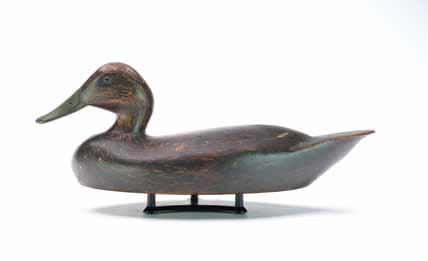
364 James Stanley (1855-1927), Cape Vincent, New York. Rigmate pair of bluebills. Comb feather paint on drake’s back. Measure 13.5” long. Original paint that has darkened with age; shows minor gunning wear; a few small black paint drips on hen’s back; drake is lightly hit by shot, mostly on head and bill.
Provenance: Chris Pitman collection. (700 - 1,000)

366 Billy Ellis (1865-1963), Whitby, Ontario. First half 20th century. Low head model black duck. Measures 17” long. Strong original paint; shows very little gunning wear; very tight crack at top of one side of bill. (800 - 1,200)




367 Billy Ellis (1865-1963), Whitby, Ontario. Pair of greenwing teal. Fine comb feather painting on sides. Measure 12” long. Thick original paint with very minor wear; excellent structurally. (1,500 - 2,500)
368 William Clarke, Toronto, Ontario, 2nd quarter 20th century. Rigmate pair of goldeneye. With fine wet on wet blending on back of both. Measure 14” long. Original paint with roughness around bottom edge; tails, and bill from light gunning use.
(1,200 - 1,500)
369 Burleigh Brothers, Toronto, Ontario. 2nd quarter 20th century. Rigmate pair of bluebills. Drake has comb painting on top of back, carved wing separation. Measure 16” long. Both have original paint with light gunning wear; heads are slightly loose on both decoys; drake’s has been glued in place but is slightly offset; hen has slight separation at neck; both have minor rubs and dents from in use wear. (800 - 1,200)


370 William Cooper (1886-1975), Verdun, Quebec. Very rare rigmate pair of bluewing teal. Relief wing and tail feather carving. Hen is hollow carved, drake with slightly turned head. Both stamped “Clayton 6449” on underside. Measure 11.5” long. Original paint with minor gunning wear; a few shot strikes, with two on drake’s bill being darkened; very slight separation at hen’s body seam; both of the undersides with old gray paint.
Provenance: Dick Brust collection. (3,000 - 5,000)
371 Orel Leboeuf (1886-1968), St. Anicet, Quebec. Bluebill hen with slightly turned head and deep relief wing and tail feather carving. Measures 14.5” long. Original paint with very minor wear; small spot of flaking on one wing; spot of unpainted filler added to a hole on lower edge near tail.
Provenance: Chris Pitman collection. (1,500 - 2,500)

1862 - 1952 | East Harwich, Massachusetts





372 A. Elmer Crowell (1862-1952), East Harwich, Massachusetts. Decorative jack snipe. Maker’s rectangle stamp on underside of base. Also identified Jack Snipe. “A. Hardy Dempsey to J. Ashley Dempsey” carved in underside of base. Measures 9.5” long, stands 8” tall. Excellent original paint; minor flaking and stress cracks at jesso thighs and leg joints; two jesso toes are missing.
Provenance: Tom Karras collection. (12,000 – 18,000)



373 A. Elmer Crowell (1862-1952), East Harwich, Massachusetts. 2nd quarter 20th century. Full size ruddy turnstone with glass eyes, split dropped tail, and mounted to a carved wooden base that bares Crowell’s rectangular stamp. Stands 6.5” tall. Excellent original paint with replaced thigh putty and paint restoration in those areas.
Provenance: Tom Karras collection. (10,000 - 15,000)
374 A. Elmer Crowell (1862-1952), East Harwich, Massachusetts. Decorative greater yellowlegs. Maker’s oval brand on the underside of base. Measures 12” long, stands 12” tall. Original paint under a thin coat of varnish; professional restoration to legs and feet; bill is a very well done professional replacement; some touchup on one side of raised wingtip.
Provenance: Tom Karras collection.
(6,000 - 9,000)



375 A. Elmer Crowell (1862-1952), East Harwich, Massachusetts. 2nd quarter 20th century. Approximately half size tern. With dropped, split tail and relief carved shoulders. Mounted to a painted quahog base. Retains Crowell’s rectangular stamp with inscription that reads “To Norm and Issie from Elmer Crowell, Cape Cod”. Measures 7.5” long. Excellent original paint; very tip of bill has been darkened.
Provenance: Tom Karras collection. (5,000 - 7,000)





376 A. Elmer Crowell (1862-1952), East Harwich, Massachusetts. 2nd quarter 20th century. Carved sanderling with glass eyes. Mounted on painted quahog base that bares Crowell’s rectangular stamp. Stands 4.5” tall. Strong original paint; professional restoration to the thigh area at top of one leg.
Provenance: Tom Karras collection. (4,000 - 6,000)



377 A. Elmer Crowell (1862-1952), East Harwich, Massachusetts. 2nd quarter 20th century. Ring neck plover with glass eyes. Mounted on carved wooden quahog base. Bares Crowell’s rectangular stamp and is also signed “AE Crowell Cape Cod”. Stands 5.5” tall. Strong original paint; with some very concentrated small dots of what appears to be pitch bleed seeping through white paint on breast and under tail.
Provenance: Tom Karras collection. (4,000 - 6,000)


378 A. Elmer Crowell (1862-1952), East Harwich, Massachusetts. 2nd quarter 20th century. Approximately half size woodcock with glass eyes, wire legs, mounted to a carved painted base that bares Crowell’s rectangular stamp and is signed “A Crowell, Cape Cod.” Measures 6.5” long. Very good in all respects.
Provenance: Tom Karras collection. (5,000 - 7,000)



379 Albert Ditman (1884-1974), Williamstown, Massachusetts. Four miniature upland game birds. Includes a grouse with fanned out tail, a woodcock, quail, and pheasant. Measure from 3” - 6” long. Original paint with a few scattered flakes; tight crazing on pheasant including base; with some restoration to jesso thighs on grouse; woodcock and grouse with professional bill replacements.
Provenance: Dan Graf collection. (800 - 1,200)
380 Albert Ditman (1884-1974), Williamstown, Massachusetts. Two pairs of miniature upland game birds. Includes a pair of pheasant and a pair of valley quail. Quail male has a paper Abercrombie & Fitch label on the underside with a price of $15. Pheasant measure 5” and 6” long. Quail measure 4” and 4.5” long. Original paint with a few very minor paint flakes; tight crazing on cock pheasant; professional repair to male quail’s bill and head feather; minor blunting at tip of hen peasant’s tail. (1,000 - 1,400)



381 George Boyd (1873-1941), Seabrook, New Hampshire. Pair of miniature redheads. Both identified on the underside. Measure 4” long. Original paint with a few tiny flakes on heads; hairline separation at hen’s neck seat.
Provenance: Dan Graf collection. (2,000 - 4,000)
382 George Boyd (1873-1941), Seabrook, New Hampshire. Miniature widgeon. Identified in pencil on underside. Measures 4” long. Original paint with scattered rubs; two tiny dents in top of bill; otherwise very good structurally.
Provenance: Dan Graf collection.
Literature: “Finely Carved & Nicely Painted” by Jim Cullen, page 73, exact carving pictured. (1,000 - 1,400)
383 George Boyd (1873-1941), Seabrook, New Hampshire. Miniature swimming long-tail duck hen. Identified in pencil on the underside. Measures 4” long. Original paint that has darkened with age; scattered paint rubs; excellent structurally.
Provenance: Dan Graf collection.
Literature: “Finely Carved & Nicely Painted” by Jim Cullen, page 71, exact carving pictured. (1,200 - 1,800)
384 George Boyd (1873-1941), Seabrook, New Hampshire. Extremely rare miniature swimming blue goose. Measures 5” long. Original paint under a thin coat of varnish that has darkened with age; very fine crazing; excellent structurally.
Provenance: Dan Graf collection. (2,000 - 4,000)

385 George Boyd (1873-1941), Seabrook, New Hampshire. Pair of miniature greenwing teal with slightly turned heads. Both identified in pencil on underside. Measure 3.75” long. Original paint with scattered paint rubs; both are excellent structurally.
Provenance: Dan Graf collection.
Literature: “Finely Carved & Nicely Painted” by Jim Cullen, page 40, exact pair pictured. (2,000 - 3,000)

386 George Boyd (1873-1941), Seabrook, New Hampshire. Pair of miniature goldeneye. Both identified in pencil on underside. Measure 3.75” long. Fine hairline crack in drake’s back and one side of neck seat; otherwise both are near mint.
Provenance: Dan Graf collection.
Literature: “Finely Carved & Nicely Painted” by Jim Cullen, page 45, exact pair pictured. (2,000 - 3,000)




387 George Boyd (1873-1941), Seabrook, New Hampshire. Miniature white fronted goose with reared back head and tiny tack eyes. Measures 4” long. Original paint with very minor discoloration and wear; excellent structurally.
Provenance: Dan Graf collection.
Literature: “Finely Carved & Nicely Painted” by Jim Cullen, page 58, exact carving pictured. (1,200 - 1,800)
388 George Boyd (1873-1941), Seabrook, New Hampshire. Pair of miniature bluebills with slightly turned heads. Both identified in pencil on the underside. Also numbered 1 and 2. Measure 4.25” long. Small amount of very fine crazing; hairline crack in hen’s bill was tightly reset.
Provenance: Dan Graf collection. (2,500 - 3,500)
389 George Boyd (1873-1941), Seabrook, New Hampshire. Pair of miniature pintails. Identified in pencil on underside. Drake with inset wooden tail sprig. Measure 4.25” and 5” long. Hen is near mint; drake with moderate to significant paint shrinkage on back and a few tiny paint rubs.
Provenance: Dan Graf collection.
Literature: “Finely Carved & Nicely Painted” by Jim Cullen, page 73, exact carving pictured. (2,000 - 4,000)
390 George Boyd (1873-1941), Seabrook, New Hampshire. Miniature quail with extended head feathers. Measures 3.5” long. Chipping at head feathers, otherwise excellent and original.
Provenance: Dan Graf collection. (2,000 - 3,000)

391 George Boyd (1873-1941), Seabrook, New Hampshire. Miniature passenger pigeon female. Measures 4” long. Tiny paint flakes on tip of bill and a tiny chip in tip of tail, otherwise excellent.
Provenance: Dan Graf collection.
Literature: “Finely Carved & Nicely Painted” by Jim Cullen, page 69, exact carving pictured. (2,000 - 3,000)

392 George Boyd (1873-1941), Seabrook, New Hampshire. Miniature swimming mute swan. Belligent pose with slightly turned head. Measures 5.5” long. Original paint that has darkened with age; a few minor paint rubs, otherwise excellent.
Provenance: Dan Graf collection.
Literature: “Finely Carved & Nicely Painted” by Jim Cullen, page 58, exact carving pictured. (2,000 - 3,000)




393 George Boyd (1873-1941), Seabrook, New Hampshire. Miniature killdeer. Measures 3.75” long. A few scattered paint rubs, otherwise excellent and original.
Provenance: Dan Graf collection. (1,500 - 2,500)
394 George Boyd (1873-1941), Seabrook, New Hampshire. Miniature red knot. Measures 3.5” long. Two tiny paint rubs on one side and on tip of bill, otherwise excellent.
Provenance: Dan Graf collection.
Literature: “Finely Carved & Nicely
Painted” by Jim Cullen, page 68, exact carving pictured. (1,500 - 2,500)
395 George Boyd (1873-1941), Seabrook, New Hampshire. Miniature piping plover. Identified on the underside. Measures 3.25” long. A few very minor paint rubs, otherwise excellent and original.
Provenance: Dan Graf collection.
Literature: “Finely Carved & Nicely
Painted” by Jim Cullen, page 4, exact carving pictured. (1,500 - 2,500)
396 George Boyd (1873-1941), Seabrook, New Hampshire. Miniature eskimo curlew. Measures 5” long. Bill appears to be a professional replacement; otherwise excellent and original.
Provenance: Dan Graf collection. (2,000 - 4,000)

397 George Boyd (1873-1941), Seabrook, New Hampshire. Miniature black bellied plover in winter plumage. Identified on the underside. Measures 4.5” long. A few minor paint rubs, otherwise excellent and original.
Provenance: Dan Graf collection. (1,500 - 2,500)

398 George Boyd (1873-1941), Seabrook, New Hampshire. Miniature yellowlegs. Measures 4” long. Near mint.
Provenance: Dan Graf collection.
Literature: “Finely Carved & Nicely Painted” by Jim Cullen, page 71, exact carving pictured. (1,500 - 2,500)


400 Mike Borrett (b.1960), Madison, Wisconsin. Pair of flying pintails with outstretched and cupped wings. Deep relief wing and tail feather carving. “Borrett ‘00” carved in top of hen’s wing and back of drake. Measure 25” and 20.5” long. Minor blunting on tip of hen’s tail; otherwise very good and original. (1,000 - 1,500)
399 Reggie Birch (b.1953), Chincoteague, Virginia and Berlin, Germany. Full-size sleeping swan in the style of Albert Laing. Hollow carved with 1” bottom board. “R Birch” carved in underside. Measures 28” long. Made to look older, excellent and original. (1,500 - 2,500)



401 Jon Jones (b.1955), Algonac, Michigan. Widgeon drake with slightly turned head. Signed by maker on underside and dated 2023. Comb painting on back. Measures 14” long. Excellent and original. (800 - 1,200)


402 Jon Jones (b.1955), Algonac, Michigan. Pair of decorative mallards with slightly turned heads and relief wingtip carving. This exact pair of mallards were carved by Jon as the unique molds for the Greenhead Gear Essential series mallards. Drake with carved curly tail sprig. Extensive feather carving. Signed and dated 2013. Measure 14.5” and 14” long. Excellent and original. (3,000 - 4,000)


Little Deer Isle, Maine


404 Josh Brewer, Little Deer Isle, Maine. Outstanding hollow carved swordfish with relief gill and eye carving. Applied Mahogany fins, silicon bronze hardware, and excellent paint detail. “Brewer” carved in underside of fish. Signed and dated 2005 on underside of hardwood base that includes a harpoon. Measures 46.5” long, 23.5” tall including base. Also included are two custom made wall brackets for the option to wall mount. Excellent and original.
(6,000 – 9,000)


405 Josh Brewer, Little Deer Isle, Maine. Hollow carved brant with tucked and reared back head.

Deep relief wing carving and extended wingtips. “Brewer” carved in underside. Measures 15.25” long. Excellent and original.
(3,000 - 5,000)

406 George Strunk (b.1958), Glendora, New Jersey. Pair of oversized redbreasted mergansers. Drake in preening pose, with one wing slightly raised. Hen in sleeping pose. Each with extended crest and deep relief wingtip and tail feather carving. Fine comb feather paint detail on sides of drake. Signed on the undersides. Measure 21” and 18.5” long. Excellent and original. (800 - 1,200)
407 George Strunk (b.1958), Glendora, New Jersey. Pair of oversized preening American mergansers. Hollow carved with deep relief wing carving. Signed and dated 2008 on the underside. Measure 18.5” long. Excellent and original. (800 - 1,200)


408 George Strunk (b.1958), Glendora, New Jersey. Pair of wood ducks with slightly turned heads and extended crests. Raised wingtip and relief tail feather carving. “G Strunk” stamped in lead weights. Measure 13.5” long. Excellent and original. (600 - 900)
409 George Strunk (b.1958), Glendora, New Jersey. Canada goose with tucked head. Hollow carved with relief wingtip and tail feather carving. Signed and dated 1997 on the underside. “G. Strunk” stamped in lead weight. Measures 18.5” long. Excellent and original. (500 - 800)


410 George Strunk (b.1958), Glendora, New Jersey. Flying willet with outstretched wings and relief feather carving. Wooden mount for attaching to a wall. Signed under one wing. Measures 14” long, with a 12.5” wingspan. Small hole in back was filled and touched up by the maker where a eyelet for hanging was removed, otherwise excellent. (500 - 800)
411 George Strunk (b.1958), Glendora, New Jersey. Flying dove with outstretched wings and relief wing feather carving. Signed on the underside. Wooden mount for hanging on a wall. Measures 13.25” long, with a 9.5” wingspan. Small hole in back was filled and touched up by the maker where an eyelet for hanging was removed; small hole drilled in underside for use as a stickup; otherwise excellent. (500 - 800)



412 Bob Moreland (21st century), Harrisonburg, Virginia. Full-size red tail hawk with dead crow. Both are hollow carved with hinges allowing them to be opened. Maker’s initials on inside of each. Crow with recessed compartment on inside that holds a deep relief carved crow call depicting an owl and two crows. Call is dated 2002. Hanging pull cord mechanism flaps one wing of the crow. Hawk measures 20” long, 73.5” tall including stand. Excellent and original.
Provenance: Len Carnaghi collection. (1,200 - 1,800)


413 William Gibian (b.1946), Onancock, Virginia. Decorative standing curlew with turned head and open beak. Deep relief wing carving with raised, crossed wingtips. Base with carved clam and oyster shells. Maker’s business card on underside is signed and dated 7/95. Inscription on business card states that “to date this is the best shorebird I’ve made!”. Measures 13.5” long, stands 14.5” tall. Very minor scratch on top of head; flaking to black paint on metal legs, otherwise excellent.
Provenance: Dan Graf collection. (1,500 - 2,500)
414 William Gibian (b.1946), Onancock, Virginia. Pair of yellowlegs. One in preening pose with one wing slightly lifted. The other in feeding pose with relief wing carving and raised wingtips. “Gibian” carved in the undersides. Measure 10” and 13” long. A few tiny paint rubs and a very fine hairline separation on one side of feeder’s neck seat; otherwise both are excellent.
Provenance: Dan Graf collection. (1,000 - 1,400)
415 William Gibian (b.1946), Onancock, Virginia. Avocet with extended crest. Relief wing carving and raised wingtips. “Gibian” carved in underside. Measures 14” long. Minor sap bleed on breast and underside, otherwise very good and original.
Provenance: Dan Graf collection. (500 - 800)
416 William Gibian (b.1946), Onancock, Virginia. Pigeon with slightly turned head. Deep relief wing carving with extended wingtips. “Gibian” carved on the underside. Measures 12.25” long. Areas of discoloration, otherwise excellent and original.
Provenance: Mike and Ginger Raffia collection. (500 - 800)



417 William Gibian (b.1946), Onancock, Virginia. Dove with head turned 90 degrees. Relief wing carving with raised wingtips. “Gibian” carved in underside. Measures 12” long. Excellent and original.
Provenance: Mike and Ginger Raffia collection. (500 - 800)

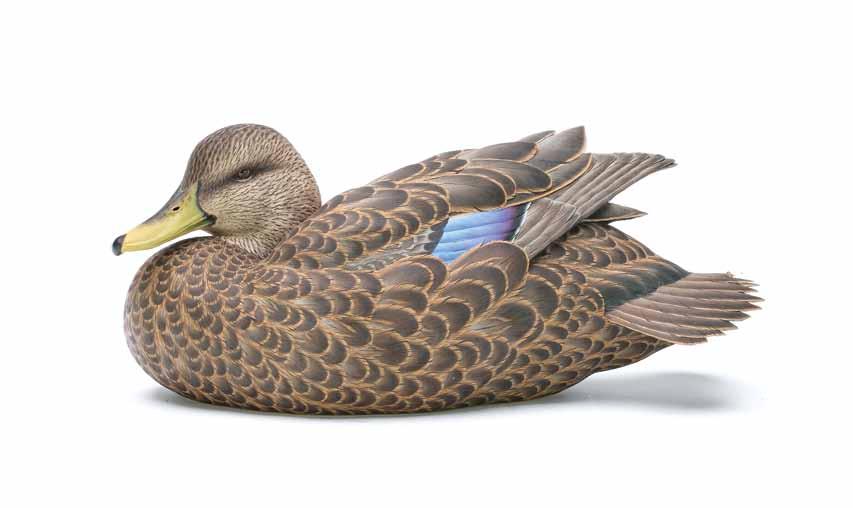
418 Dennis Schroeder, Trinity Alps, California. Outstanding decorative black duck with slightly turned and tucked head. Raised and crossed wings and deep relief feather carving. Signed and dated 2002 on the underside. Measures 14.25” long. Excellent and original. (4,000 - 6,000)


419 G. Walter, Ontario, Canada. Excellent decorative spruce grouse with highly detailed feather carving and thin inserted tail feathers. Dropped wings and slightly turned head. Carved base with a small ladybug and two mushrooms. Signed and dated 12/15/90. Stands 17” tall including base. Original paint has mellowed with age; smaller mushroom was glued back to base; chip at tip of one wingtip; a few of the tail feathers were chipped and reglued. (4,000 - 6,000)
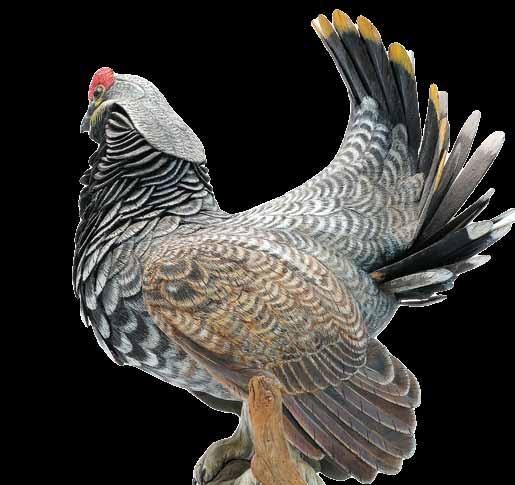


420 Jim Schmiedlin (1945-2015), Bradfordwoods, Pennsylvania. Hollow carved hooded merganser with slightly turned head and extended crest. “JAS” brand and maker’s reward for return label on underside. Also dated 10/94 with writing about where the decoy was used. Measures 16” long. Original paint with minor gunning wear; a few tiny dents on edge of tail; small spots of flaking near one wing. (6,000 - 9,000)


421 Leo McIntosh (1953-2007), Adams, New York. Excellent rigmate pair of wood ducks. Hollow carved with slightly turned heads and extended crests. Drake with tucked head, hen with slightly raised head. Both with relief wingtip and tail feather carving. Maker’s name carved in the underside. Measure 13.5” and 14” long. Original paint with moderate crazing and wear; both are hit by shot; very minor roughness on edge of hen’s bill.
Provenance: Len Carnaghi collection. (1,500 - 2,500)
422 William Schultz (1923-2009), Milwaukee, Wisconsin. Pair of hollow carved bluewing teal. Relief wing carving and slightly turned heads. Inscription on underside says that this pair won 3rd place in the 1969 Canadian National Decoy Show. Carved for Dick Brust. Measure 12.25” and 13” long. Some very minor sap bleed, otherwise excellent and original.
Provenance: Dick Brust collection. (2,000 - 3,000)




423 Roger Barton, San Francisco, California. Pair of greenwing teal with slightly turned heads and relief wing and tail feather carving. Both are signed and dated 1971. Drake with writing on underside indicating it was used on Suisun Marsh, San Francisco Bay, California. Hen with inscription that reads “This is the best damn teal these old hands has ever did. (if you believe that you are a born collector)”. Measure 10.5” long. Excellent and original.
Provenance: Dick Brust collection. (800 - 1,200)
424 Roger Barton, San Francisco, California. Feeding ruddy turnstone. Measures 8.25” long. Excellent and original. (300 - 500)
425 Roger Barton, San Francisco, California. Dowitcher with tucked head. Signed and dated 1995 on underside of base. Measures 9.5” long. Tiny spot of discoloration on underside, otherwise excellent and original. (300 - 500)
426 Roger Barton, San Francisco, California. Feeding willet. Measures 12.5” long. Excellent and original. (300 - 500)
427 Al Glassford (b. 1927), Scarborough, Ontario. Greenwing teal with slightly extended crest and relief wing and tail feather carving. Thick comb paint detail. Competition decoy was a blue ribbon winner at the Davenport Show 1970. Measures 12.5” long. Excellent and original.
Provenance: Dick Brust collection. (400 - 600)


428 Al Glassford (b. 1927), Scarborough, Ontario. Outstanding pair of sleeping greenwing teal. Made for the 1968 International Decoy Contest, with stickers on the underside. Extended, raised wingtips and relief feather carving. Measure 10.5” long. Excellent and original.
Provenance: Dick Brust collection. (1,000 - 1,500)
429 Del Herbert (b.1942), Chula Vista, California. Hooded merganser with slightly turned and tucked head. Extended crest and relief wingtip carving. Signed and numbered 301, as well as a small wood burned scene of a wading godwit. Measures 12” long. Small paint rub on one side; otherwise excellent. (600 - 900)




430 Harold Haertel (1904-1995), Dundee, Illinois. Excellent pair of cinnamon teal with slightly turned heads and relief wingtip carving. Highly detailed scratch feather paint. Identified, signed, and dated 1976 on the underside. Measure 11.5” long. Excellent and original.
Provenance: Dick Brust collection. (1,200 - 1,800)
431
Harold Haertel (1904-1995), Dundee, Illinois. Excellent pair of greenwing teal with slightly turned heads and relief wingtip carving. Highly detailed scratch feather paint. Identified, signed, and dated 1972 on underside. Measure 11.75” long. A few tiny paint rubs; otherwise excellent and original.
Provenance: Dick Brust collection. (1,200 - 1,800)
432 Harold Haertel (1904-1995), Dundee, Illinois. Hen and drake bluewing teal with relief wingtip carving. Hen with slightly turned, down-looking head. Highly detailed scratch feather paint detail. Both are identified and signed on the underside. Hen 1968, drake 1971. Measure 10.75” long. Excellent and original.
Provenance: Dick Brust collection. (1,200 - 1,800)
433 Jim Foote (1925-2004), Gibraltar, Michigan. Hollow carved canvasback hen with highly detailed feather carving and slightly turned head. Signed and dated 1978. Measures 13.75” long. Excellent and original.
Provenance: Len Carnaghi collection. (800 - 1,200)

434 Jim Foote (1925-2004), Gibraltar, Michigan. Goldeneye hen made for the 1971 US National Decoy Show, Babylon, New York. Tucked and slightly turned head. Relief wing and tail feather carving. Signed on the underside where the competition wooden keel was removed. Measures 13” long. Some minor discoloration from a thin coat of varnish, otherwise excellent and original.
Provenance: Len Carnaghi collection. (500 - 800)
435 Jim Foote (1925-2004), Gibraltar, Michigan. Hollow carved redhead with tucked and slightly turned head. Relief wingtip and tail feather carving. Signed to Pete Peterson and dated 1979 on the underside. Measures 14.25” long. A few very minor paint rubs, otherwise excellent and original.
Provenance: Len Carnaghi collection. (500 - 800)



436 Duncan McFarlane (English, 1834-1871), oil on canvas. Titled “The Pride of Canada,” 1861. Image size 24” x 36”. Signed “D. McFarlane 1861”. As viewed under UV light a few smaller spots of inpainting; painting has been lined and cleaned; for its age remains very good.
Provenance: Tom Karras collection
(10,000 - 15,000)
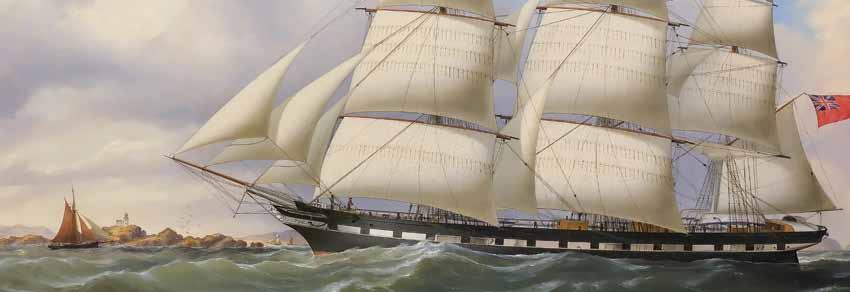

437 William Henry Titcombe (1824-1888), attributed, oil on canvas. Image measures 26” x 36”. A view of Mt Washington and the Saco River across North Conway Valley from Sunset Hill. Purchased from the William David Fine Art company, Dennis, Massachusetts. Canvas has been relined, stretched, and waxed professionally; craquelure has been conserved with inpainting visible under UV light.
Provenance: Tom Karras collection (4,000 - 6,000)



438 Ambrose Andrews (1805-1859), oil on canvas. Image measures 22” x 30”. Signed. Titled “Sunset Along the Hudson”. Retains Boston Canvas stamp. Period frame. Painting has been conserved over time, remains in good condition for its age; inpainting to stabilize craquelure is visible under UV light.
Provenance: Convington Fine Arts Gallery, Tucson, Arizona. Tom Karras collection (6,000 - 9,000)


439 Charles Paul Gruppe (1860-1940), oil on canvas board. Image measures 11.5” x 15.5”. Signed. As viewed under UV light painting remains in very good condition. (2,500 - 3,500)
1840 - 1916


440 George William Whitaker (1840-1916), oil on board. Depicting the West Island Club off Sakonnet Point, in Little Compton, Rhode Island. Depicts many sailing and steam ships on the far horizon and figures picnicking and walking with parasols. Signed and dated ‘96 lower left.
Image measures 17.5” x 28.5”. Some scattered inpainting on sky and a few small spots on right margin; otherwise excellent. (3,500 - 4,500)

George William Whitaker (1840 – 1916) studied in Paris with Laszlo De Paul and his work was heavily influenced by the Barbizon School of landscape painters. He was one of the original founders of the Providence (RI) Art Club in 1880, as well as a founder of the Providence Watercolor Club. He is considered the “dean of Providence painters” and was the first instructor of oil painting at the Rhode Island School of Design. He exhibited at the National Academy in 1867 and 1869 and at the Boston Art Club throughout the 1880’s. This painting is one of the very few by any artist which features an image of the once prestigious West Island Bass Club.
The West Island Club was formed in 1864 when tiny East and West Islands off Sakonnet Point in Little Compton, Rhode Island were acquired by a group of wealthy New Yorkers “for Angling and Shooting purposes”. Membership was limited to no more than thirty members at any given time and the club roster of owners and guests records men such as J. P. Morgan, John L Cadwalder, Charles Tiffany. Cornelius Vanderbilt, US Presidents Chester Arthur and Grover Cleveland and others of similar affluence and influence. Food, accommodations and service were lavish, and members were often accompanied by their wives, maids and secretaries. Bass fishing was paramount, but shorebirds were pursued in season on the adjoining mainland and the “Shooting Journal of John Henry Mackay” recounts his almost annual visits to the club between 1869 and 1892 for spring scoter shooting. The club flourished until diminishing striped bass populations forced its sale in 1906.


441 Brett Smith (b.1958), oil on board. A western fly fishing scene. Signed and dated ‘97 lower right. Image measures 17.5” x 23.5”. Excellent and original. (2,500 - 3,500)
1921 - 2014


“I enjoyed a career that let me live where I choose, paint mostly what I want and make a decent living doing so”.
- David Hagerbaumer
442 David Hagerbaumer (1921-2014), watercolor on paper. Image measures 26” x 36”. Signed. Canada geese setting in to silhouette decoys. Exceptionally large piece by Hagerbaumer. Excellent detail with 13 geese in flight. Professionally framed and matted. Remains in excellent condition.
(5,000 - 8,000)
Born in Quincy, Illinois, the young Hagerbaumer remained in the Prairie State through the depression, working on the family farm. He served in WWII and, upon returning from service, he lived in San Diego and enrolled in an art program but never completed his degree. For a period, he worked as a taxidermist and assistant ornithologist at the Carson City (NV) Museum. When the Korean War began, he reenlisted and, upon being discharged, returned to California, becoming staff artist and Assistant Curator of Birds and Mammals at the Santa Barbara Museum of Natural History. He had been painting as a sideline throughout this entire period, relying on selling his work on weekends at open air markets in the San Diego and La Jolla area. He got his break when, in his own words, a friend showed his work to Ralph Terrill, the manager of “The Crossroads of Sport” in New York. His work first appeared in the 1956 Crossroads catalog, and he soon reali zed that he could make a living through his art. He was married multiple times, and at the time of his death, he was living in Washington State.
During his lifetime, he achieved remarkable success and widespread acclaim. In addition to his numerous originals, prints and etchings, he wrote and illustrated a number of well received books. Considered one of the premier wildlife artists of his time, his work has been exhibited numerous times at institutions such as The Lehigh Yawkey Woodson Art Museum in Wausau WI and the National Museum of Wildlife Art in Jackson Hole, WY. David Maass once noted: “Dave was truly a sportsman’s artist and has done it all, both with gun and brush.”
443 Chet Reneson (b. 1934), watercolor. Two hunters in a winter marsh scene. Signed and dated ‘78 lower left. Professionally framed and matted. Measures 20.5” x 28.25”. Excellent and original.
(2,000 - 3,000)

444 Reuben Ward Binks (UK 1880-1950), watercolor and gouache on paper. Two shorthaired pointers. Signed lower right. Image measures 17” x 21.75”. Minor toning from age; small spots of foxing in sky; 3.5” crease or thin scratch in front of lead pointer.
(1,200 - 1,800)



445 Rob Leslie (b.1947), acrylic on board. Three woodducks. Excellent detail. Signed lower right. Image measures 16.75” x 27”. Excellent and original.
(800 - 1,200)
Painter Rob Leslie grew up in Wisconsin where hunting is a family tradition, but it wasn’t until he moved to Turnersville in 1985 that he began to put the wildlife around him on canvas. Shunning the 9-to-5 routine and searching for something new to do, Rob dove into his longtime dream of painting, inspired by his hunting experiences. “Seeing everything around me is as much a part of the hunting experience as hunting. It’s impossible to not recognize the beauty that’s around here.” Rob’s acrylics and oils of mammals, game birds, hunting scenes and mostly waterfowl have earned him national acclaim. Ducks Unlimited recognized him as “Artist of the Year” in 1996 for “Just Laying Around”–a painting of green wing teals and black ducks. Rob also won contests for 18 Duck Stamps around the country, including three in New Jersey.


measures 19.5” x 29.5”. Excellent and original.
(800 - 1,200)


measures 9.5” x 23.5”. Excellent and original. (700 - 1,000)
449 Rob Leslie (b.1947), pencil drawing.
Depicting incoming pintails. Highly detailed. Signed lower right. Professionally framed and matted. Image measures 9.25” x 12.5”. Excellent and original. (300 - 500)

450 Rob Leslie (b.1947), pencil drawing. Four incoming geese. Highly detailed. Signed lower left. Professionally framed and matted. Image measures 9.25” x 12.5”. Excellent and original. (300 - 500)

451 Lynn Bogue Hunt (1878-1960), pen and ink. Illustration of a surf fisherman. Signed lower left. Image measures 4” x 8.25”. A few small spots of discoloration, otherwise very good and original. (600 - 900)

452 Lynn Bogue Hunt (1878-1960), pen and ink. Illustration of a Caribbean fishing scene. Signed lower center. Image measures 4” x 8.25”. Very good and original. (600 - 900)



453 Richard Janson (1872-1951), Sonoma Creek, California. Rigmate pair of pintails with relief wing feather carving. “B” stamped in lead weights. Measure 16.75” and 17.75” long. Hen in original paint with moderate gunning wear; shallow chipping and roughness to wingtips and edge of tail; bill was cracked down and tightly reset with some filler added to a chip on top of bill; hairline crack in each eye; drake in mostly original paint with moderate wear; paint on upper breast and head with early repaint; tight drying crack in one side; minor roughness on tip of tail; hairline crack in one eye. (3,500 - 4,500)
454 Amiel Garbaldi (1908-1993), Sacramento, California. Very rare hollow carved Canada goose with slight relief wing carving. Hollowed from the underside. Measures 20.5” long. Mix of original and early in use repaint; with moderate gunning wear; lightly hit by shot; slight separation at neck seat; minor blunting on one side of bill tip. (600 - 900)
455 Amiel Garbaldi (1908-1993), Sacramento, California. Rare hollow carved Canada goose with slight relief wing carving. Hollowed from the underside. Measures 20.5” long. Mix of original and early in use repaint with moderate gunning wear; tight crack through neck; small chip on underside where swing keel was removed.
(600 - 900)

456 Charles Pice (1890-1958), Astoria, Oregon. Hollow carved pintail hen. “GA” stamped on underside. Measures 18” long. Original paint with moderate gunning wear; roughness on edge and tip of tail; small amount of glue visible at neck seat.
(2,000 - 3,000)


457 Ed Snyder (1928-2011), Rio Vista, California. Oil painting on cedar shingle of a preening mallard hen. Signed “Snyder” lower right, and with maker’s ink stamp on the back side. Shingle measures 15.5” x 5”. Moderate discoloration and roughness on shingle; painting is excellent. (400 - 600)



458 Chuck Hall (1908-1995), Barnum, Minnesota. A rare and well executed pike fish decoy, 1st quarter 20th century. With glass eyes. Two belly weights at top of back, as well as a single belly weight on underside. Carved mouth, metal fins with wooden tail. Measures 12” long. Original paint; broken piece of tail that is missing on lower portion of bottom fin. (800 - 1,200)
459 Chet Sawyer (b.1904), Grand Rapids, Minnesota. Fish decoy. Bead eyes with carved mouth and gill. Metal fins. Colorful dot decoration. Measures 7” long. Original paint with some loss at fins; small amount of in use wear. (500 - 800)
460 Chet Sawyer (b.1904), Grand Rapids, Minnesota. Fish decoy, circa 1950. Detailed scale carving, metal fins, and plastic gem stone like eyes. Measures 10.5” long. Very good and original. (500 - 800)



461 Chuck Hall (1908-1995), Barnum, Minnesota. Walleye fish decoy. With carved mouth and gills, and red reflective eyes. Wooden tail that is dovetailed in to the body. Measures 9.5” long. Light to moderate wear; original paint with flaking at fins. (500 - 800)
462 Chuck Hall (1908-1995), Barnum, Minnesota. Eel fish decoy, 1st half 20th century. Carved eyes with metal tack insert. Carved tail and metal side fins running most of the length of the body. Metal pin is visible at back of body fins. Measures 9.5” long. Original paint protected by a coat of varnish; wear and flaking from use. (500 - 800)
463 Fred Lexow (1888-1971), Balsam Lake, Minnesota. Trout fish decoy. An early example of Lexow’s work. Tiny taxidermy eyes, metal fins. Measures 7” long. Strong original paint that has crazed; a few scratches from in use wear; paint loss at fins. (800 - 1,200)



464 Ernie Aamodt (1915-2005), Crosby, Minnesota. Fish decoy. A wildly decorated red, white, and black fish. Metal fins. Painted black eyes. Measures 7” long. Original paint with some paint added near belly weight and small areas around tail, probably to secure some flaking at one point. (800 - 1,200)
465 Ernie Aamodt (1915-2005), Crosby, Minnesota. Fish decoy. Orange and gray body with black painted eyes. Decorated metal fins. Measures 5” long. Very light in use wear; original and good. (800 - 1,200)
466 Ernie Aamodt (1915-2005), Crosby, Minnesota. Fish decoy. Yellow with green dots and lightly painted scales underneath yellow. Black eyes. Decorated metal fins. Measures 7” long. Original paint appears that a later red application was made around belly weight and two side fins. (800 - 1,200)



467 Ernie Aamodt (1915-2005), Crosby, Minnesota. Fish decoy, first half 20th century. Tricolored body paint with painted black eyes and paint decorated fins. Measures 5” long. Original paint with small amount of flaking at top of head and fins. (600 - 800)
468 Ernie Aamodt (1915-2005), Crosby, Minnesota. Fish decoy with red and white candy stripe body with scale decoration on head and black eyes. Measures 5” long. Original paint with small areas of flaking at fins. (800 - 1,200)
469 Ernie Aamodt (1915-2005), Crosby, Minnesota. Fish decoy, first half 20th century. Metal fins with stamped scales on body. Black painted eyes. Two cheater hooks protrude from lower front of body. Measures 9.5” long. Original yellow and black paint with discoloration from light wear. (800 - 1,200)



470 William Faue (1878-1950), Hanover, Minnesota. Fish decoy. Blended green body sides with painted eyes and metal fins. Measures 9.5” long. Original paint with light to moderate in use wear; some flaking on fins. (800 - 1,200)
471 Otto Faue (1881-1954), Hanover, Minnesota. Fish decoy with glass eyes and metal fins. Multi-colored coats of gold and yellow. Measures 9” long. Original paint with some flaking around belly weight and fins. (1,000 - 1,500)
472 William Faue (1878-1950), Hanover, Minnesota. Fish decoy with metal fins and painted eyes. Measures 7” long. Excellent original paint with very light wear. (1,000 - 1,500)



473 William Faue (1878-1950), Hanover, Minnesota. Fish decoy, 1st half 20th century. A gold scale pattern with painted eyes and metal fins. Measures 7” long. Original paint with some loss and rust areas on metal fins; small rubs around lower edge of mouth; a layer of varnish has darkened slightly. (1,000 - 1,500)
474 William Faue (1878-1950), Hanover, Minnesota. Fish decoy, 1st half 20th century. Metal fins and painted eyes. Measures 6.75” long. Original paint shows moderate wear; some flaking areas on rear fin; area of white touchup to lower area of one side of body. (800 - 1,200)
475 William Faue (1878-1950), Hanover, Minnesota. Fish decoy. Multi-colored body with metal fins. Painted mouth and eyes. Measures 6.25” long. Original paint with flaking at fins. (500 - 800)



476 Raymond Stotz (1897-1976), Scotch Lake, Minnesota. Bass fish decoy with tack eyes. Very detailed mouth and gill carving. Wooden tail. Metal fins. Measures 10.5” long. Strong original paint; protected by a very light coat of varnish. (1,000 - 1,500)
477 Raymond Stotz (1897-1976), Scotch Lake, Minnesota. Bluegill or pumpkin seed, 1st half 20th century. Glass eyes with carved mouth and metal fins. Measures 5” long. Original paint is flaked slightly on a couple of fins, otherwise very good and original. (1,000 - 1,500)
478 Unknown maker, Minnesota. Two fish decoys, Minnesota. Sunfish by unknown maker, measures 6” long. Fine detailed paint and metal fins. One fin is missing, light wear with some flaking at tail. Other fish is by Seagram. Tack eyes and metal fins. 7.5” long. Light in use wear; structurally good. Original paint. (500 - 800)
479 Charles Slechta (1872-1965), Spring Park, Minnesota. Very rare and possibly unique two piece hollow body copper panfish decoy, 1st half 20th century. Cross hatch decoration on spotty sides. Two tone metal eyes. Measures 6.5” long. Very good and original. (1,000 - 1,500)

480 Charles Slechta (1872-1965), Spring Park, Minnesota. Two piece copper full body fish decoy. Cross hatch body decoration and detailed fin decoration. Measures 10.5” long. Very good and original. (1,000 - 1,500)

481 Charles Slechta (1872-1965), Spring Park, Minnesota. Fish decoy. Hollow copper with glass eyes. Cross hatch body decoration and fin detail. Measures 11” long. Light rubs to sides of body from in use wear. (1,000 - 1,500)

482 Charles Slechta (1872-1965), Spring Park, Minnesota. Hollow body copper fish decoy. Probably a walleye. Two tone metal eyes. Fin decoration. Measures 10.5” long. Very good and original. (1,000 - 1,500)




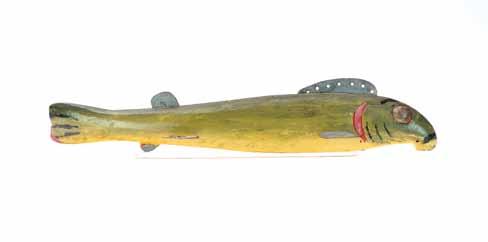
483 Unknown maker, 19th century, Lake Chautauqua, New York. Fish decoy with similar paint decoration as the so called Harry Seymour fish. Tack eyes, carved mouth and gill. Line tie drilled through body. Measures 6.25” long. Good original paint with some flaking and wear on underside; tail has been broken and reattached.
(1,200 - 1,800)
484 Ken Bruning (1919-1974), Rogers CIty, Michigan. Trout fish decoy, circa 1950. Metal fins and tail. The two sides are painted slightly different, which was a characteristic that Bruning did, but it is also rare. Measures 12.5” long. Original paint protected by a coat of varnish; very good and original. (2,000 - 3,000)
485 Oscar Peterson (1887-1951), Cadillac, Michigan. 2nd quarter 20th century. Brook trout with tack eyes. Measures 9” x1 7/8” tall x 3/4 wide. So called cut gill painted version. Original paint protected by a coat of varnish; near excellent.
(1,500 - 2,500)
486 Oscar Peterson (1887-1951), Cadillac, Michigan. 2nd quarter 20th century. Sucker fish decoy with tack eyes. Measures 9” long x 1.25” tall x .75” wide. Original paint that is possibly the work of Jim Nelson; some flaking and bare spots at tip of tail and underside; paint missing from tack eyes.
(400 - 600)



487 Jim Foote (1925-2004), Gibraltar, Michigan. Fish decoy. Perch. Signed and dated 1992 on underside. Measures 9” long. Excellent and original.
Provenance: Len Carnaghi collection. (1,000 - 1,500)
488 Jim Foote (1925-2004), Gibraltar, Michigan. Carved fish decoy. Small mouth bass, signed and dated 1992 on underside. Measures 9.5” long. Strong original paint; structurally good; some over paint visible mostly around belly weight on underside stretching about 2.5”.
Provenance: Len Carnaghi collection. (1,000 - 1,500)
489 Jim Foote (1925-2004), Gibraltar, Michigan. Fish decoy. Sauger. Signed and dated 1991 on underside. Acrylic fins and tail. Measures 9.5” long. Excellent original paint; one of the lower side fins has been reset.
Provenance: Len Carnaghi collection. (800 - 1,200)

490 Oscar Peterson (1887-1951), Cadillac, Michigan. Rare pike hanging trade sign. Deep relief gill carving and glass eyes. Applied metal fins. A single metal eyelet in back for hanging. Measures 36” long. Original paint with minor flaking and wear, mostly on one side; moderate to significant flaking on metal fins; small chip at tip of bottom jaw; small dents on top of back; thin wash of white on one lower side; some black overpaint removed from lower part of tail; two small nail heads visible on one side.
Provenance: David Fannon collection. (15,000 - 25,000)



491 Oscar Peterson (1887-1951), Cadillac, Michigan. Relief carved brook trout plaque with glass eyes. Thick board with metal straps on back to prevent warping. Plaque measures 9.5” x 28.5”. Original paint with very minor wear; moderate crazing to surface of backboard that is fairly uneven; moderate wear on edges of backboard; minor dents and roughness on edge of backboard.
Provenance: David Fannon collection. (15,000 - 25,000)



492 Lawrence Irvine (1918-1998), Winthrop, Maine. Lake trout fish plaque with open mouth and relief gill carving. Fish measures 26”, board measures 13” x 29”. Excellent and original. (1,000 - 1,500)
493 Lawrence Irvine (1918-1998), Winthrop, Maine. Brown trout fish plaque with relief eye and gill carving. Signed on the back of plaque. Trout measures 22.5” long, plaque is 28.5” long. Excellent and original. (1,000 – 1,500)
494 Jim Foote (1925-2004), Gibraltar, Michigan. Perch fish wall plaque, circa 1975. Mounted on board, measuring 14” long. Excellent original paint; one bottom fin broken and reattached.
Provenance: Jim and Patti Aikin collection. (400 - 600)



495 A group of 10 eel spears. All are vintage working spears. Two are attached to wooden handles, that measure approximately 4’ long. All spears show good age. (1,500 - 2,500)

496 Finely made iron fish spear. Seven tines and octagonal metal shaft. Measures 59.5” long. Old paint on iron parts with flaking and oxidation; moderate rubs and wear on wooden handle.
Provenance: Don and Mary Elizabeth Snyder collection. (500 – 800)

497 Extra long fishing spear. With 12’ long oak handle that is fitted with high quality brass threaded coupling. Possibly a salmon gaff for fishing around a tall bank. Spear appears to be circa 1900 or earlier.
Provenance: David Fannon collection. (800 - 1,200)






498 Large half hull model. Of the schooner White Shadow. A 112’ ship designed and built at White’s Yard Itchen River, England. Carved upper hull with detailed carving at bow. Lower portion of hull laminate construction. Information about the ship painted lower right on backboard. Hull measures 51” long, back is 14.5” x 59.5”. Original surface with scattered dents and scratches; short split in backboard on left edge; some flaking to varnish at wood grain top left with some of that area sanded down at some point.
Provenance: Tom Karras collection. (500 - 800)
499 Christopher Pearson. Beautifully handcrafted canoe model. With woven seats and two paddles carved to scale. Metal plaque on top of base is signed and numbered 8. Canoe measures 27” long. A few minor rubs on top of stern end, otherwise excellent.
Provenance: Tom Karras collection. (800 - 1,200)


500 Carved Inuit eskimo in seal skin kayak, circa 1900. Measures 21” long. A few broken leather straps on top of kayak in front of man; some missing pieces on back of boat; overall very good. (800 - 1,200)
501 Four souvenir canoe paddles from Massachusetts. Smallest from Norumbega Park. Two similar paddles from Salisbury Beach, Massachusetts. Largest with wood burned pine cones and applied portrait of an Indian chief. Measure from 9” - 35.75” long. Original varnish has darkened with age; very minor dents and rubs; some flaking to image on largest paddle.
Provenance: Dan Graf collection. (400 - 600)
502 Early Dunscomb Shot Case by Dillingham, & Co., Sheboygan, Wisconsin, Pat. date July 15, 1879. With eight see through glass windows and two sliding drawers with porcelain handles. Case was advertised in a Hartley and Graham Arms and Ammunition catalog in 1899. A photocopy of that advertisement included. Measures 24” long x 12.5” tall x 10” deep. Glass appears to be original; all dispensing locks function; appropriate amount of wear for its age; surface is crazed on the drawers which helps display their age.
(1,200 – 1,800)

504 Early plumbing trade sign in the form of a faucet. Made from copper and made to mount to a wall. Originally removed from an old plumbing shop in Fall River, Massachusetts many years ago. Circa early 20th century. Measures 25.5” wide by 21.5” tall. (1,500 - 2,500)


503 Peterborough Canoe Company, Manufacturer, circa 1920. Aquaboard, an early version of waterskiing. Multi colored board with original brand stenciled, that includes three maple leafs. Retains original rope handle. 59” long x 30” wide. Original paint with scratches, cracks, and dents that would be anticipated for its age.
(2,000 - 2,500)
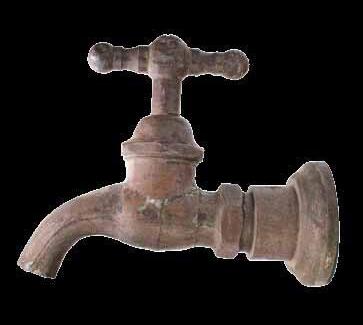
505 Early wooden oyster bucket. From R.R. Higgins and Co, Boston. Company’s stencil and number 134 on front. Original iron hardware. Measures 11” tall, 12” wide. Old crusty paint appears original with some flaking to the primer coat; paint on lid has mostly flaked to bare wood minor separation to staves.
Provenance: Dan Graf collection. (500 - 800)
506

507
Unknown maker, Pennsylvania, 1st quarter 20th century. Three songbirds on carved wooden nest. Birds with relief feather carving and raised wingtips. Two with open beaks. Measure from 3” to 5” long. Mostly original paint with some areas of restoration; chips missing from wingtips and one tail feather; one eye is missing; tiny chip in tip of one beak; reglued chip in another.
Provenance: Tom Karras collection. (300 - 500)
Unknown maker, Pennsylvania, circa 1900. Nicely carved and painted songbird with slightly turned head and relief wingtip carving. Mounted to mushroom base. Typical of the PA/German style. Bird measures 4.25” long, stands 8.5” tall including base. Original paint protected under an old coat of varnish; professional bill and tail chip repair, touchup in that area.

Provenance: Tom Karras collection. (200 - 300)

508 Unknown maker, Pennsylvania, circa 1900. Five songbirds on mushroom base. All the birds with slightly turned heads, four with relief wingtip carving and the other with outstretched wings. Measure from 3” to 4.5” long. 11.25” tall including base. Original paint with minor wear; early coat of varnish has darkened with age; fine crazing throughout; scattered touchups and repairs; tiny chip on the edge of one tail.
Provenance: Tom Karras collection. (600 - 900)
509 Unknown maker, 20th century, Pennsylvania. Full-size eurasion jay on large fungus. Slightly turned head and relief wingtip carving. Mounted to hang on wall. Jay measures 12” long, 13” tall including fungus. Original paint with a few small rubs; tight cracks in jesso thighs and feet otherwise very good structurally. (1,000 - 1,400)



510 Herters Decoy Factory, Waseca, Minnesota. Balsa owl with large glass eyes and bear claw bill. Stands 18” tall. Original paint with very minor wear; flaking to paint on legs; otherwise excellent.
(1,500 - 2,500)
511 Herters Decoy Factory, Waseca, Minnesota.
Rare cloth owl with bear claw bill and large glass eyes. Lithographed canvas is stuffed with straw. With wooden dowles inserted in to legs. Measures 20” long. Cloth has darkened with age; a few small tears and holes in canvas; some roughness on the edge of one ear tuft.
(1,200 - 1,800)
512 Smokey Joe Jackson, Mt Pleasant, Michigan. Decorative pheasant with outstretched wings and raised tail. Laminate construction with relief wing feather carving. Applied metal legs. 26.5” tall, with a 25” wingspan. Original paint with very minor wear; under a thin coat of varnish; tips of two wing feathers are missing; another was cracked and reset; one leg is missing; one toe on other leg is missing.
Provenance: Len Carnaghi collection. (800 - 1,200)


513 Samuel A. Bobb, New York, New York, last quarter 19th century. Cigar store Indian trade sign of a chief or scout. One arm extended overhead and the other arm holding two tobacco items. Relief carved fur draped over shoulders and nicely carved full headdress. Mounted with one leg stepped up in front of the other. All atop a heavy cast iron base. Measures 72” from floor to top of headdress. All mellowed nicely. Appealing early paint, some of which may be original; crazing and areas of flaking; right arm appears to be a very early replacement. (10,000 - 15,000)


514 Grenfell Labrador Industries. Woven mat of flying ducks with black border. Professionally matted to frame. Measures 38.5” x 36.5”. Grenfell Label stitched to back. Minor fading and discoloration from age, otherwise very good.
(600 - 900)

515 Grenfell Labrador Industries. Woven mat of flying mallards with yellow and black border. Professionally matted to stretcher. Measures 36” x 38”. Very good and original. (1,200 - 1,800)
516 Gert Olsen (Danish/ American, b.1937). Mid-century modern style bear carving. Made of four laminated pieces of hardwood. Marble base with hardwood bottom board that is signed and dated ‘80. Measures 26” long, stands 16.5” tall. Hairline separation to center body seam along underside, otherwise excellent. (600 - 900)
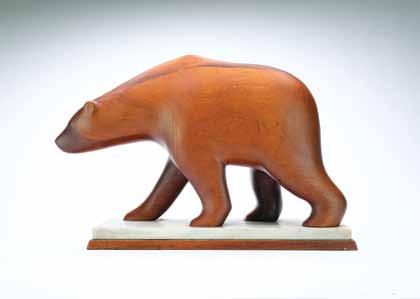



517 Attributed to Joseph Romuald Bernier (1873-1952), Biddeford, Maine. Standing spread wing hawk or immature eagle. Deep relief feather carving on body, tail, and underside of wings. Tops of wings are smooth. Open beak appears to have once held a fish or other carving that was screwed into sides of bill. Measures 21” long, with a 34.5” wingspan. 22” tall including base. Original paint with appealing crazing under a fairly thick coat of later varnish; body was made from two pieces of wood with slight separation at seam; minor chipping on undersides of wings where they attach to body; old chips at the tips of open beak.
(1,200 – 1,800)
518 Unknown maker, circa 1930s. Carved cow and calf. Applied horns, tails, and udder. Measure 10” and 4.25” long. Original paint with minor wear; small chip in tip of one horn; chips in ears with one on cow being repaired; some flaking to filler where one horn meets head.
(300 – 500)
519 Unknown maker, mid 20th century, Maine. Folky gull with outstretched wings and metal legs. Incised feather carving on wings and tail. Measures 14” long, 17.75” tall. Original paint with very minor wear; a few shallow chips on top of tail; otherwise very good structurally.
(500 - 800)
520 John Fliegerbauer (1909-1992), Altoona, Pennsylvania. Standing racing pigeon. Wide body with relief wing carving. Identified, signed, and dated 1973 on edge of base. Measures 13.5” long, stands 11” tall. Original paint with very minor wear; some restoration to jesso feet where legs join the base.
(500 - 800)
521 Carved prancing horse. With leather bridle, animal fur mane, and applied metal horse shoes. Measures 22” long, stands 19.25” tall. Original paint under an early coat of varnish has darkened slightly; chip in one ear; glue visible where tail attaches to body; thin paint touchups around head and rear end; modern tiger maple base.
Provenance: Gene and Linda Kangas collection. (600 - 900)


522 Early 20th century pull toy in the shape of a turtle. Four early brass wheels. Carved detail on legs and head. Measures 27” long. Original paint with some chips missing paint and wear from use; hole drilled in top of back which may have held handles.
Provenance: Al Marzorini collection. (600 - 900)






523 Madison Mitchell (1901-2003), Havre de Grace, Maryland. Pair of flat bottom pintails. Hen with slightly turned head. Drake is unsigned. Hen is signed and dated 1977 in electropen on one side. Measure 18” and 17.25” long. Original paint with very minor rubs; fine hairline crack in drake’s neck; hairline separation at a knot in one side of hen.
Provenance: Purchased from the maker.
Bobby Lewis collection. (500 - 800)
524 Madison Mitchell (1901-2003), Havre de Grace, Maryland. Pair of widgeon. Drake with slightly turned head, unsigned. Hen is signed and dated 1980 in electropen. Measure 14.5” and 15” long. Area of discoloration above a knot in drake; otherwise excellent.
Provenance: Purchased from the maker.
Bobby Lewis collection. (500 - 800)
525 Madison Mitchell (1901-2003), Havre de Grace, Maryland. Pair of greenwing teal. Both are signed in electropen. Measure 12.25” and 13.25” long. Tiny paint flakes at one of hen’s wing patches; hairline crack in one side of drake’s neck seat; otherwise excellent.
Provenance: Purchased from the maker.
Bobby Lewis collection. (500 - 800)
526 Madison Mitchell (1901-2003), Havre de Grace, Maryland. Pair of buffleheads. Drake with slightly turned head is signed and dated 1974 in electropen. Hen is signed and dated 1972. Measure 14.25” long. Hairline crack along the underside of each, otherwise excellent.
Provenance: Purchased from the maker.
Bobby Lewis collection. (500 - 800)
527 Madison Mitchell (1901-2003), Havre de Grace, Maryland. Pair of mallards with slightly turned heads. Drake is signed and dated 1956 in electropen. Hen is signed and dated 1966 in ink. Measure 16.25” long. Drake with hairline crack at a knot in one lower side; otherwise excellent.
Provenance: Purchased from the maker.
Bobby Lewis collection. (500 - 800)
528 Madison Mitchell (1901-2003), Havre de Grace, Maryland. Pair of canvasbacks. Both are signed and dated in electropen. Hen 1954, drake 1955. Measure 16.25” long. Original paint with very minor rubs; a few hairline cracks on back of hen.
Provenance: Purchased from the maker. Bobby Lewis collection. (500 - 800)
529 Madison Mitchell (1901-2003), Havre de Grace, Maryland. Pair of goldeneye. Drake with slightly turned head. Both are signed and dated 1972 in electropen. Measure 14” long. Very minor rubs on drake; hairline separation at back of each neck seat.
Provenance: Purchased from the maker.
Bobby Lewis collection. (500 - 800)
530 Madison Mitchell (1901-2003), Havre de Grace, Maryland. Pair of bluewing teal. Drake with slightly turned head. Both are signed and dated 1958 in electropen. Measure 12.75” long. Tight crack through each neck, otherwise excellent.
Provenance: Purchased from the maker.
Bobby Lewis collection. (500 - 800)
531 Madison Mitchell (1901-2003), Havre de Grace, Maryland. Pair of redheads. Both are signed and dated in electropen; drake 1952, hen 1957. Measure 14.75” long. Hairline crack on underside of hen; area of discoloration on underside of each; otherwise excellent.
Provenance: Purchased from the maker. Bobby Lewis collection. (500 - 800)
532 Madison Mitchell (1901-2003), Havre de Grace, Maryland. Rigmate pair of bluebills. Unsigned. Measure 14” long. Original paint with very minor wear; light separation at a knot in one side of hen; otherwise excellent.
Provenance: Purchased from the maker.
Bobby Lewis collection. (500 - 800)








533 Taylor Boyd (1856-1946), Perryville, Maryland. Canvasback with slightly raised neck seat. Measures 15” long. Early in use repaint with moderate flaking and wear; lightly hit by shot; crack through neck was tightened with three old nails; roughness on edge of tail.
(400 - 600)
534 Ben Dye (1827-1896), Perryville, Maryland. Small redhead or bluebill. Measures 12.25” long. Old paint has worn mostly to bare wood with a coat of varnish that has darkened with age; small dents and shot marks; minor roughness on edge of tail and bill; head is slightly loose;area of dry rot on the underside.
(600 - 900)
535 Unknown maker, Susquehanna River area, Maryland. circa 1900. Canvasback with slightly raised neck seat and hard chine line around body. Measures 13.75” long. Early in use repaint; with moderate crazing and wear; small dents and shot marks; minor roughness on edge of bill and top of head; slight separation at neck seat.
(800 - 1,200)

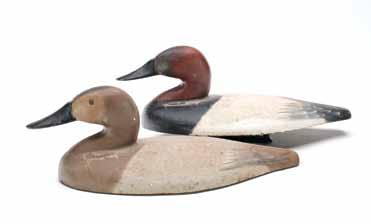

537 Charlie Joiner (1921-2015), Chestertown, Maryland. Pair of hollow cast iron canvasback wingducks. Signed by the maker on each lower side. Measures 15.25” long. Original paint with minor flaking, otherwise excellent. (400 - 600)
538 Unknown maker. Pair of vintage cast iron wingducks. Canvasbacks with thin bodies. Measure 14.25” long. Original paint with very minor discoloration and wear. (400 - 600)
539 Unknown maker, Maryland. Canvasback hen cast iron wingduck. Measures 14” long. In use repaint by Robert McGaw with minor flaking and wear. (400 - 600)



540 Unknown maker, 20th century, Maryland. Canvasback cast iron wingduck. With relief eyes. Measures 15.5” long. Doesn’t appear to have ever been painted; very good structurally. (400 - 600)
541 Unknown maker. Cast iron sinkbox decoy of a brant. Probably from North Carolina. Retains old paint with heavy flaking that has stabilized. Steel and rust are exposed in areas where paint is absent; tip of bill is missing. Measures 16” long. (300 - 500)
542 Unknown maker. Cast iron sink box decoy. Painted as a widgeon. Has string hole in back of tail. Measures 14” long. (400 - 600)
End of session two
Aamodt, Ernie 464-469
Andress, Ray 360-363
Andrews, Ambrose 438
Andrews, Robert ........................................................................ 121
Bach, Ferdinand ........................................................................ 263
Bailey, Clarence 22,175
Barton, Roger 423-426
Baumgartner, Frederick 35
Best, James 134A
Binks, Reuben Ward 444
Birch, Reggie .............................................................................. 399
Blair, Sr., John 205
Borrett, Mike 400
Bowman, William 198
Boyd, George 60-76,190,191,381-398
Boyd, Taylor 533
Braddock, Lester ........................................................................ 153
Brewer, Josh ........................................................................ 404,405
Bruning, Ken 484
Burleigh Brothers 369
Caines Brothers 135
Chadwick, Keyes 11-15
Chambers, Thomas 354,355
Clark, Charles ............................................................................ 126
Clark Family 368
Clifton, Richard 447
Cobb, Elkanah 122
Coombs, Frank 322
Cooper, William 370
Crowell, A. Elmer 2-7,23,24,26-28,42,77-94,178-180,372-378
Cuffee, Chief Eugene ............................................................... 201
Dennis, William Frank 176
Denny, Sam 324-326
Ditmann, A.J. 379,380
Douglas, Rosh 329,367
Dye, Ben 534
Eastman, Willie ........................................................................ 166A
Eaton, Eben Weed .................................................................... 166
Ellis, Billy 366
Elliston, Robert 222
Fabens, Captain Samuel 36
Family, Reeves 351
Faue, Otto 471
Faue, William ................................................................ 470,472-475
Finney, Frank 136-144,256-262
Fliegerbauer, John 520 Folger Family 29
Foote, Jim
Foster, Alonzo 188
Foster, William Harnden .............................................................
Fulcher, Mitchell ........................................................................
Garbaldi, Amiel
Gelston, Thomas 189,199
Gibian, William 149,413-417
Gilley, Wendell 173A
Glassford, Al 427,428 Goebel, William 448 Graves, Bert 217,218,220,221
Quillin, Nate 264
Quinn, William 207
Reghi, Ralph 296
Reid, Don ................................................................................... 357
Reneson, Chet ........................................................................... 443
Robb and Company 513
Rogers, Gus 317,321,323,327
Ross, Willie 174
Savary, Walter 45
Sawyer, Chet 459,460
Schmidt, Benjamin .............................................................. 280-294
Schmiedlin, Jim 420
Schoenheider, Sr., Charles 211
Schroeder, Dennis 418
Schroeder, Tom 265-279
Schultz, William 422
Schweikart, John ....................................................................... 297
Shirtz, Ed ..................................................................................... 210
Shourds, Harry V. 206
Sinnett, Everette 172
Slechta, Charles 479-482
Smith, Brett 441
Snyder, Ed 457
Stanley, James 364
Sterling, Noah 117
Stotz, Raymond 476,477
Strunk, George .................................................................... 406-411
Titcombe, William Henry ............................................................ 437
Trinosky, Hermon R. 208A
Verity, Andrew 187
Verity, Obediah 184-186
Voorhees, Clark 230,231
Walker, Charles 213,214,219
Wallace, Irving ........................................................................... 165
Walter, G. 419
Ward, Lem 110,111
Ward Brothers, 99-108 Warin, George 352
Weaver, Steve 152
Webster, Franklin Folger ................................................................ 8
Wheeler, Charles E. “Shang” .................................................... 181
Wheeler, Chauncey 316,318-320
Whitaker, George William 440
Wilson, Augustus “Gus” 167,168,173
Wozny, Eddie 145-148
Wright, Alvirah 133









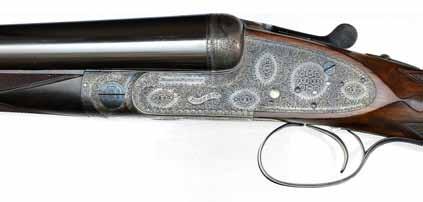

We are excited to announce the release of a new hard cover book that captures details of the 2024 sale of the Alan and Elaine Haid decoy collection.
The book shares the moments from the time this important collection was in the Haid’s home until they were sold in our 2024 live auctions. It includes comments and auction reviews from Decoy Magazine’s Joe Engers and Antiques and the Arts Weekly’s Rick Russack, as well as extensive carver profiles of the decoys that were sold.
This 220+ page hardbound book is $100 and is only available to those that preorder a copy. Contact our office for details and to order this comprehen sive recap of one of the most important decoy collections to ever be sold at auction.












A single artist show by Cameron McIntyre
December 6, 2025 at the
Guyette & Deeter gallery St. Michaels, Maryland



Exhibit will run from November 15 through December 7. It ems will go on sale December 6.









Top Image: “Down the Road” Watercolor
2025 Featured Artist, Al Barker
Waterfowl Festival






BOOK TO BE LAUNCHED FOR PUBLIC SALE AND EXHIBIT TO OPEN ON AUGUST 1, 2025 - FEATURINGDecoys from the Peterson Collection

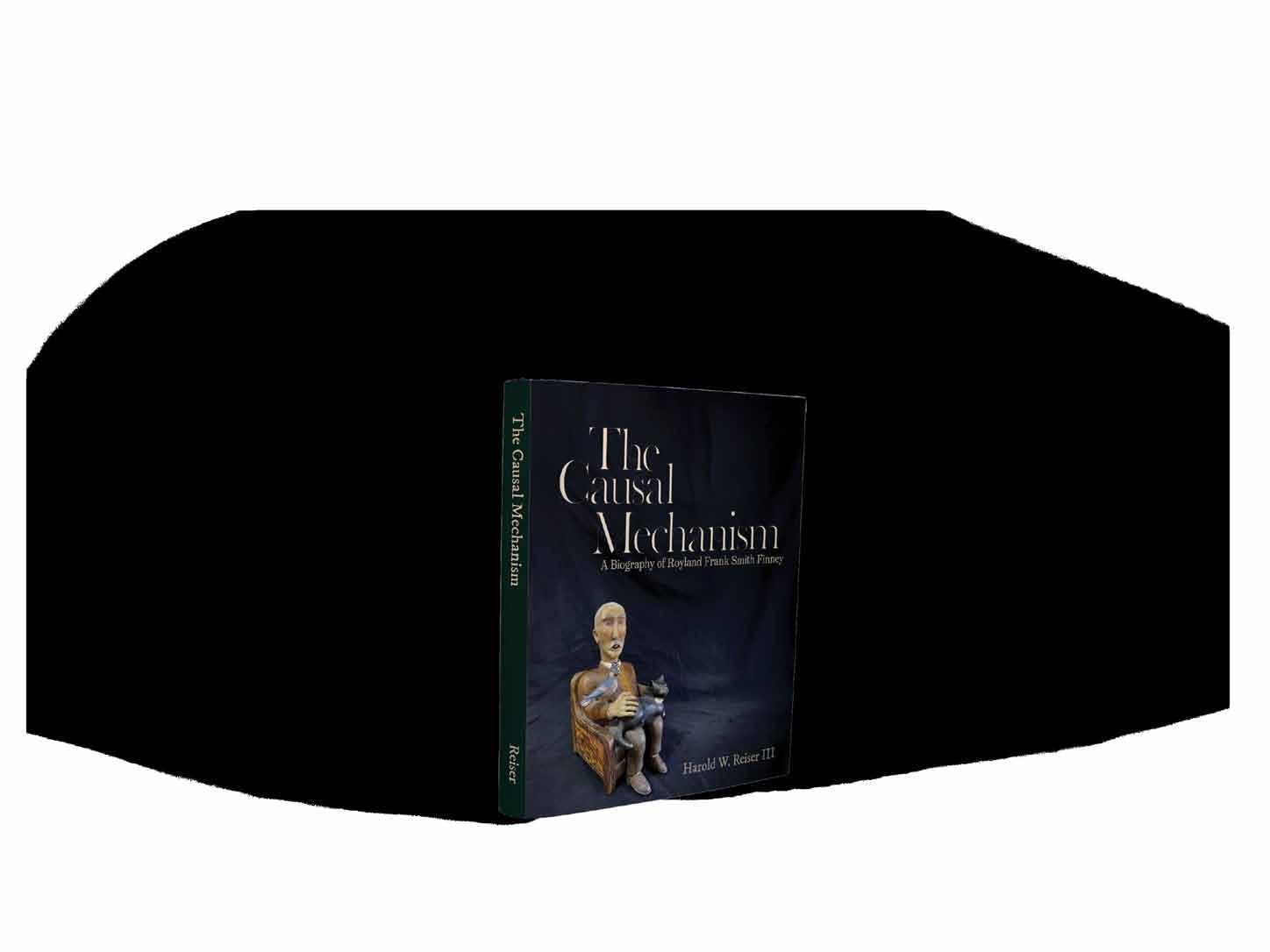



THROUGH FRIENDSHIP, SCHOLARSHIP & FUN!



BSupporting collectors and the decoy community for nearly 30 years!
E PART OF one of the most active decoy-collecting clubs in the country! Join our celebration of decoys old and new, preservation of decoy and waterfowling history, support for decoy museums, public education efforts, club meetings, virtual decoy contests, friendship and fun. We would love to have you as a fellow member!
Dues are just $35 for two years that includes the following benefits:
, Our acclaimed club newsletter, The Potomac Flyer
, Monthly meetings and educational decoy display contests
, Special presentations, educational sessions, and decoy museum tours
, Listing in our annual club membership directory
, Tips and advice on collecting and carving from members of the club
, Member preference and table discounts at our annual Annapolis Decoy Show
, Pride in our code of ethics and awards recognizing those giving back to the decoy community
, Know that your dues support the museums and institutions preserving decoy and waterfowling history and celebrating the heritage and traditions of decoy making!
For more information or to join: chad.tragakis@gmail.com • (703) 593-3024


• Black anodized aluminum construction.
• Rubber padded tops & bottoms. Will not mar your furniture or decoys.
• 3 post and 4 post styles to choose from.
• 1 in to 4 in heights in 1/4 in increments
Sizes and Colors Upon Request $30 each plus shipping and handling
order call Ken Cole at: (810) 845-2434 E-mail: kencole3@aol.com Or write to:

1. GUARANTEE ‑ We have made a concerted effort to accurately catalog and describe the property to be sold. The decoys have guaranteed condition reports. Should the need arise, the auctioneer reserves the right to make verbal corrections and provide additional information from the podium at the time of the sale. Since opinions can differ, particularly in the matter of condition, the auctioneer will be sole judge in the matter of refunds. If we fail to identify a flaw that has a significant impact on the value, you can return the decoy.
2. DURATION OF GUARANTEE ‑ Requests for a refund on an item purchased through a Guyette and Deeter, Inc. auction must be made within 3 days of the time you take physical possession of your purchases. Whether your items are shipped, delivered, or picked up at the auction site, it is still 3 days from date of possession. This guarantee is null and void if payment is received or mail is postmarked more than 14 days from the sale end date. The guarantee is also null and void if you choose to not take possession of your purchases within the 30 days. If you have paid for your purchases within the 30 days but Guyette and Deeter, Inc is unable to ship your item within the guarantee period, the guarantee will be extended until 3 days from the shipping delivery date.
3. PROTESTED BIDS ‑ In the case of a disputed bid, the auctioneer is the sole determinant as to who the success ful bidder is, and at his discretion, may reoffer and resell the article in dispute. If a dispute arises after the sale, the auctioneer’s sales records shall be conclusive as to who the purchaser was, and the purchase price.
4. BIDDING BIDDING Bidding usually starts below the low estimate and advances in increments of approxi mately 10% of the opening bid subject to the auctioneer’s discretion. The auctioneer reserves the right, at his sole discretion, to refuse any bids that he deems unreasonable. The minimum bid increment guideline is as fol lows:
$500 to $1000 $25 $10,000 to $20,000 $500 $100,000 and above $2,000
$1000 to $10,000 $100 $20,000 to $100,000 $1,000
5. ABSENTEE BIDS ‑ Phone or mail bids, at the discretion of the Auctioneer, will be accepted with a 20% deposit. In such case, the auctioneer will execute such bids competitively. Absentee bids are executed by the auctioneer on behalf of the bidder in accordance with the bid increment policy shown above.
6. TERMS ‑ All items are to be paid for in U.S. funds. No items will be released until they are paid for. The Auctioneer reserves the right to hold merchandise paid for by personal check, until the check has cleared the bank. PAYMENT IS DUE UPON RECEIPT. A late charge will be accessed on all balances not paid, at the rate of 12% A.P.R. commencing 30 days after the auction. Merchandise not paid in full withing 30 days will be con sidered unsold.
7. PAYMENT FOR PURCHASES CAN BE MADE WITH CREDIT CARD (VISA, MasterCard, American Express, or Discover), CASH, CHECK, OR WIRE TRANSFER.
8. BUYERS PREMIUM The buyer’s premium, assessed on each selling lot, is 20% of the hammer price up to and including $1,000,000. For payments made using a credit card, the buyer’s premium is 23% up to and including $1,000,000.
9. TAX ‑ THERE IS AN 6% SALES TAX IN MARYLAND. TAX IS WAIVED IF BUYER PRESENTS A VALID RESALE CERTIFICATE FROM ANY STATE OR HAS PURCHASES SHIPPED OUTSIDE OF MARYLAND.
10. ACCEPTANCE OF CONDITIONS ‑ Bidding on any articles in this sale indicates your acceptance of all of the conditions of sale.
11. BIDDING AGENT RESPONSIBILITY ‑ If you are registering for someone or if you execute a bid for someone else under your number, you are responsible for the settlement of that account. You are also responsible for examining the items for your client regarding the guarantee.
12. WITHDRAWAL ‑ We reserve the right to withdraw any property before the sale and shall have no liability whatsoever for such withdrawal.
13. TITLE ‑ Title passes upon the fall of the auctioneer’s hammer. It will then be the responsibility of the buyer to make full payment, according to terms and conditions, prior to removing the goods from the premises. Removal is at the buyer’s risk and expense and must be made at the conclusion of the sale, unless other arrangements are made with the Guyette & Deeter.
14. LEGAL DISPUTE ‑ Any legal disputes arising from this auction shall be settled in the court system of the State of Maryland. UNIFORM COMMERCIAL CODE ‑ The Maine Uniform Commercial Code, Title II, Section 2328 applies to this auction.
15. Stands are not included with the decoys or weathervanes unless specified in catalog. Cases are not included with shotgun shell boxes. All dimensions are approximate and are not guaranteed. All calls are sold “As Is”.
16. Under no circumstances will we be responsible for damage to frames or glass, or damage caused by them. Paintings determined to be of high value or large size may be subject to special packaging or special delivery at the buyer’s expense. Under no circumstances will we be responsible for damage to fragile decorative carvings. These items are marked in the catalog with an *. THE OFFICE WILL NOT
1. Absentee bids are a service provided to our customers free of charge. Every effort is made to execute all absentee bids, however, in the event of an error or omission, or failure to properly execute absentee bids, the Auctioneer shall not be held liable.
2. All absentee bids must be accompanied by a 20% deposit, which will be refunded immediately after the auction if your bid is unsuccessful. If your bid is successful, the deposit will be applied to the purchase price and the balance due upon presentation of your bill. All absentee bidders are notified by mail, whether successful or unsuccessful.
3. Visa and Mastercard numbers can be given in place of a check deposit, if your bid is submitted by phone. Your card number will not be used to make payments for purchases, it is only used as collateral. Your card number will only be used to make payment for purchases if you default on payment.
4. To execute an absentee bid, fill out the enclosed form listing catalog number, description, and your top bid price (not including the 20% buyer’s premium). Send this together with your deposit as soon as possible. If your bids are sent seven days or less prior to the auction, you should call our office three days prior to the auction, to confirm that we have received your bids. If they have not been received at that point in time, we will take your bid over the phone. We cannot guarantee that bids received after the auction has started will be executed.
5. If two or more bids are received on the same item from different people, the bidding will open at the next logical raise above the second highest bid. If two absentee bids are received with the exact same amount, the first one received will take precedence.
6. All bids must be in even dollar amounts. Bids in fractions of dollars will be considered the next lower even dollar amount.
7. Bid increments: The bid increment policy, which also applies to both absentee and phone bidders, is listed under “CONDITIONS OF SALE” (item #4), in the front of the catalog.
8. Open bids, bids with no set top amount, or orders to just simply buy the lot, cannot be accepted. You must have a definite top limit before we can execute your bid. Alternatives to this are as follows:
a. To bid over the telephone. This can be done by simply sending a 20% deposit for what you wish to bid on the object. This will bind whatever bid amount you wish to bid over the telephone. (NOTE: There are only 8 phone lines into the auction room and phone bids will be handled on a first come, first serve basis.)
b. Some bidders concerned that a lot might just go for one bid above their top limit, leave a top bid plus one bid. This works as follows: the top bid submitted might be $1,000, but not wishing to lose the lot for simply $25 more, the party might bid $1,000 + 1 bid if they definitely don’t want to go over a certain price, they would indicate $1,000 +1 ($1,025) (NOTE: One possible problem that occasionally arises with absentee bids is when someone in the audience bids exactly the amount, which you specify is your limit. In such a case, we would not go one extra bid unless your bid sheet indicates “plus one” bid.).
9. If you are a successful bidder, a bill will be sent a few days after the auction. Purchasers should indicate their desired method of shipment, if such is necessary. There is a charge for shipping, labor, materials, and insurance. Please provide notice in writing if items are covered under your own insurance policy. Shipping is done on a first come, first serve basis, and can take up to 4 weeks. Please note that a certified check, Visa, Mastercard, or any other form of guaranteed funds will expedite shipping.
10. For expensive oil paintings and delicate carvings, we need a written statement from the purchaser, assuming the responsibility of pursuing any claims, in the event of damage incurred during shipping. Valuable lots need to be sent 2nd day air UPS due to values. Under no circumstances will we be liable for damage to glass or frames, or fragile decoratives, regardless of cause.
11. TERMS Phone and absentee bidders You will be notified one week after the auction of your results. Payment is due upon receipt. Interest will be charged on all balances not paid within 30 days after the bill is sent at the rate of 12% APR. If any accounts become more than 60 days overdue, the consignor will be given the name of the buyer who is responsible for holding up their funds. If an account is 75 days overdue, the items may be returned to the consignor and overdue buyer will pay the buyers premium and commission from the sale, if they wish to participate in future Guyette and Deeter auctions.
12. Bidding on any article(s) indicates your acceptance of these terms above.
13. If you would like any additional information on any of the lots, please contact: Jon Deeter at (440) 610-1768, or Zac Cote at (207) 321-8091. If you have any questions concerning absentee bids, please call us.
Zac Bookkeeper Computer Bid Builder
ADDRESS
DEPOSIT $
I Desire to bid on the following items in the sale. The bids are to be executed by Guyette & Deeter, up to but not exceeding the amount(s) specified on the below bids. All bids will be executed and accepted subject to the Terms of Sale and Absentee Bids Procedure outlined in the catalog. (Please be sure that you understand our procedures before using this Absentee and Phone Bid Form.) The office will not be open until Wednesday after the auction.
A premium of 20% will be applied to all items sold, to be paid by the buyer


